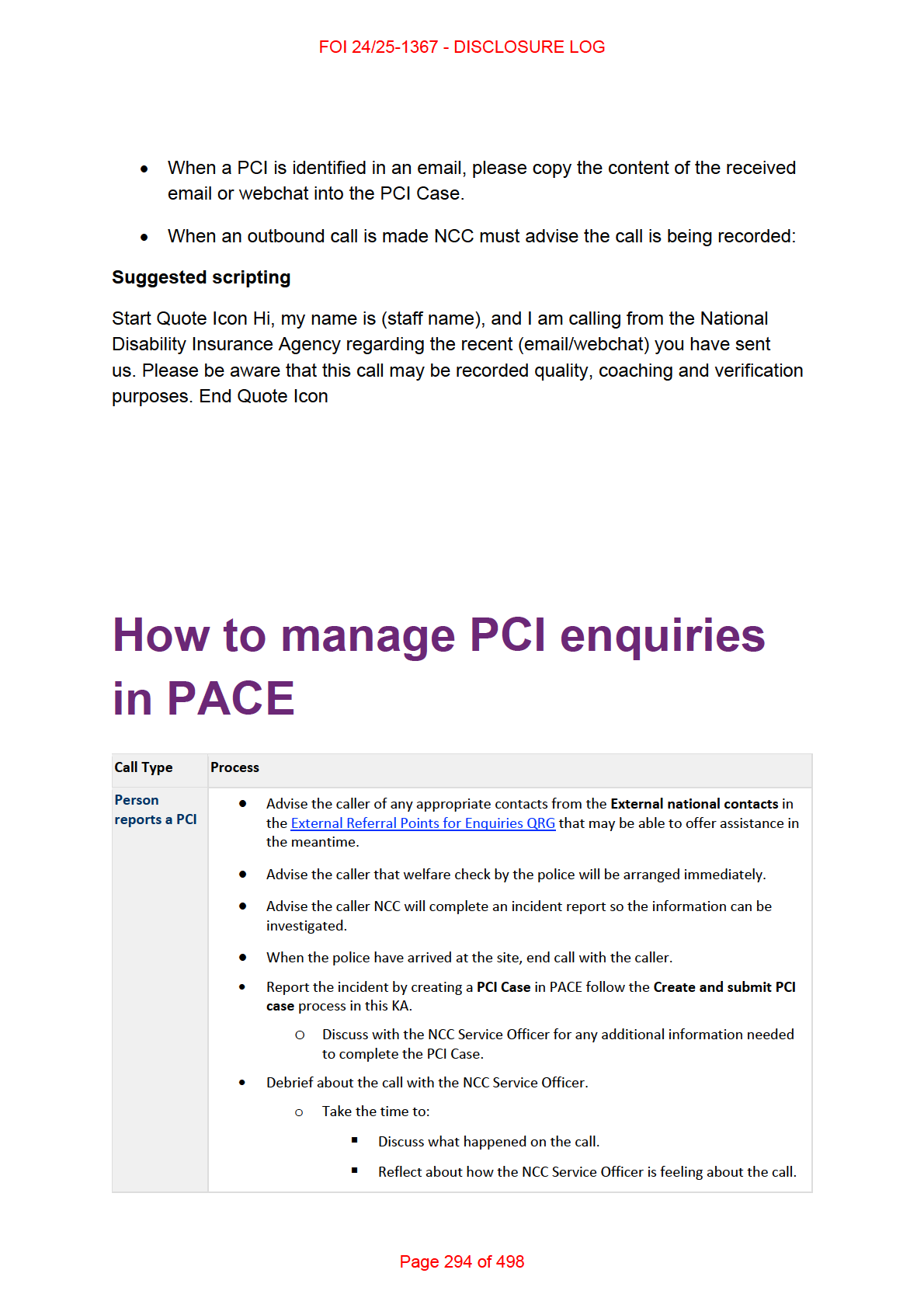
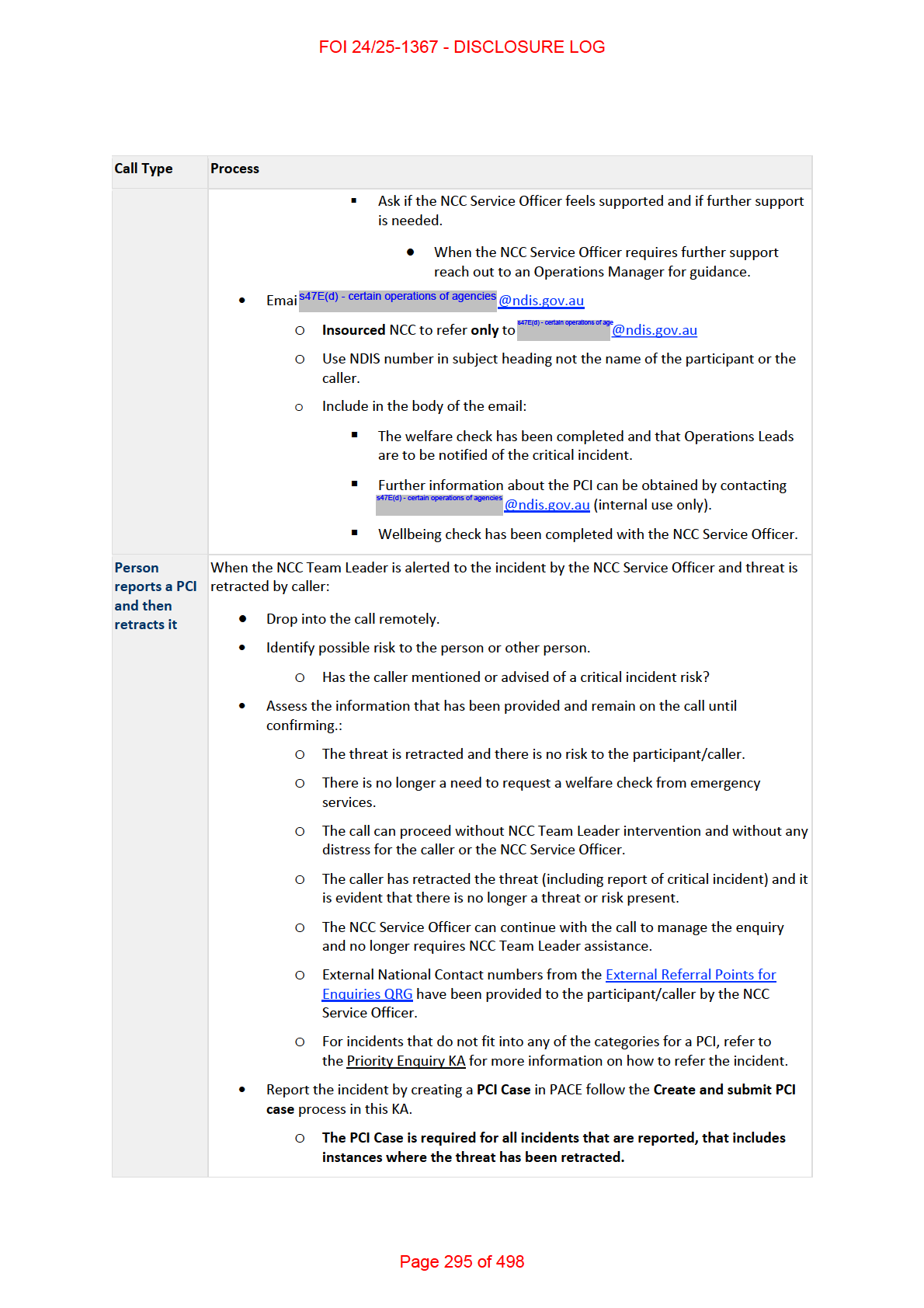
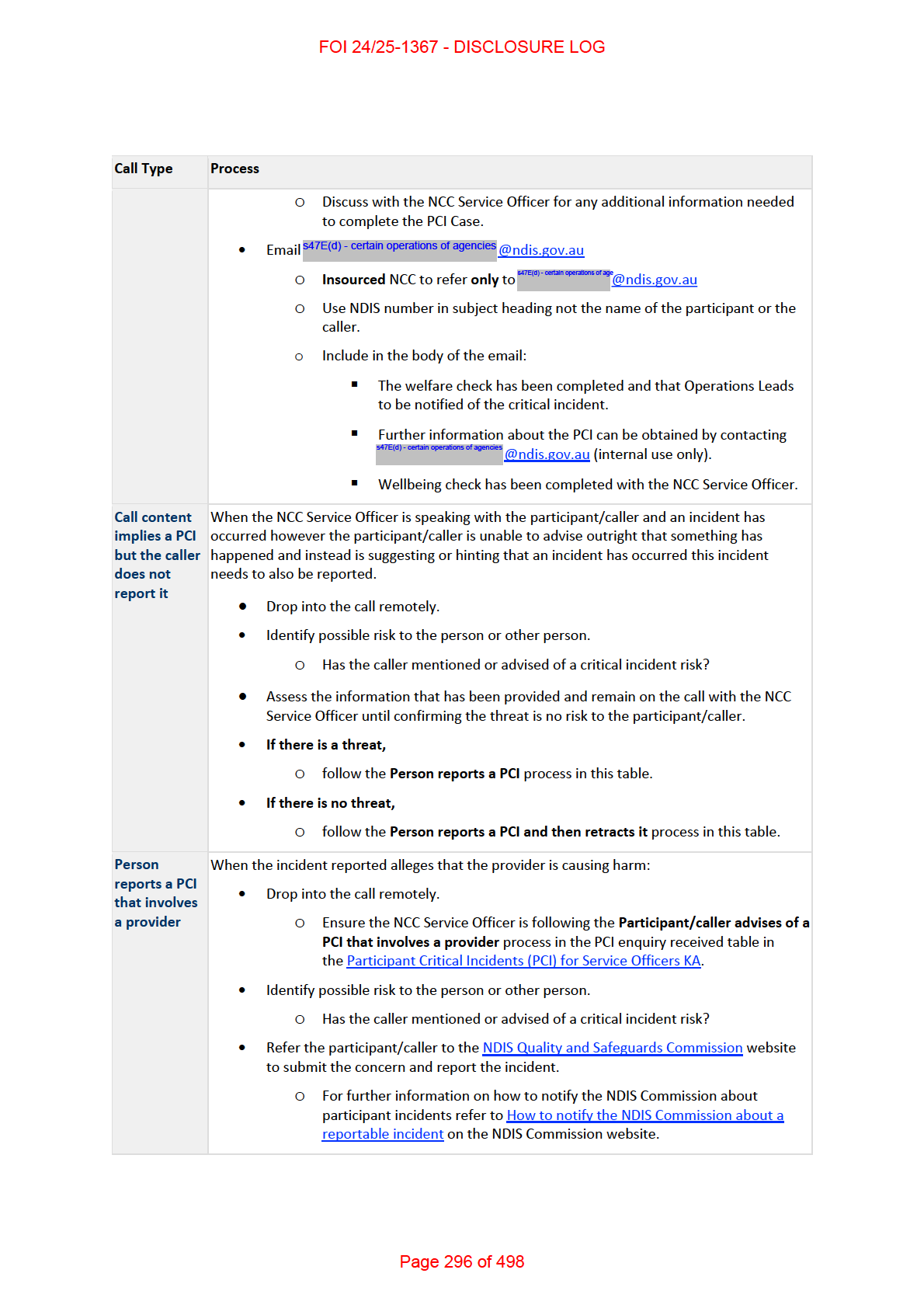
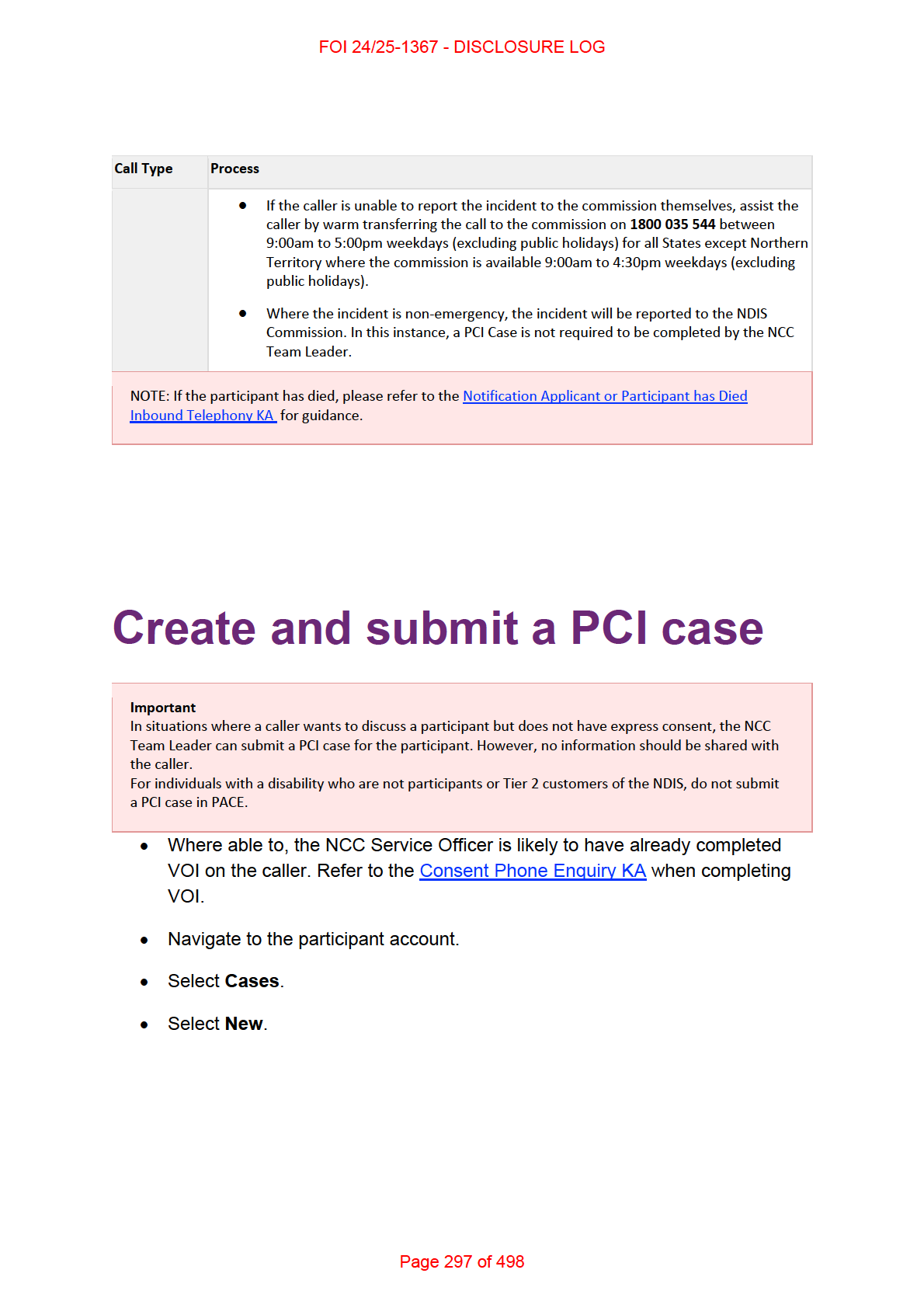
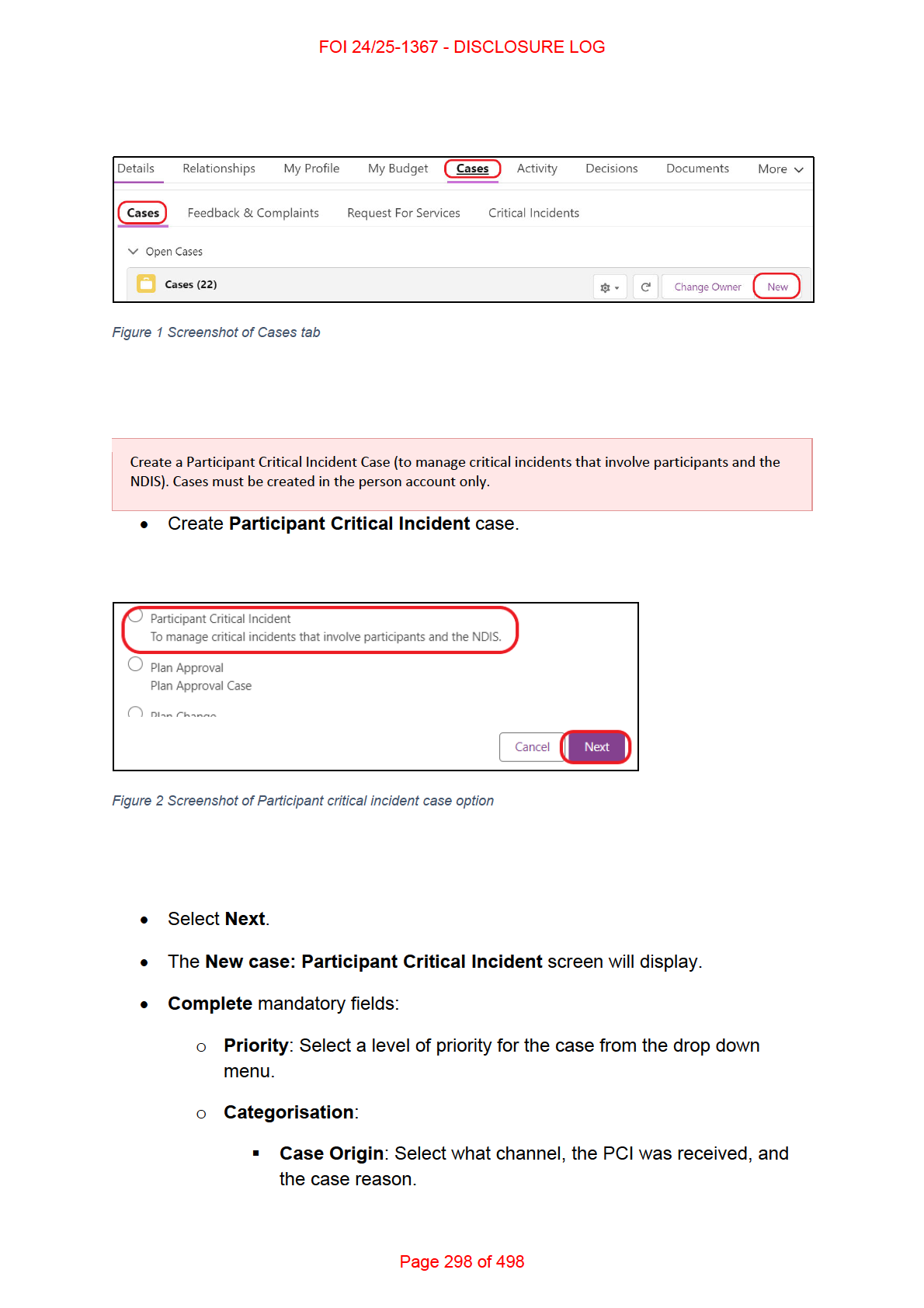
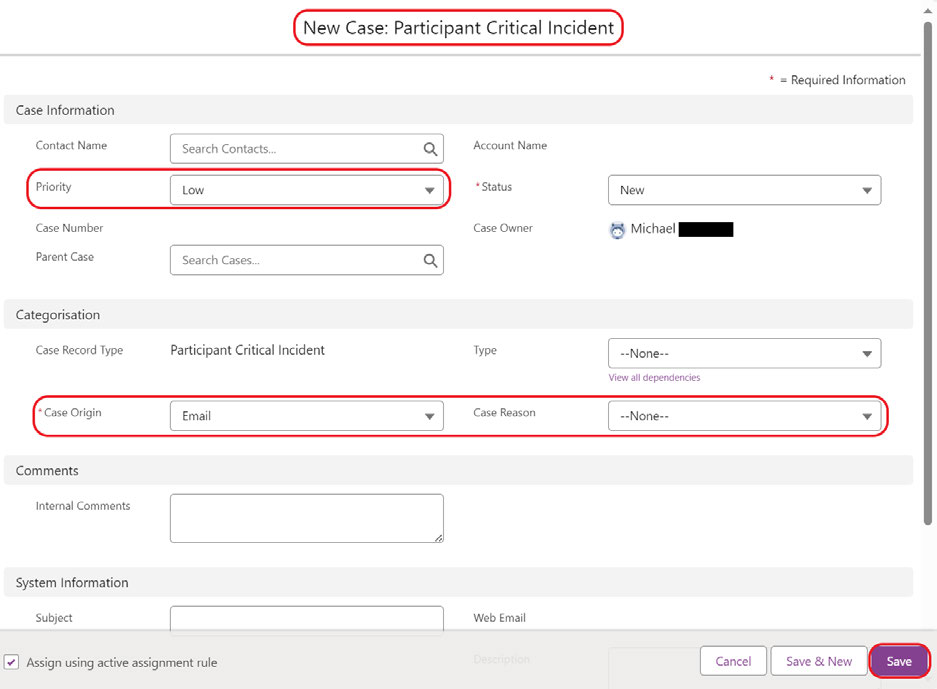
FOI 24/25-1367 - DISCLOSURE LOG
o
System information:
Subject: enter
Tier 2 incident
• Select
Save once the relevant fields have been addressed.
Figure 3 Screenshot of New PCI Case screen in pace
• Navigate to the
Participant Critical Incident tab.
• The
Trigger content warning screen wil display.
•
Does this report contain triggering content: Select you or no from the drop
down menu.
o Triggering content is content that may have a negative impact on
another person. This is where the content exposes someone with past
Page 299 of 498

FOI 24/25-1367 - DISCLOSURE LOG
trauma (experiences), to something that might cause a physical and/or
mental reaction for example, sexual violence.
• If
Yes: Select the type of triggering content from the drop down menu.
• Select
Next.
Figure 4 Screenshot of trigger content warning screen
• The
Incident summary screen will display.
•
Date and time incident reported to NDIA: Select the date and time when
incident was reported.
•
Do we know the date and time of the alleged incident? Select yes or no.
o If
Yes:
Enter the date and time the alleged incident occurred.
o If
No: Use the free text field to explain why this information is not
available.
•
Does the reporter wish to remain anonymous? Select yes or no.
o If
No: Complete the fields to record the reporter's details.
Page 300 of 498
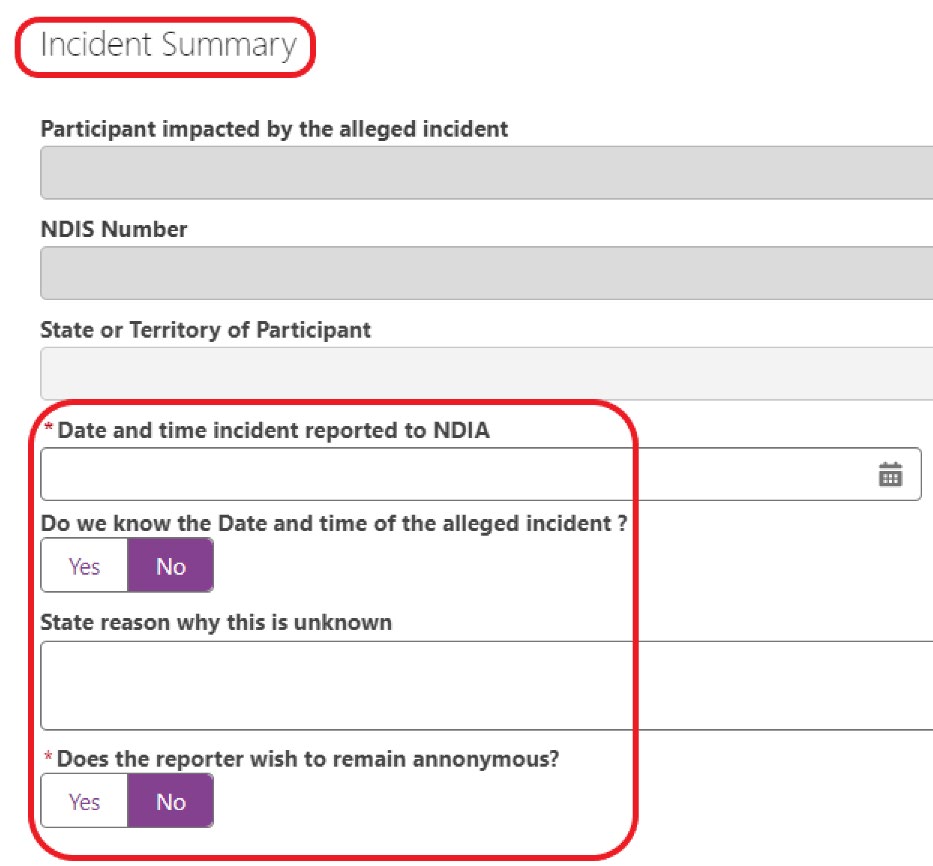
FOI 24/25-1367 - DISCLOSURE LOG
Figure 5 Screenshot of incident summary
•
Is the allegation in relation to a provision of services and supports?
Select yes or no.
o If
No:
Select
Next.
o If
Yes: Document the provider details.
If the provider details are available in PACE, select the provider
from the dropdown list once you start typing their name.
Page 301 of 498
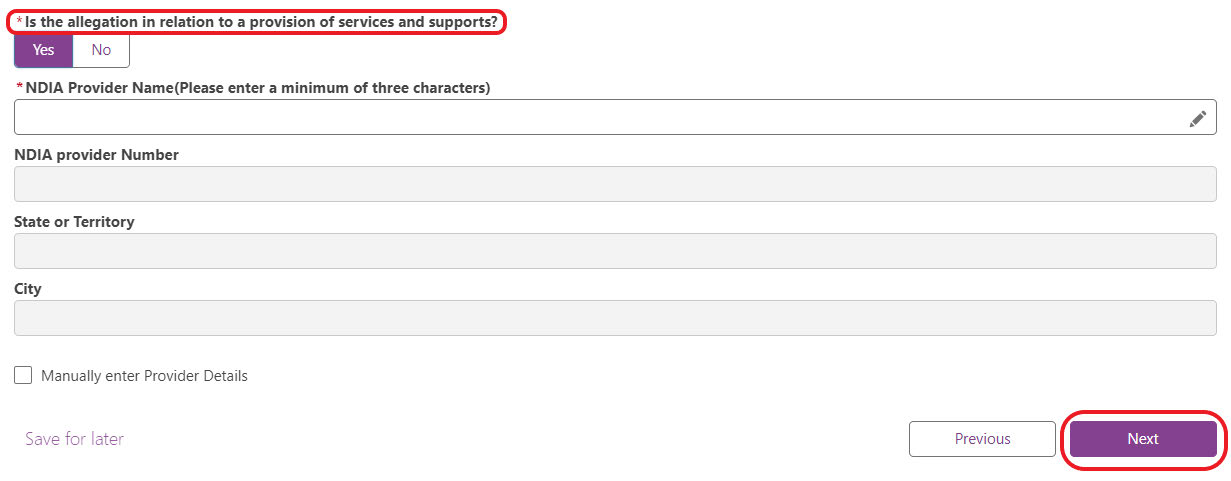
FOI 24/25-1367 - DISCLOSURE LOG
If the provider details are not in PACE, tick the box
Manually
enter provider details and enter the provider information.
•
o Select
Next.
NOTE: If the allegations are in relation to a provider, the NDIS Commission wil not
investigate without consent.
Figure 6 Screenshot of incident summary questions
• The
Incident category screen will display.
Page 302 of 498
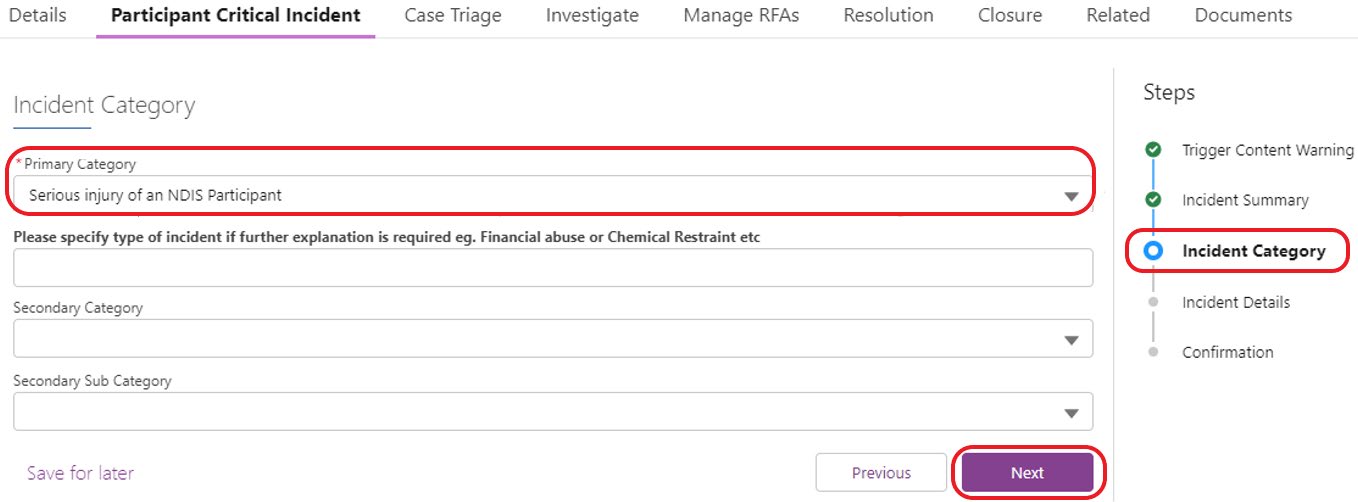
FOI 24/25-1367 - DISCLOSURE LOG
Figure 7 Screenshot of Incident category screen
• Select category
from the drop-down menu.
• Select
Next.
• The
Incident details screen wil display.
• Enter the details of the incident.
Page 303 of 498
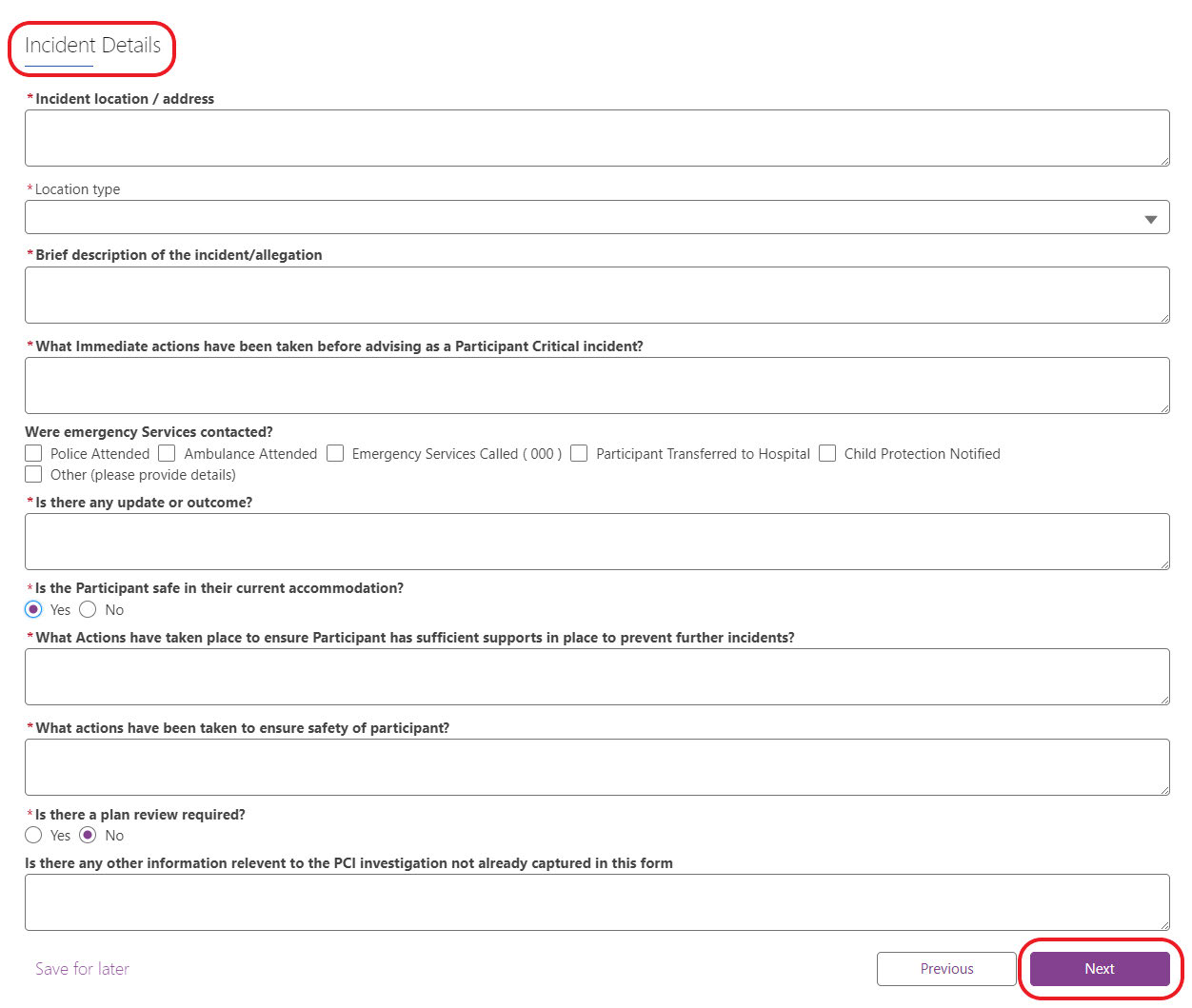
FOI 24/25-1367 - DISCLOSURE LOG
Figure 8 Screenshot of incident details screen
•
Incident location/address: Use the free text field to document the details of
the location.
•
Brief description of the incident/allegation: Use the free text field to record
all details and conversations regarding the incident. These details may vary
depending on the type and severity of the incident.
• Some of the key incident details to include in description notes are:
o Who is fil ing in the report.
o Who the NDIS participant is.
Page 304 of 498
FOI 24/25-1367 - DISCLOSURE LOG
o A description of what happened.
o The impact on the NDIS participant.
o Contact details for any witnesses.
o Any immediate actions taken to address the incident.
o Any follow-up actions planned or taken to prevent or minimise
recurrence.
o Any notifications made to other authorities or agencies.
•
What immediate actions have been taken before advising a PCI? Use the
free text field to document what actions have been taken.
•
Is there any update or outcome? Use the free text field to document
supports, safety information, any actions or outcomes.
•
Is the participant safe in their current accommodation? Select yes or no.
o If
No: Use the free text field to document any further details and
complete the following two questions in the report.
o If
Yes: Complete the following two questions in the report.
•
What actions have taken place to ensure participant has sufficient
supports in place to prevent further incidents? Use the free text field to
document what actions have been taken.
•
What actions have been taken to ensure safety of participant? Use the
free text field to document what actions have been taken including:
o Details of the welfare check (when and who completed the welfare
check). If no welfare check was completed, details about why not.
o If emergency services was called and any reference number give by
000, NCC Team Leader wil need to ask this on the call with the
Emergency Services Officer.
o That the incident has been reported.
o If a warm transfer to the NDIS Quality and Safeguards Commission
occurred.
•
Is there a plan reassessment required? Select
No.
Page 305 of 498

FOI 24/25-1367 - DISCLOSURE LOG
•
Is there any other information relevant to the PCI investigation not
already captured in this form? Use the free text field to:
o Leave an enquiry note using the
Critical incident reported enquiry
note template.
•
o When completing the enquiry note advise
who called unless the caller
wants to remain anonymous.
If the caller wants to remain anonymous, do not include any
identifying information when completing the PCI Case.
o The enquiry note should include all other
non PCI related discussions.
•
o Include, if the PCI was received on webchat or email, a copy of the
content received.
• Select
Next.
• The
Confirmation screen wil display.
Figure 9 Screenshot of confirmation screen
• Before selecting
Submit, confirm all relevant information has been
documented and the information is correct. If NCC Team Leader needs to
update any of the information,
• Use the
Previous button to review previous screens.
Page 306 of 498
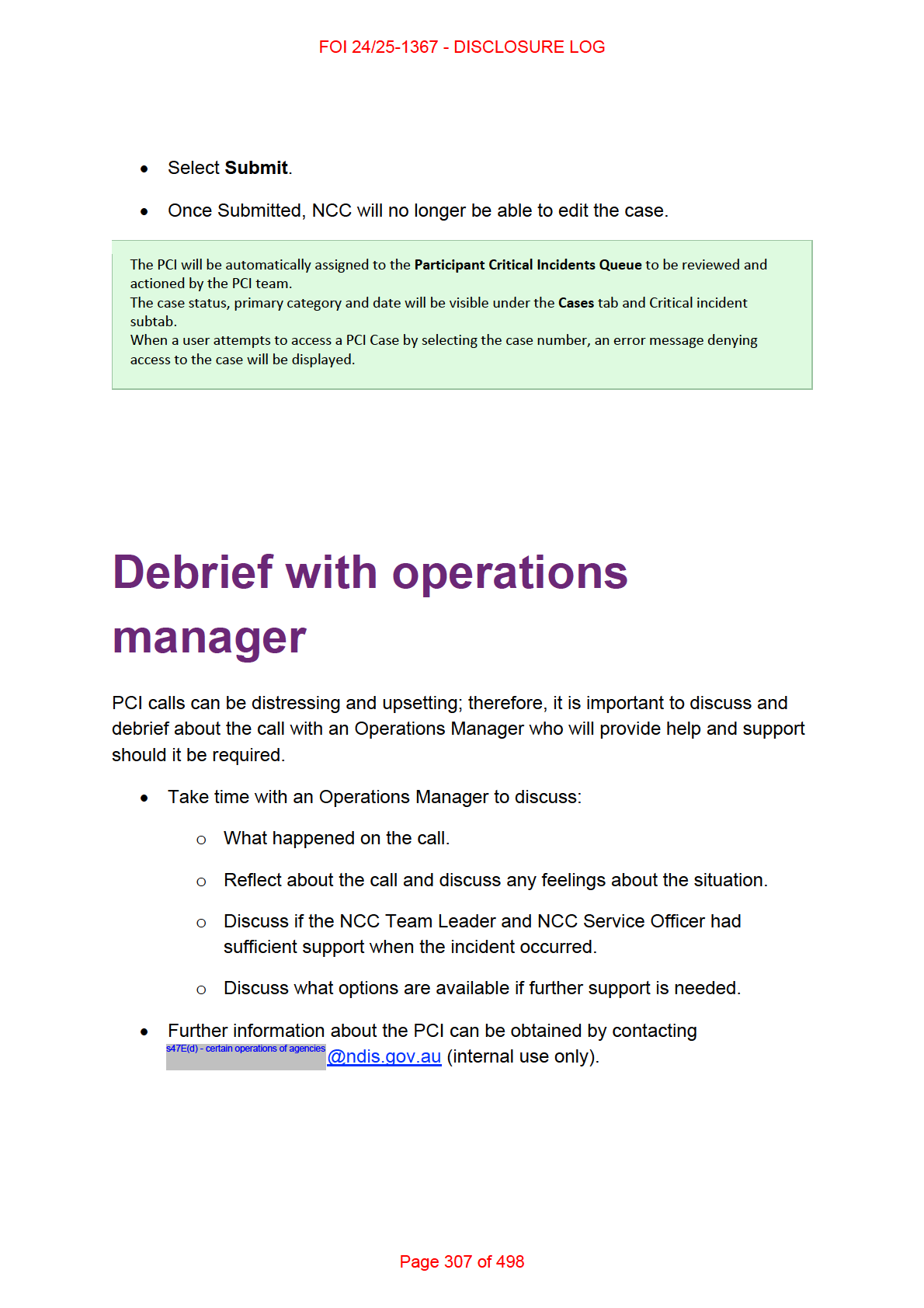
FOI 24/25-1367 - DISCLOSURE LOG
Further information
Please refer to:
• NCC Team Leader Guidance.
• Participant Critical Incidents (PCI) for Service Officers KA.
• Priority Enquiry KA.
• Feedback and Complaints Knowledge Article.
• Fraud Reporting and Scams Helpline Phone Enquiry KA.
• Threat to Site, Staff, Partners, or Others Team Leader KA.
• Consent Phone Enquiry KA.
• Plan Reassessment Request (s48) Phone Enquiry KA.
• Privacy and information on the NDIS Our Guidelines website.
• How to notify the NDIS Commission about a reportable incident on the NDIS
Commission website.
• NDIS Quality and Safeguards Commission website.
• Notification Applicant or Participant has Died Inbound Telephony KA
Enquiry note template
Critical Incident Reported
Copy and paste all text below to use in the enquiry note:
Description: Critical incident reported
Date of enquiry:
Page 308 of 498
FOI 24/25-1367 - DISCLOSURE LOG
Person making enquiry: Include name and relationship to participant (if not
participant). If the person reporting the incident wishes to remain anonymous, do not
include any identifying information.
Details of the enquiry: Details are not to be recorded in PACE.
Call take over by TL: Yes or no
NCC Service Officer log in ID: Log in ID of the Service Officer, TL took over the call
from.
Details of the NCC Service Officers enquiry: Record any details provided from the
Service Officer. No details about the PCI (tip off) or sensitive information is to be
recorded.
Participant/provider phone number: Include phone number of participant/person
that reported incident. If the person reporting the incident wishes to remain
anonymous, do not include any identifying information.
Welfare check done: yes or no. Include the time of call.
Welfare check details: If a welfare check was done include the time of call and the
reference number provided by emergency services
Email sent to NCC Quality Team: Yes or no
Name:
Log on ID:
Team Leader
National Contact Centre
Document owner and approver
Director, Support and Communications, Contact Centre Branch
Page 309 of 498
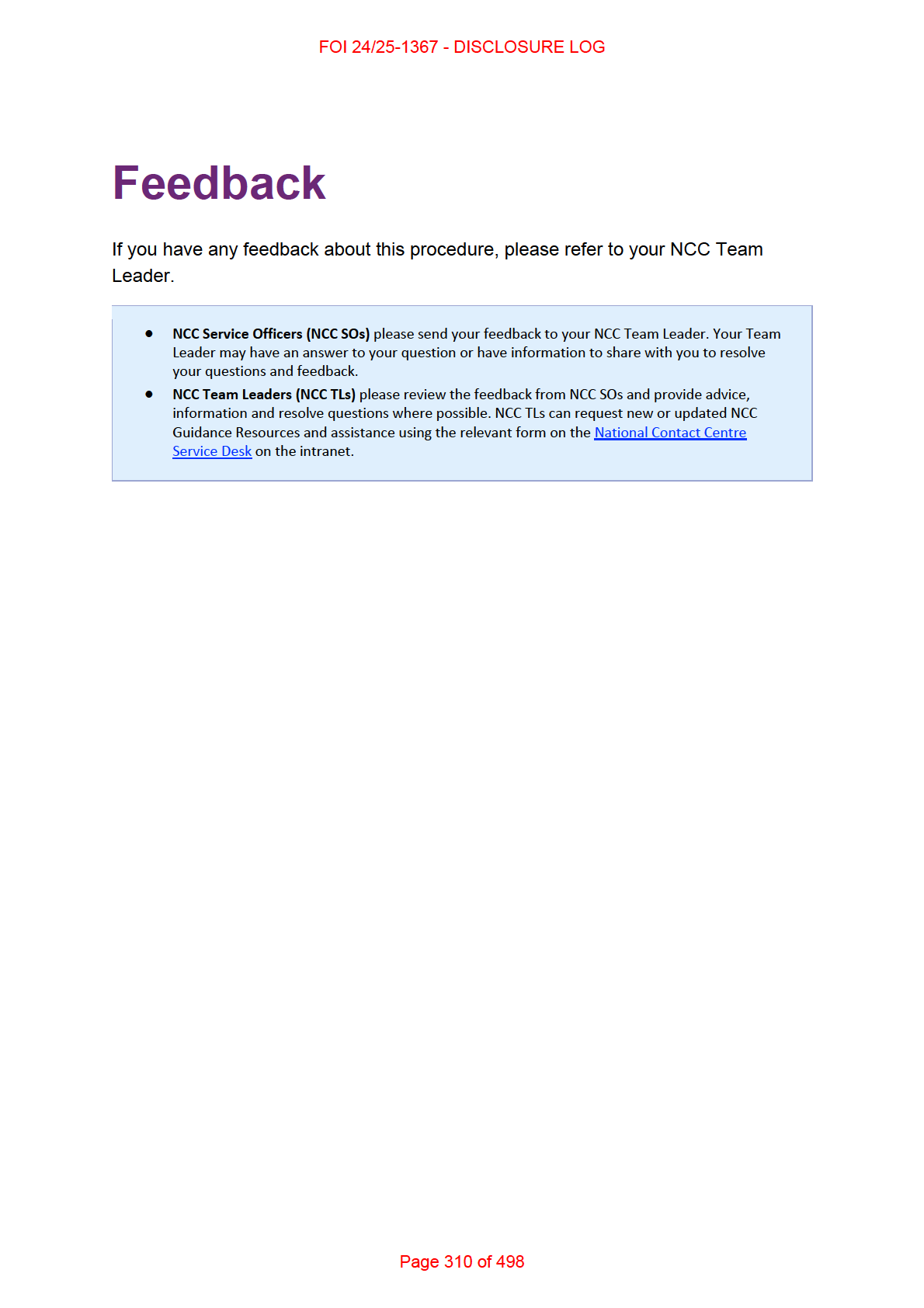
FOI 24/25-1367 - DISCLOSURE LOG
Page 311 of 498
FOI 24/25-1367 - DISCLOSURE LOG
DOCUMENT 20
Priority Enquiry KA
May 02, 2025 02:06
General
• Overview
• NCC roles and responsibilities
• What is a Participant Critical Incident
• Further information
Procedure
• Priority enquiry criteria
• NDIA Escalation Prioritisation Risk Matrix
• Types of priority enquiries
Page 312 of 498
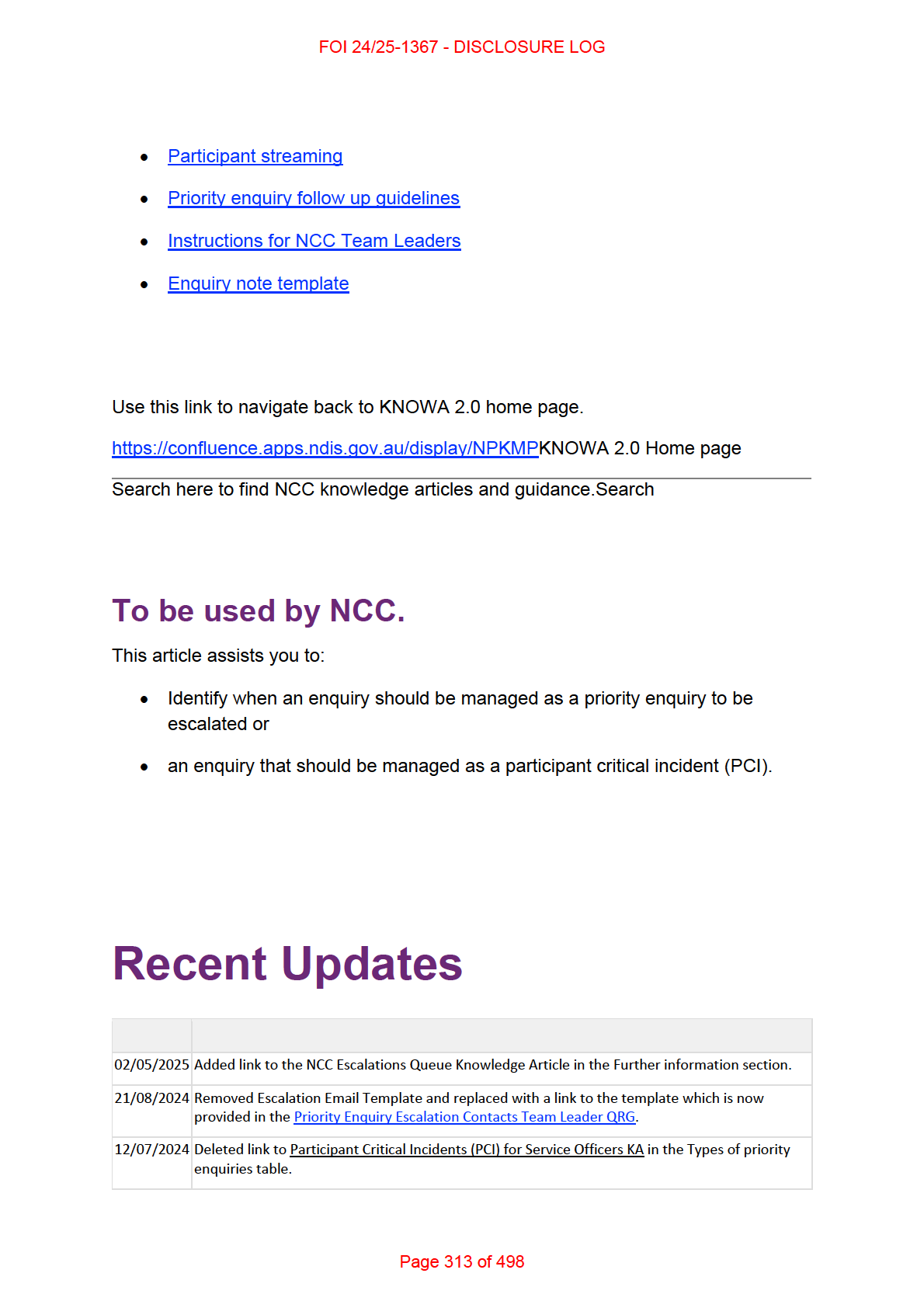
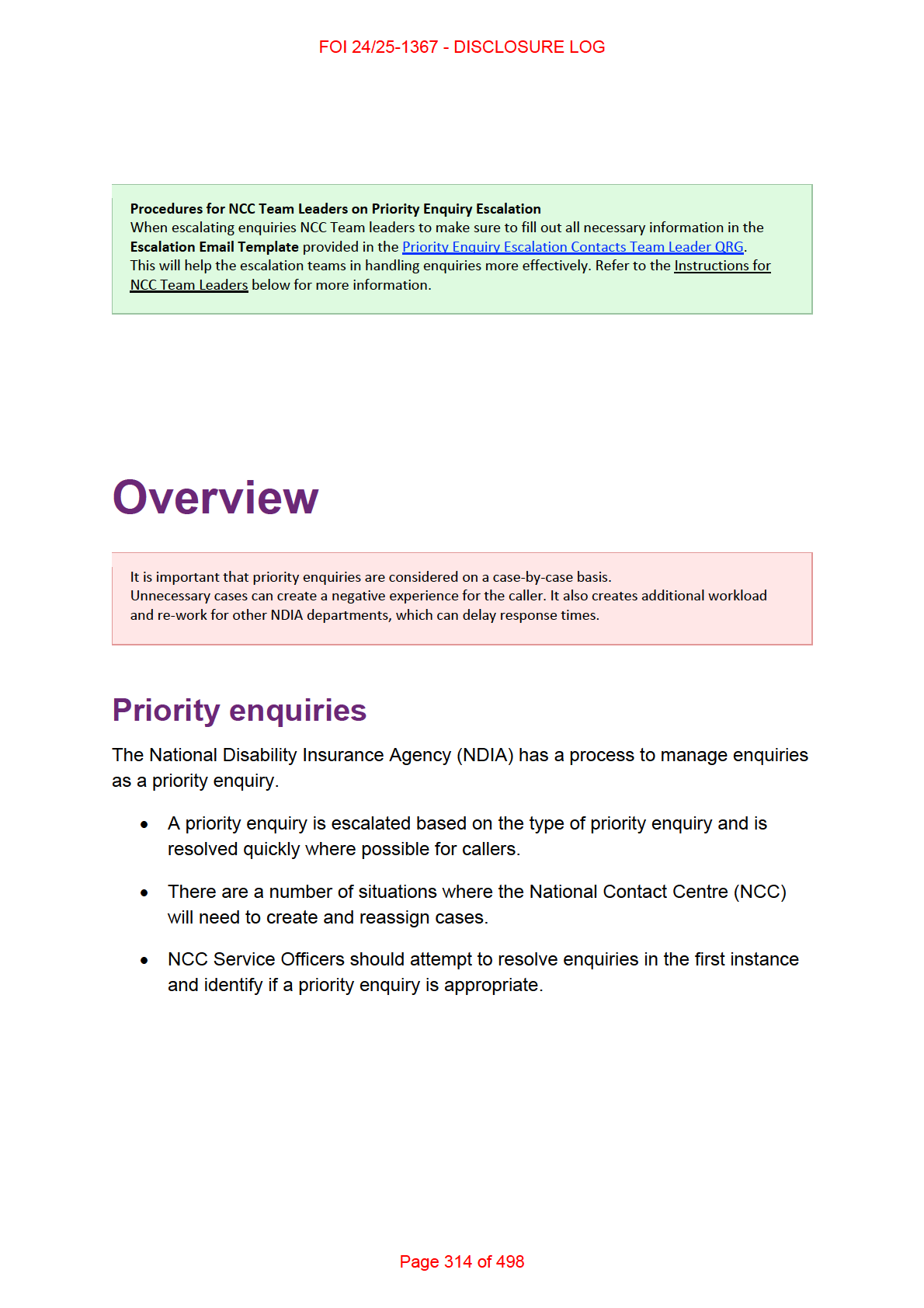
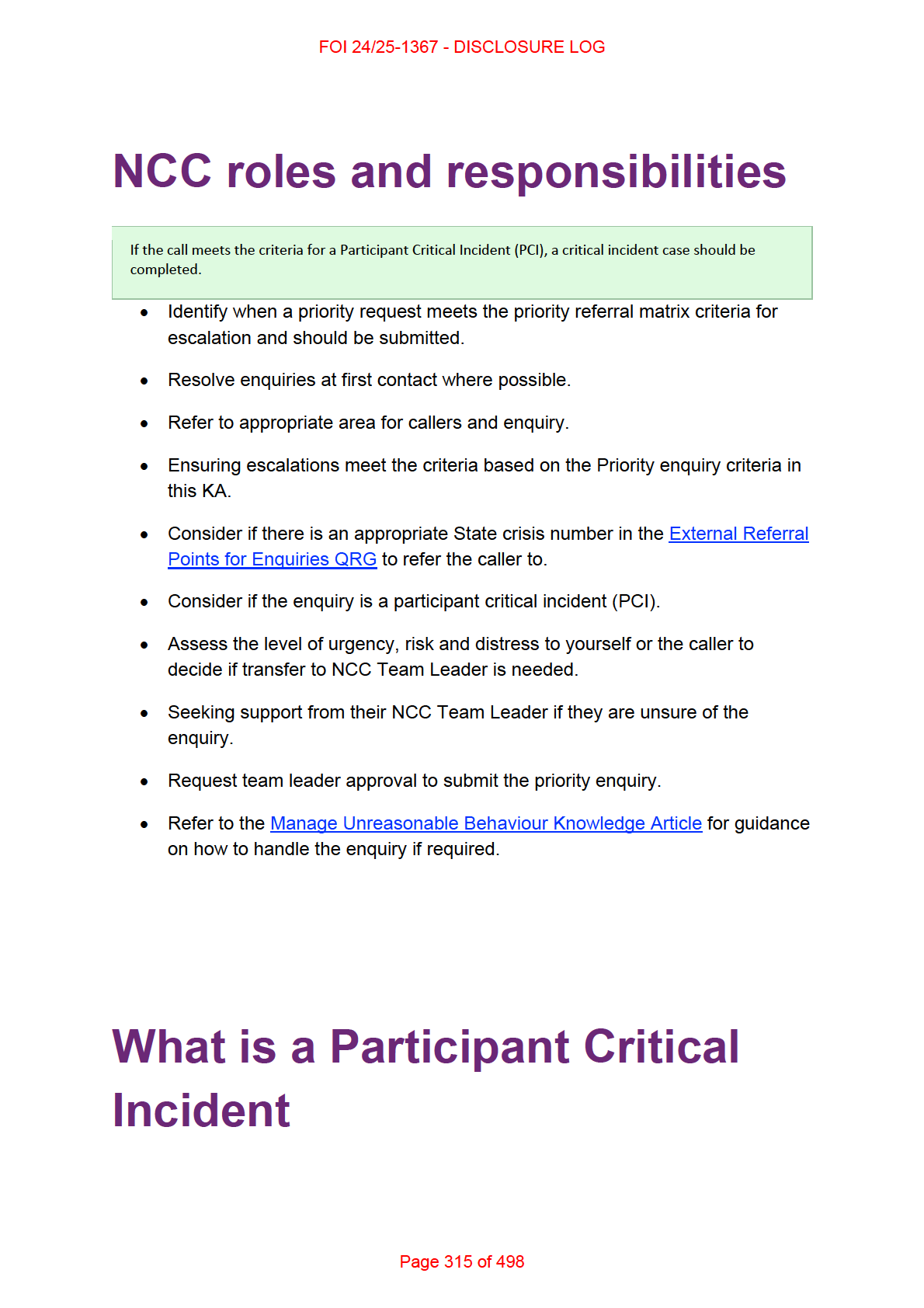
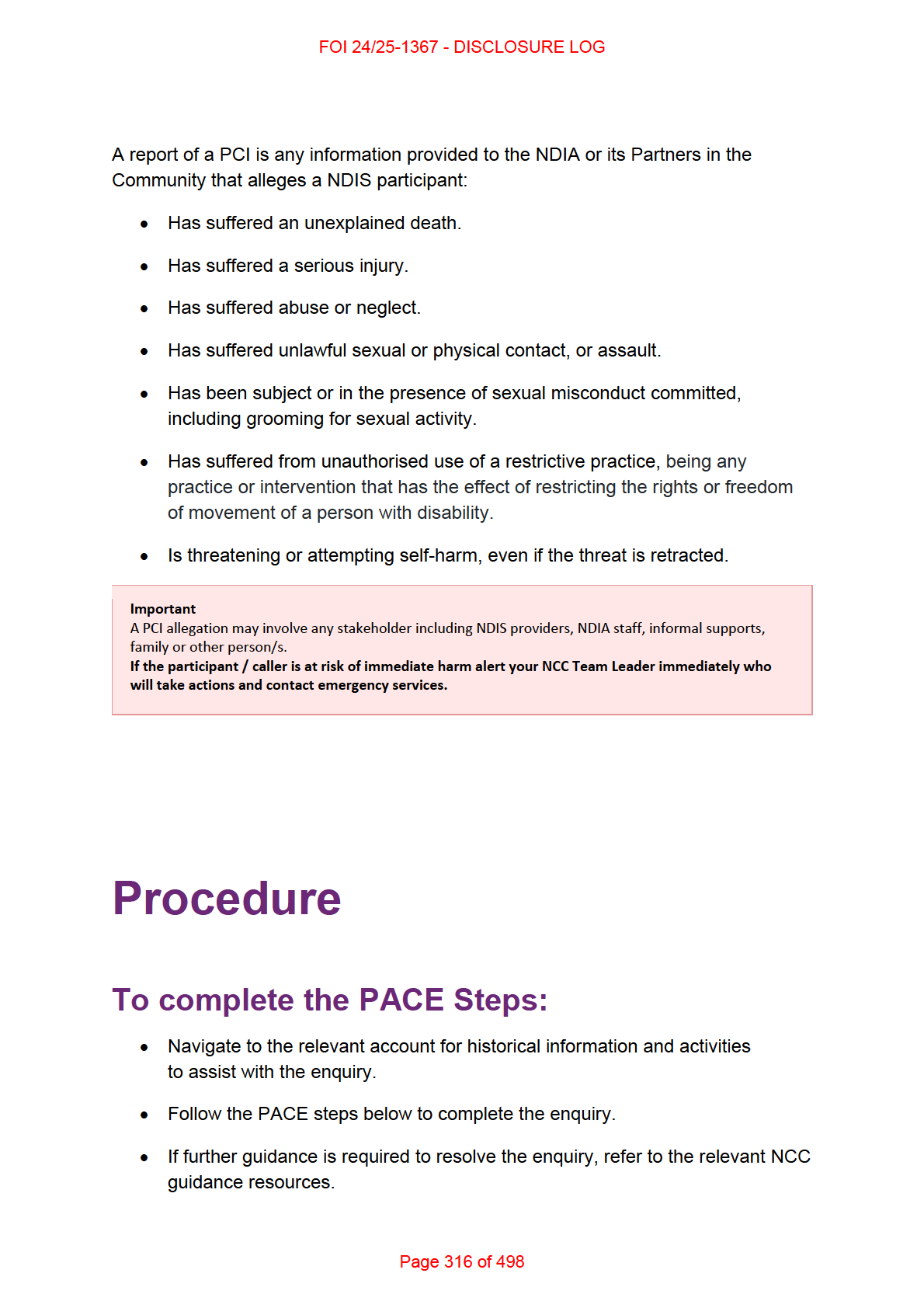
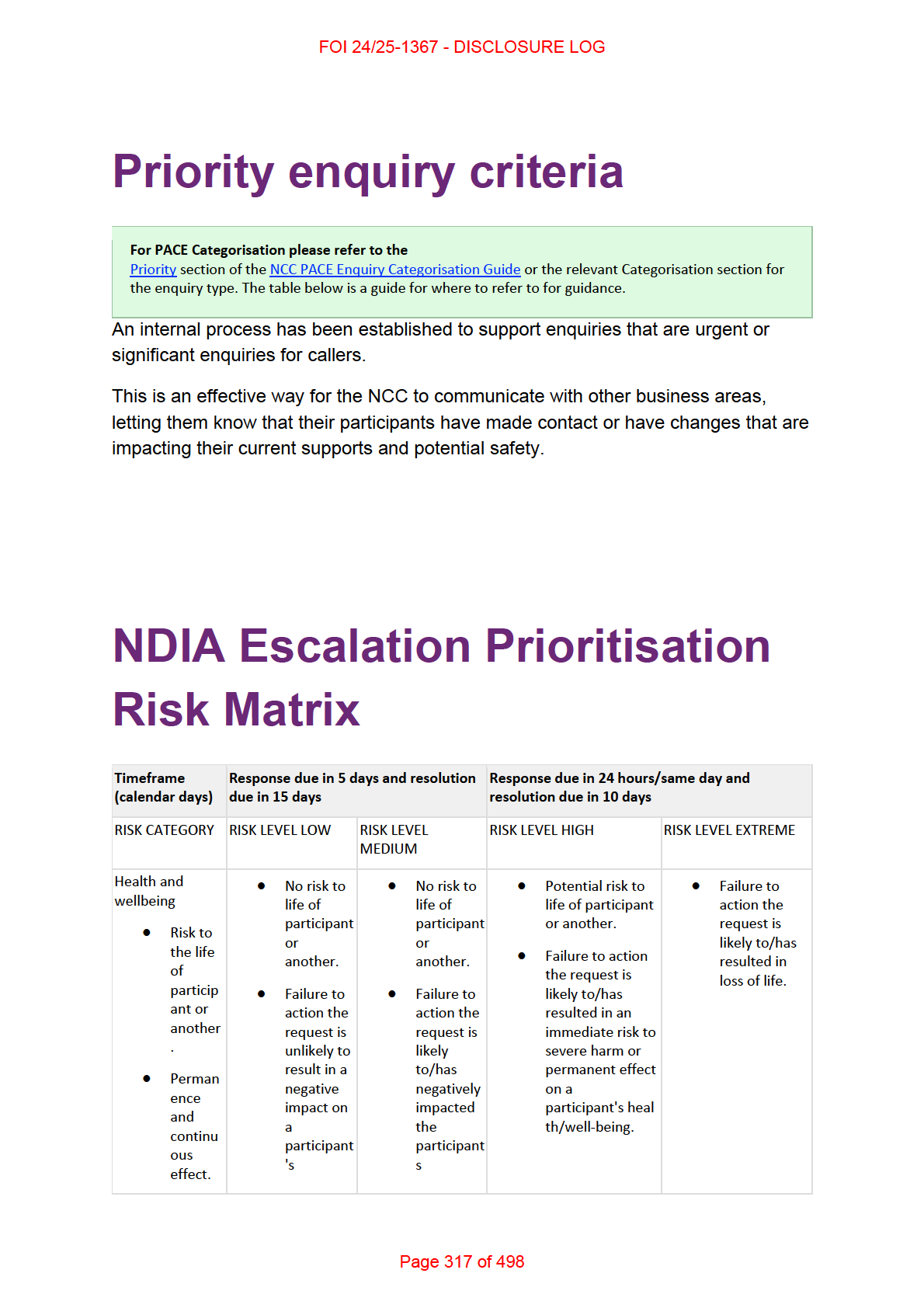
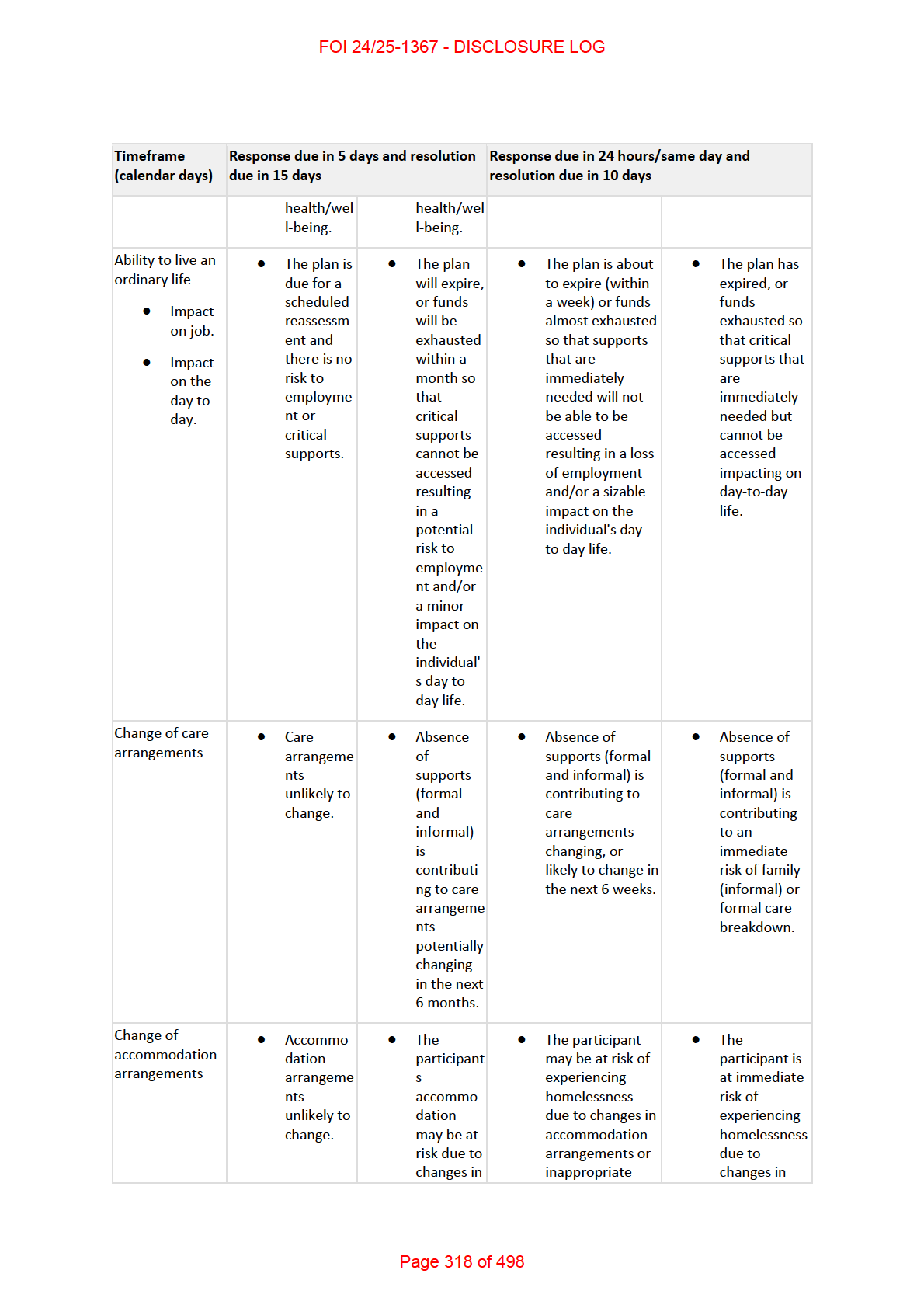
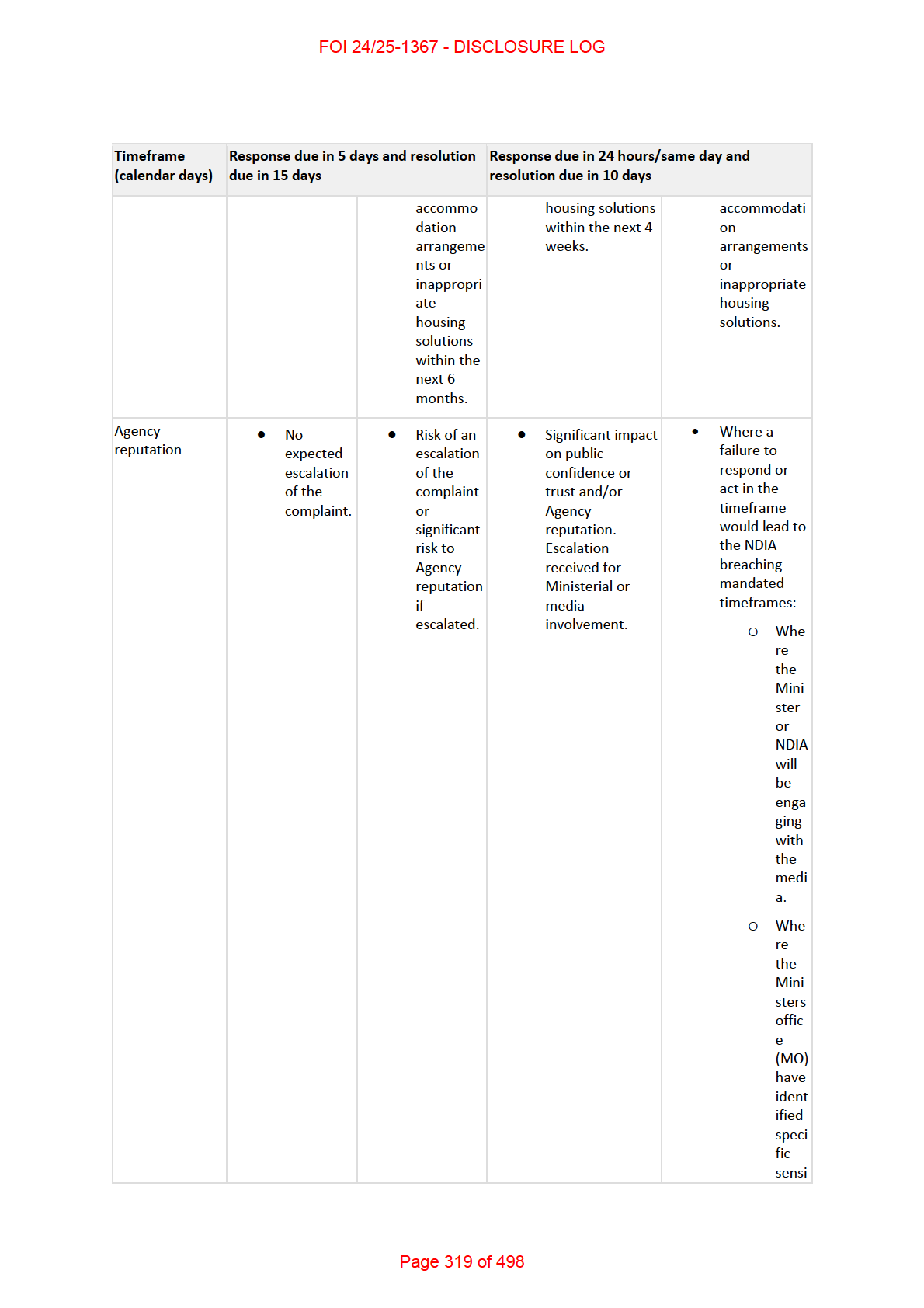

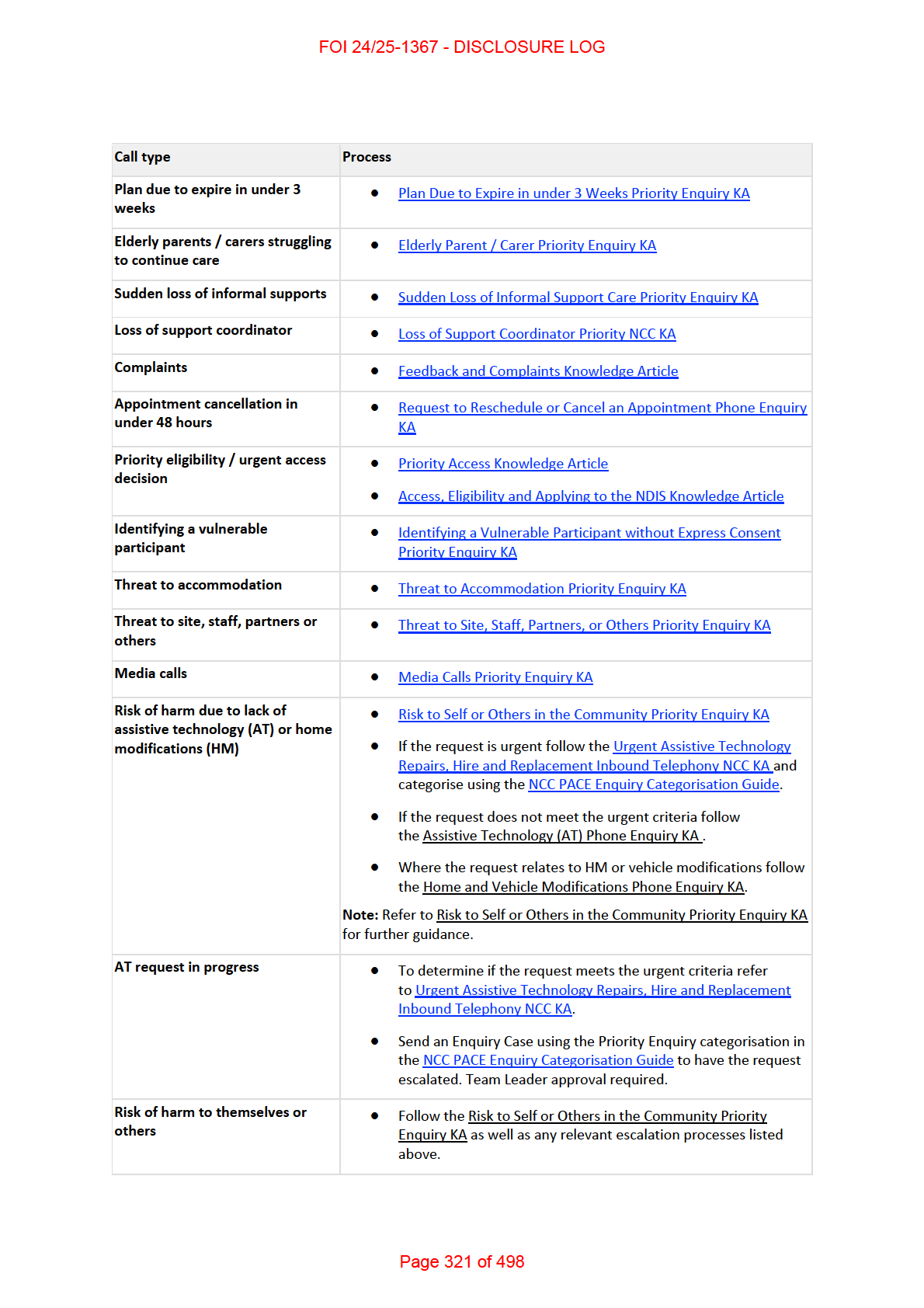
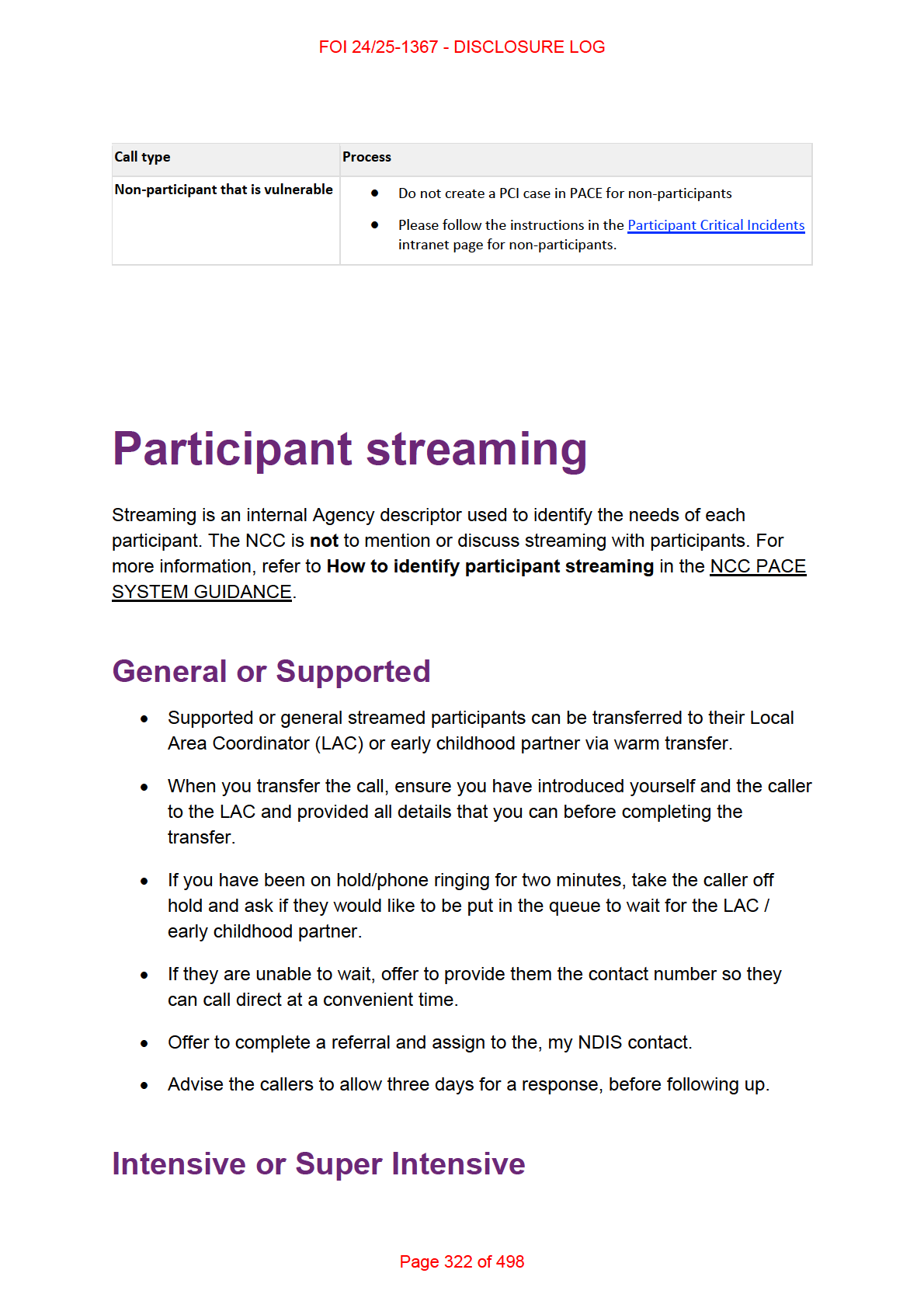
FOI 24/25-1367 - DISCLOSURE LOG
• Intensive and super intensive participants are usually serviced by staff at the
local NDIA office or their early childhood partner for some children.
• Not all sites have reception phones, so you wil need to complete a case in
PACE to the, my NDIS contact using the NCC PACE Enquiry Categorisation
Guide.
• Advise the caller that you are unable to transfer their call, but you wil
complete request to let them know they have called and to call them back
/complete the request.
• The queues are monitored daily so their enquiry wil be referred to the right
person quickly and they should expect a response within approximately 3
days. If they haven't heard from them within 3 days, they can call back to have
their request followed up.
Complex Support Needs
• For participants who have been streamed as complex support needs (CSN)
you wil need to reassign using the NCC PACE Enquiry Categorisation Guide.
Priority enquiry follow up
guidelines
• Locate the existing open enquiry.
• Check if there has been a change in urgency, or the risk rating using the
Escalation Prioritisation Risk Matrix:
o
If yes:
Consider if further escalation should be actioned. Refer to your
Team Leader for guidance. Team leaders to follow the
Instructions for NCC Team Leaders.
Page 323 of 498
FOI 24/25-1367 - DISCLOSURE LOG
If no escalation is required, leave a log activity note detailing any
changes to the nature of the priority enquiry.
Assure the caller their enquiry is active and wil be addressed
promptly.
o
If no:
Create log activity note to record the details of the contact made
to follow up.
Assure the caller their enquiry is active and wil be addressed
promptly.
Instructions for NCC Team
Leaders
If a priority enquiry case was submitted
more than 3 days ago, or if it was submitted
within the
last 3 days but the
risk rating has increased,
NCC Team Leader should:
• Review the case details and using the Escalation Prioritisation Risk Matrix to
assess the escalation requirements.
o It is
important to make sure that the risk is clearly stated and
corresponds with the agency's risk matrix.
• Note that escalation is mandatory
only if the risk rating is
High or Extreme.
• Document the actions taken by adding a
Log Activity note to the existing
Priority Enquiry case.
• Address the email to the
contacts listed in the Priority Enquiry Escalation
Contacts Team Leader QRG.
Page 324 of 498
FOI 24/25-1367 - DISCLOSURE LOG
• If escalation is required, send an email using the
Escalation Email Template
provided in the Priority Enquiry Escalation Contacts Team Leader QRG .
• The NCC Team Leader
must fil out the email template with all required
information to help the escalation teams in effectively handling the enquiries.
Further information
Please refer to:
• External Referral Points for Enquiries QRG
• Manage Unreasonable Behaviour Knowledge Article
• Plan has no Funds Priority Enquiry KA
• Plan Due to Expire in under 3 Weeks Priority Enquiry KA
• Elderly Parent / Carer Priority Enquiry KA
• Sudden Loss of Informal Support Care Priority Enquiry KA
• Loss of Support Coordinator Priority NCC KA
• Feedback and Complaints Knowledge Article
• Request to Reschedule or Cancel an Appointment Phone Enquiry KA
• Priority Access Knowledge Article
• Access, Eligibility and Applying to the NDIS Knowledge Article
• Identifying a Vulnerable Participant without Express Consent Priority Enquiry
KA
• Threat to Accommodation Priority Enquiry KA
Page 325 of 498
FOI 24/25-1367 - DISCLOSURE LOG
• Threat to Site, Staff, Partners, or Others Priority Enquiry KA
• Risk to Self or Others in the Community Priority Enquiry KA
• Media Cal s Priority Enquiry KA
• NCC Escalations Queue Knowledge Article
Enquiry note template
Please select the enquiry note template listed in the relevant Knowledge Article that
is appropriate for the enquiry.
Document owner and approver
Director, Support and communications, Contact Centre Branch
Feedback
If you have any feedback about this procedure, please refer to your NCC Team
Leader.
Page 326 of 498

FOI 24/25-1367 - DISCLOSURE LOG
Page 328 of 498
FOI 24/25-1367 - DISCLOSURE LOG
DOCUMENT 21
Risk to Self or Others in the
Community Priority Enquiry KA
Feb 19, 2025 06:34
General
• General information
• Steps for responding to participant safety risks
• Further information
Procedure
• Risks to self, others, and property
• Enquiry note template
Page 329 of 498
FOI 24/25-1367 - DISCLOSURE LOG
Use this link to navigate back to KNOWA 2.0 home page.
https://confluence.apps.ndis.gov.au/display/NPKMPKNOWA 2.0 Home page
Search here to find NCC knowledge articles and guidance.Search
To be used by NCC.
This article assist you to:
• Resolve calls where either the caller or a participant is a risk to self or to
others in the community.
General information
What is a risk to self or others in the
community?
When the participant is at risk of hurting themselves, family, or members or the
community the Agency has a responsibility to ensure the participant and others are
at all times safe. This is a priority enquiry as outlined in the Priority Enquiry KA.
Examples of where an individual is a risk to
themselves and/or others are:
• A participant threatening or attempting self-harm.
• Threats made to a site, staff, partner staff or property.
Page 330 of 498
FOI 24/25-1367 - DISCLOSURE LOG
• Risk to a non participant that is vulnerable.
• Threats of violence or actual violent behaviour by the participant towards
family or members of the community.
Procedure
To complete the PACE Steps:
• Navigate to the relevant account for historical information and activities
to assist with the enquiry.
• Follow the PACE steps below to complete the enquiry.
• If further guidance is required to resolve the enquiry, refer to the
relevant NCC guidance resources.
Risks to self, others, and
property
When advised a participant is a risk to
themselves or others in the community:
Page 331 of 498
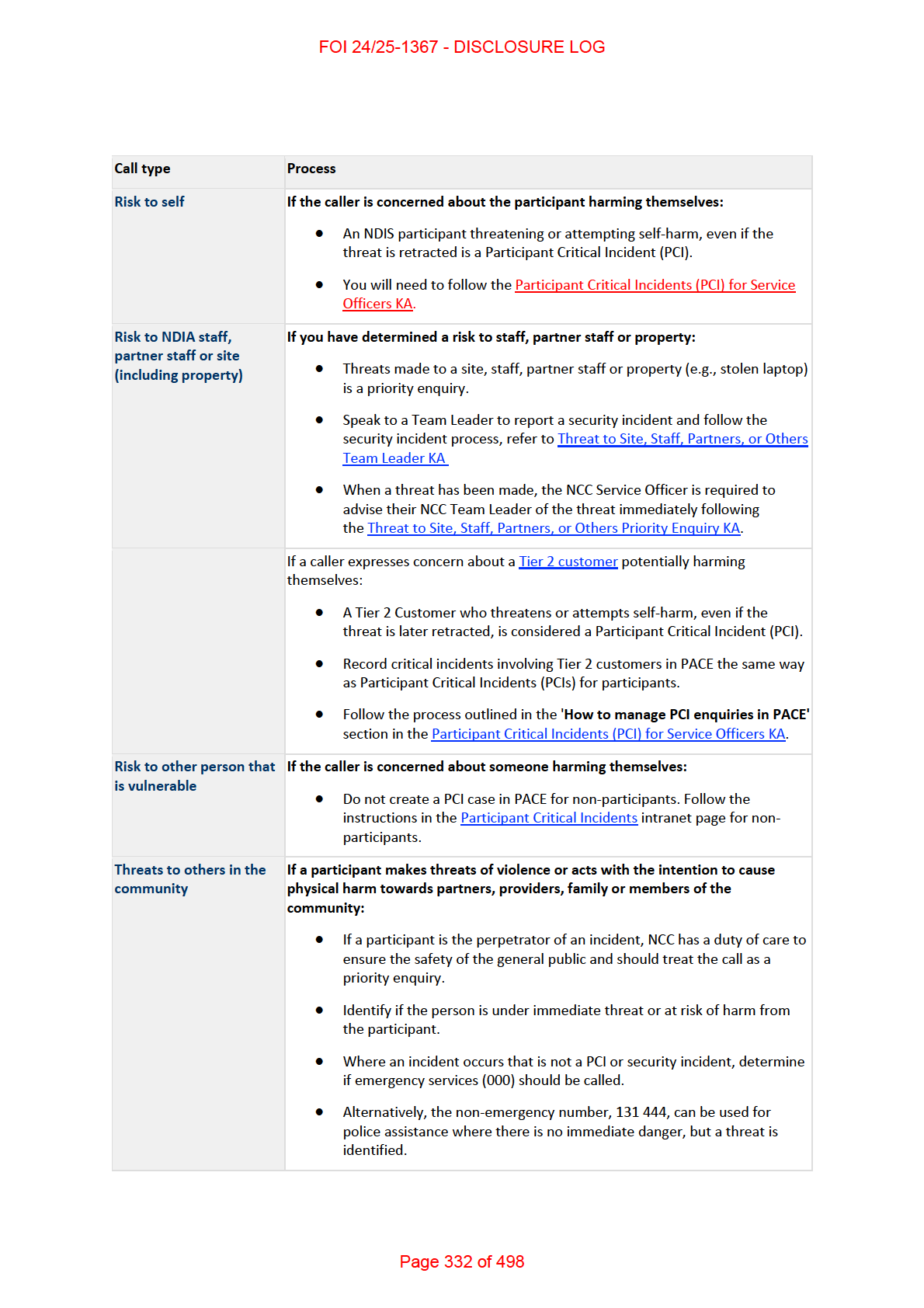
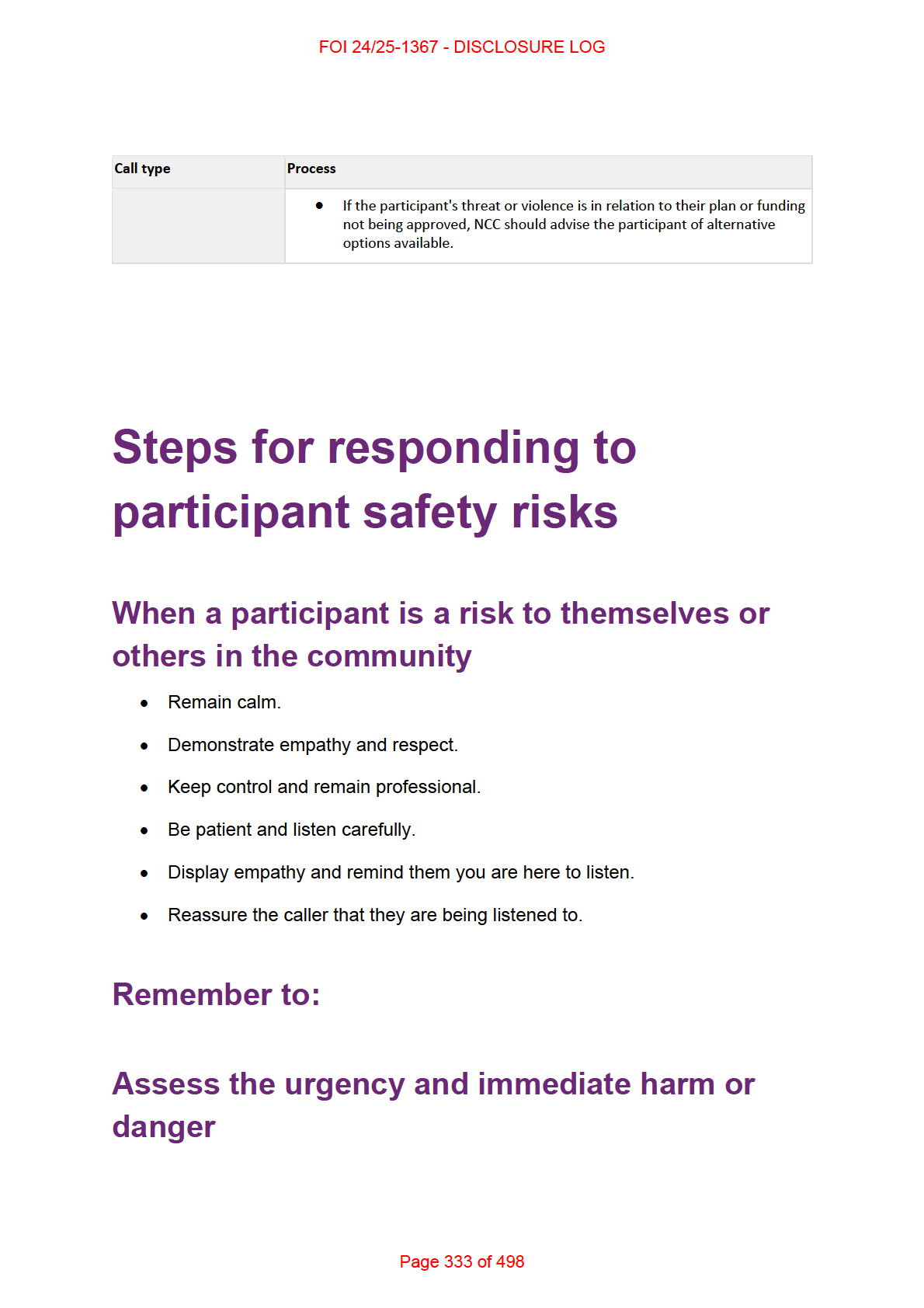
FOI 24/25-1367 - DISCLOSURE LOG
When the participant /caller's safety is at risk alert your NCC Team Leader
immediately.
• Identify why the participant is at risk to themselves or others.
• Discuss and enquire about the level of risk the caller/participant is at of
accidental y hurting themselves; family members; or community members.
• Determine if the alleged incident wil /has caused an immediate serious threat
or harm to the person.
• Is the person under immediate threat or at risk of immediate harm?
• Does a welfare check need to be undertaken?
• Always err on the side of caution.
Further information
Please refer to:
• Priority Enquiry KA
• Threat to Site, Staff, Partners, or Others Priority Enquiry KA
• NCC PACE Enquiry Categorisation Guide
• Urgent Assistive Technology (AT) Repairs, Hire and Replacement Phone
Enquiry KA
• Assistive Technology (AT) Phone Enquiry KA
• Home and Vehicle Modifications Inbound Telephony NCC KA
• Participant Critical Incidents (PCI) for Service Officers KA
• Threat to Site, Staff, Partners, or Others Priority Enquiry KA
Page 334 of 498
FOI 24/25-1367 - DISCLOSURE LOG
Enquiry note template
Risk to Self or Other/s in the Community
Copy and Paste all Text Below to use in the Enquiry Note:
Description: e.g., risk to self or other/s in the community
Date of enquiry: DD/MM/YYYY
Person making request: Include name and relationship to participant (if not
participant)
Details of the request:
Contact number:
Welfare Check Done: yes/no
Action taken:
Name:
Log on ID:
Service Officer
National Contact Centre
Team Leader who approved:
Document Owner and
Approver
Director, Support and Communications, Contact Centre Branch
Page 335 of 498
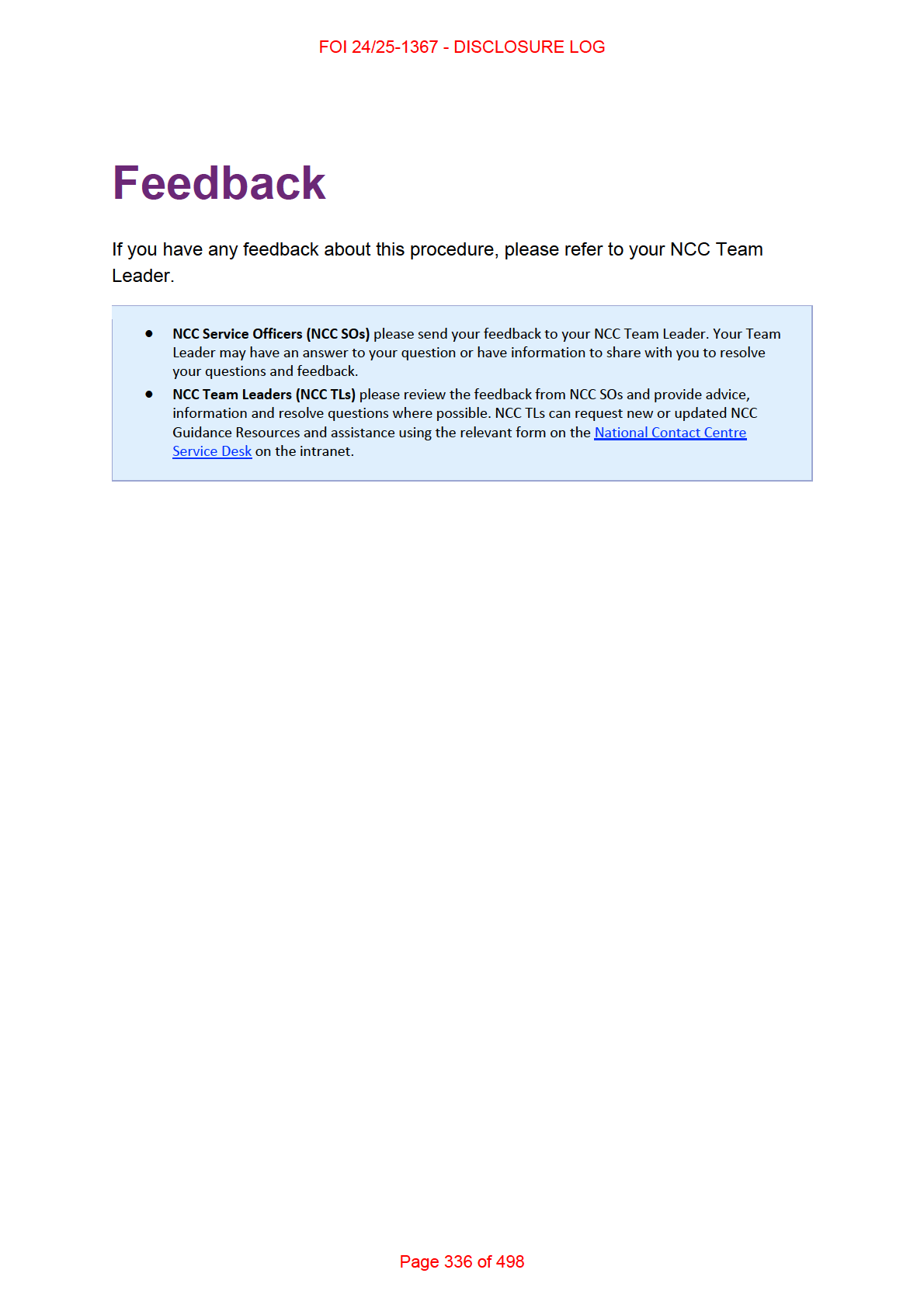
FOI 24/25-1367 - DISCLOSURE LOG
Page 337 of 498
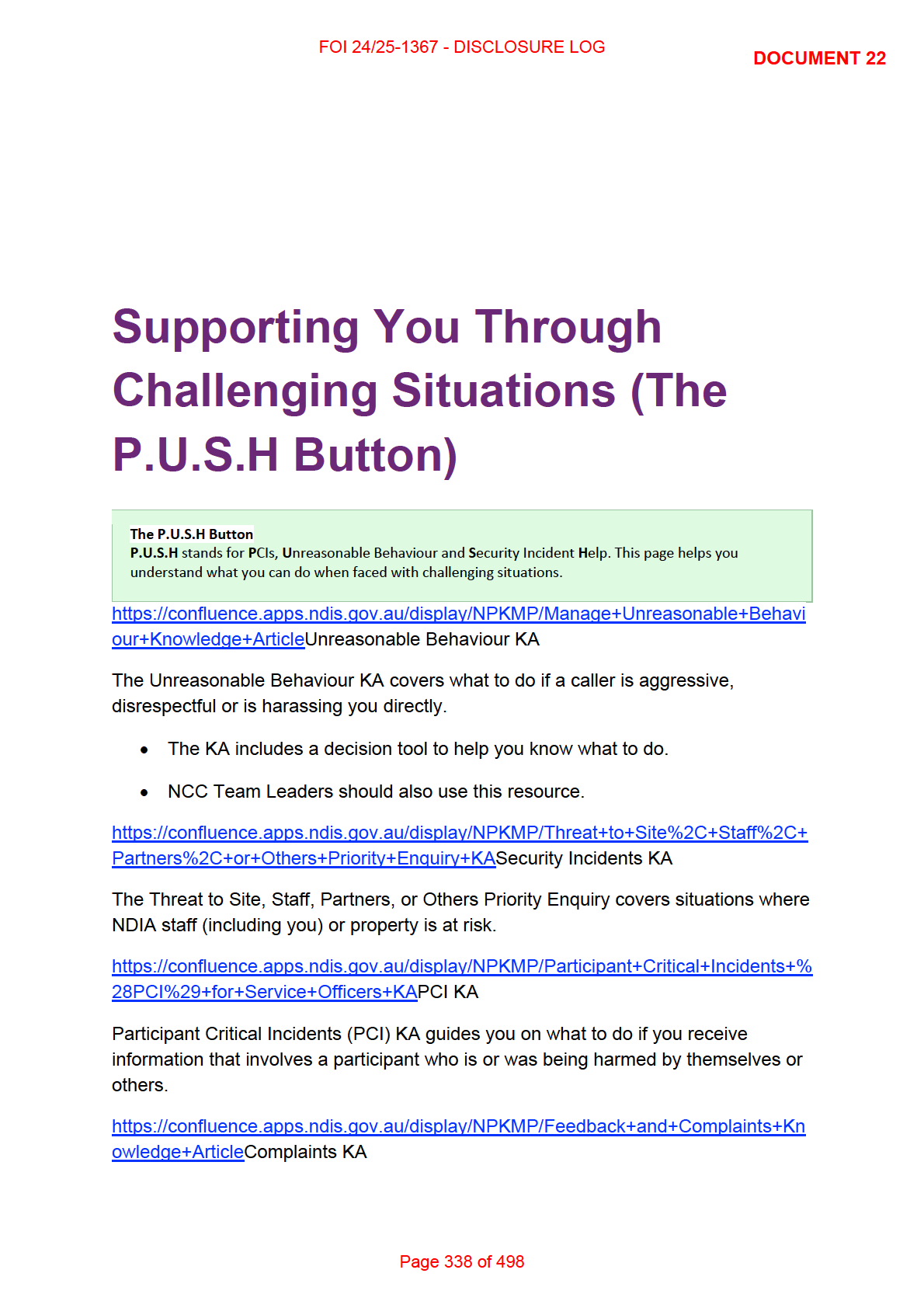
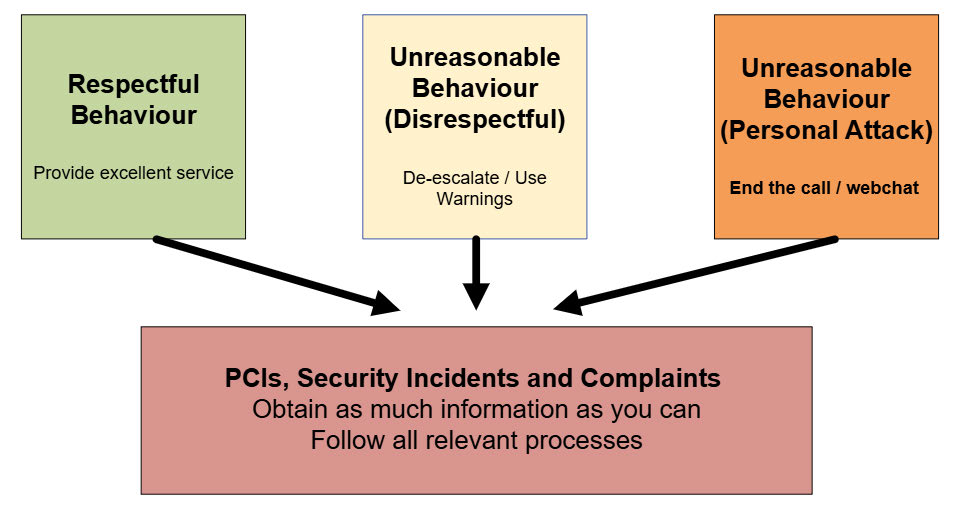
FOI 24/25-1367 - DISCLOSURE LOG
The Feedback and Complaints KA guides you on the process for handling
complaints about the NDIA or NDIS.
Figure 1 Flowchart for unreasonable behaviour, PCIs and Security Incidents
Your wel being is important.
If the there is a PCI or Security Incident but you feel under personal attack,
you can end the conversation.
Page 339 of 498
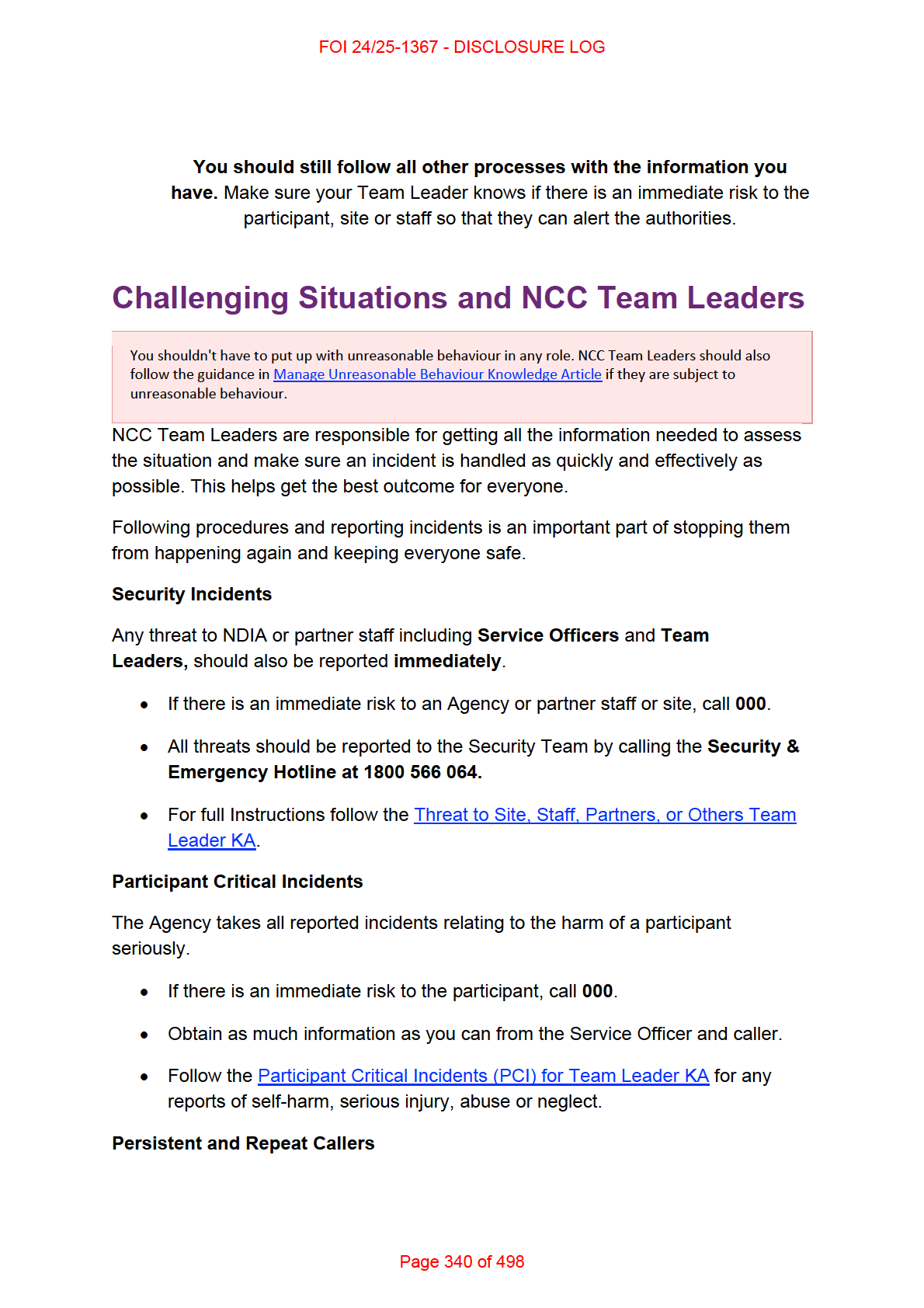
FOI 24/25-1367 - DISCLOSURE LOG
In most instances a repeat caller wil stop calling once their issue is resolved. There
are some persistent callers that wil require extra steps or processes be put in place.
• Check the participant's streaming - a restreaming may be required.
• If you believe a communication plan needs to be put in place, speak to your
line manager.
• Follow the Persistent and Repeat Callers Team Leader KA to advise the
relevant business area.
Staff Wellbeing
The Agency take the wellbeing of its staff seriously. It is important to support Service
Officers both during and after the interaction.
• Debrief with the Service Officer and make sure they are aware of My
Wellbeing supports.
• Check in with the Service Officer afterwards. Sometimes triggering events can
have an impact days after the event.
•
Remember that you are a NDIA staff member as well. Speak to your line
manager if you need to.
How to manage:
Unreasonable Behaviour
• Speak to your NCC Team Leader immediately.
• Follow the Manage Unreasonable Behaviour Knowledge Article.
• Debrief with your NCC Team Leader.
Suggested responses
Page 341 of 498
FOI 24/25-1367 - DISCLOSURE LOG
If their communication is disrespectful and/or offensive:
Start Quote Icon Please speak respectfully, or I wil have to end our call. End Quote
Icon
If you feel under personal attack:
Start Quote Icon I am ending the call as you are not speaking respectfully. End
Quote Icon
Security Incidents
• Speak to your NCC Team Leader immediately.
• Follow the Threat to Site, Staff, Partners, or Others Priority Enquiry KA.
• Debrief with your NCC Team Leader.
Suggested responses
Person is reporting an offence that may be about to happen or is already underway.
Start Quote Icon Are you in immediate danger? Are you able to safely tell me exactly
what is happening please? End Quote Icon
Person is reporting a security incident.
Start Quote Icon Can you describe the incident please, starting with where and when
it took place? Try to give as much detail as possible. Any information you can
remember is important and could be helpful. End Quote Icon
If you believe an offence may have been committed, or a security incident has
occurred.
Start Quote Icon I'd like to go back to when you mentioned <name incident>. Can
you tell me more about this please? Let's start with exactly what you
saw/heard/read. End Quote Icon
Transferring to a Team Leader
When to transfer to a Team leader
Page 342 of 498
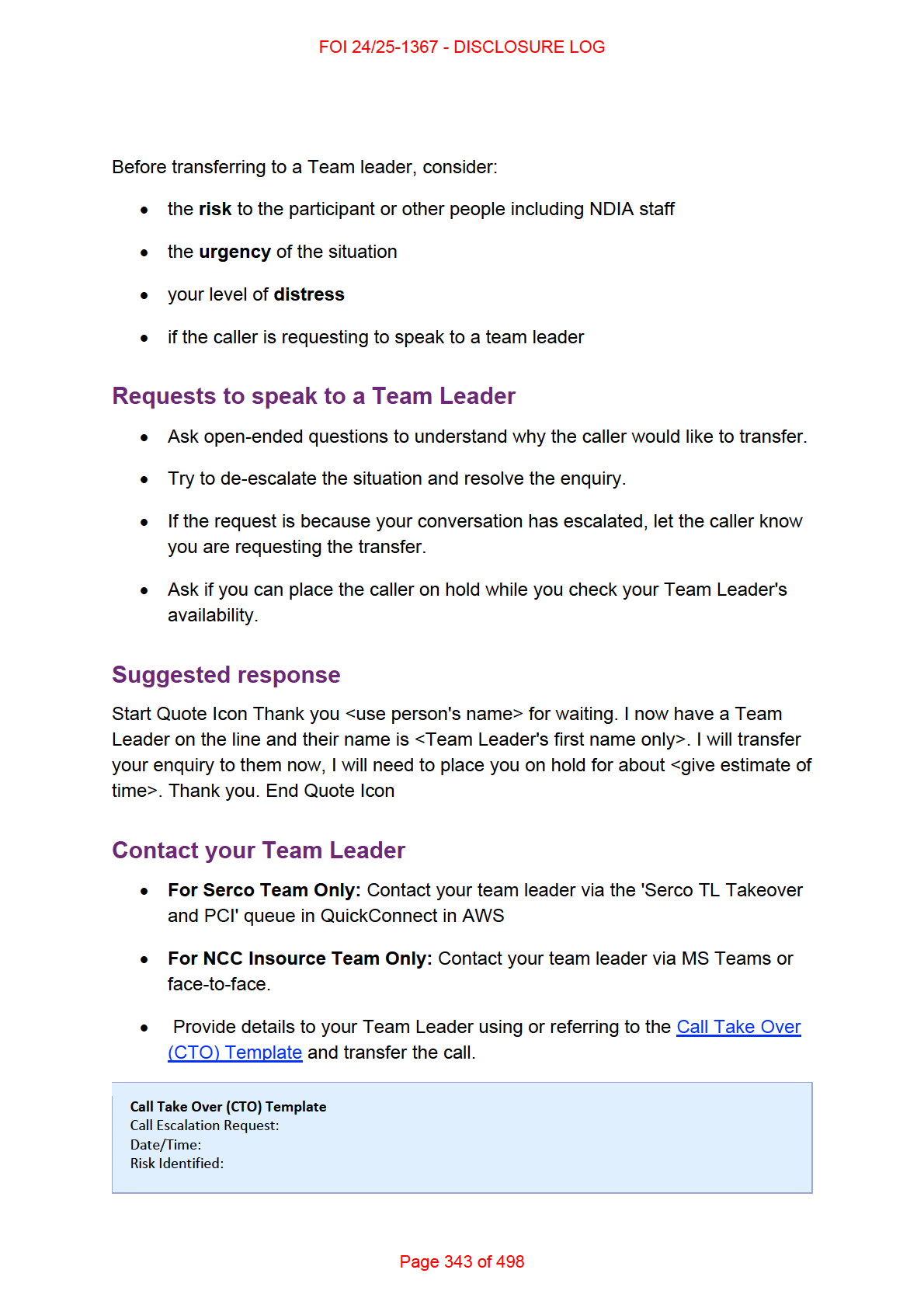
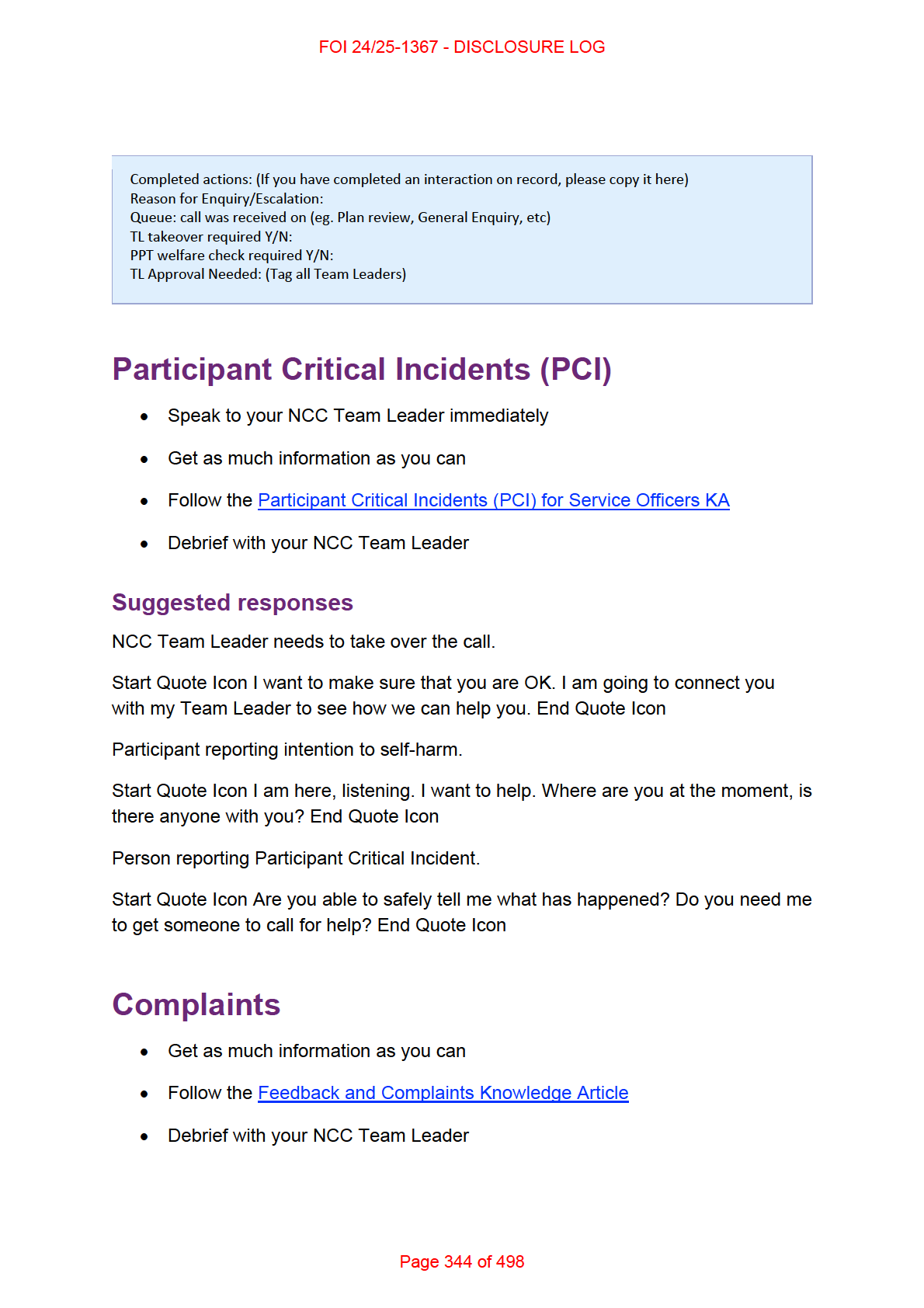
FOI 24/25-1367 - DISCLOSURE LOG
Suggested responses
Person has provided general feedback as part of their enquiry.
Start Quote Icon Thank you for your feedback. I wil make sure it gets passed onto
the relevant team. Is there anything else I can help you with today? End Quote Icon
Person is emotional and may be in distress as a result of the issue they are
complaining about.
Start Quote Icon I am sorry that you have had this experience. Can you tell me
exactly what has happened please so that we can try to help with your enquiry. End
Quote Icon Person has given their feedback and would like to make a formal
complaint.
Start Quote Icon I appreciate you taking the time to tell me about your experience.
Would you like me to help you lodge a complaint to make sure your feedback
reaches the right people? End Quote Icon
Other Triggering Situations
Challenging situations are different for everyone. What might be distressing for one
person is just part of the job for someone else. It's important you feel confident and
supported to take action when you are feeling at risk or unsafe.
Let your NCC Team Leader know if you feel you aren't coping or if an incident occurs
and you need to seek support.
• Speak to your NCC Team Leader immediately
• Debrief with your NCC Team Leader
• Support Services for NDIA staff
o Employee Assistance Programs (EAP)
o NDIA Peer Support Contact Officer Report Form
o If you are NCC partner staff, you can access the relevant supports
through your organisation, including EAP supports
Page 345 of 498
FOI 24/25-1367 - DISCLOSURE LOG
Supporting information
This includes background, additional guidance, and resources for quality outcomes.
Health, Safety and Wel being
Your mental health is important. You can access help now, or any time you need it.
It can take time after an incident to realise how it has affected you. Al NDIA staff and
partners should feel confident and supported to get the help they need when dealing
with personal and work-related issues.
• Everyone handles chal enging situations differently.
• It is OK to ask for support when you need it, your wellbeing and safety is
important.
• Speaking up and reporting incidents helps keep everyone safe and supports
respectful, healthy workplaces.
• There are many different ways to receive the help and support you need:
o Health and wellbeing program with Agency and external resources,
available at My Wellbeing
o Emergency services – 000
o Lifeline – 13 11 14
o Suicide Call Back Service – 1300 659 467
o 13YARN – 139276 (crisis support for Aboriginal and Torres Strait
Islanders)
o 1800RESPECT (1800 737 732)
o For concerns about a staff member in distress, follow the TELUS
Health Clinical Support Referral Guide (DOCX 124KB)
Common Terms
Page 346 of 498
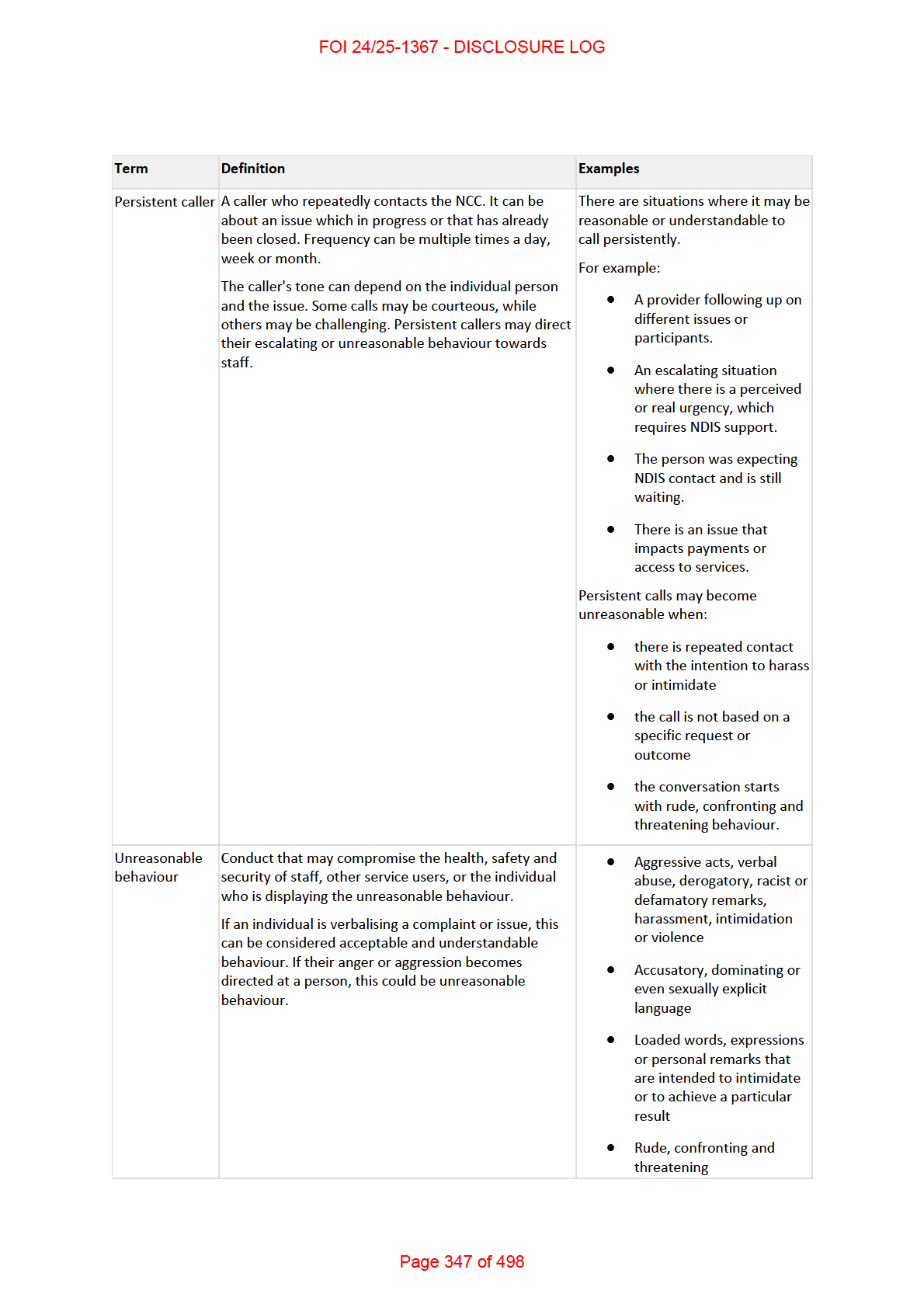
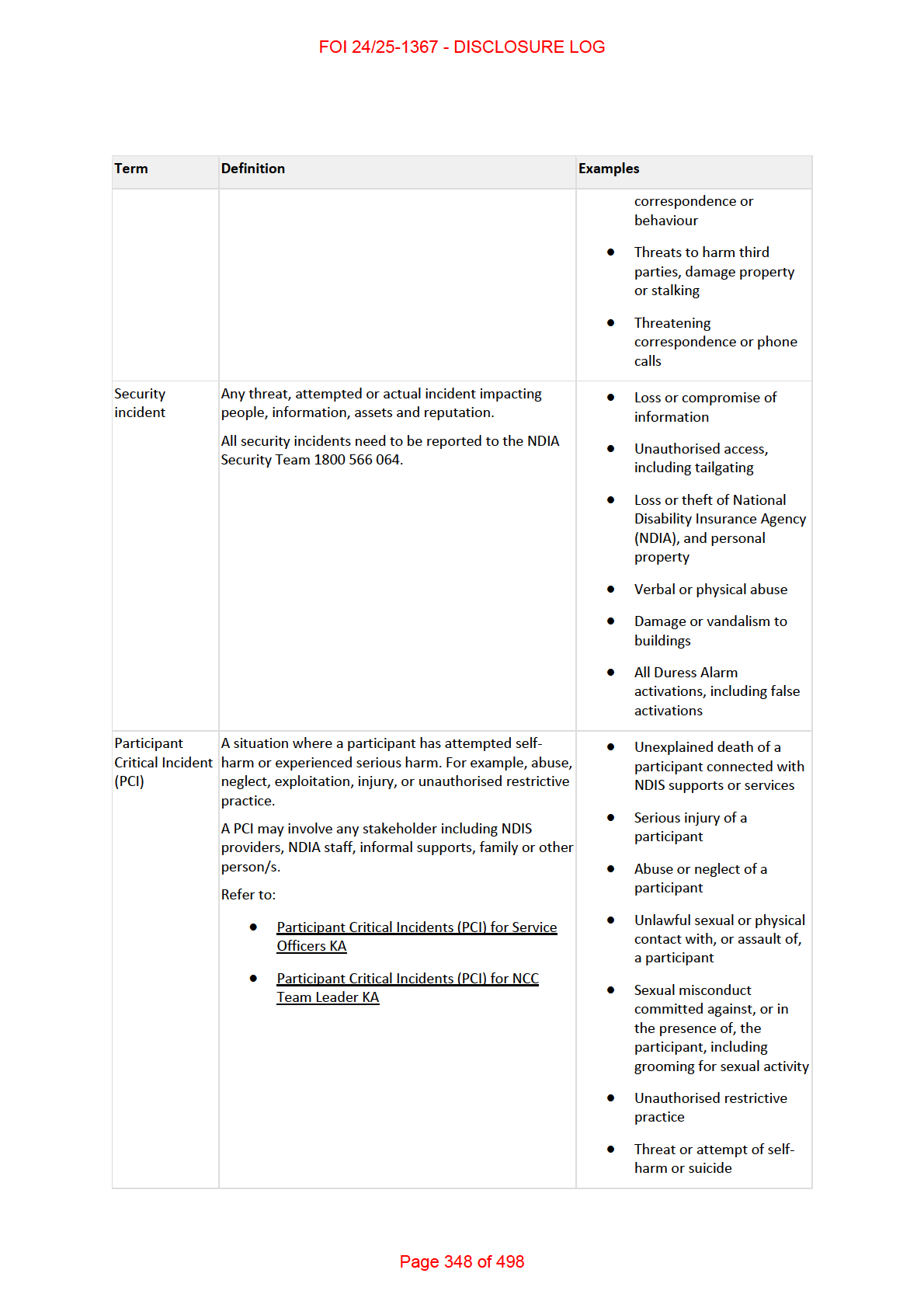
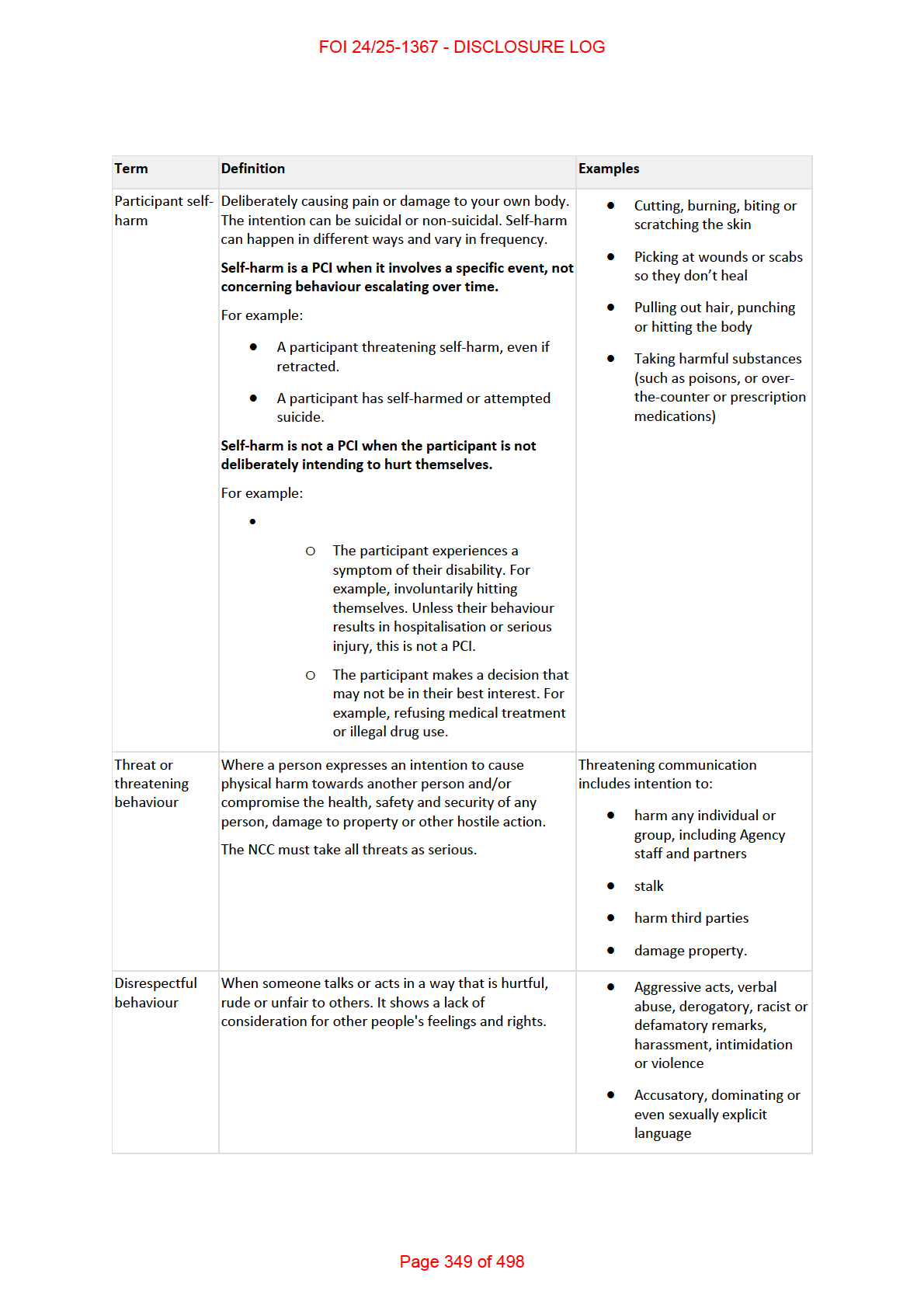
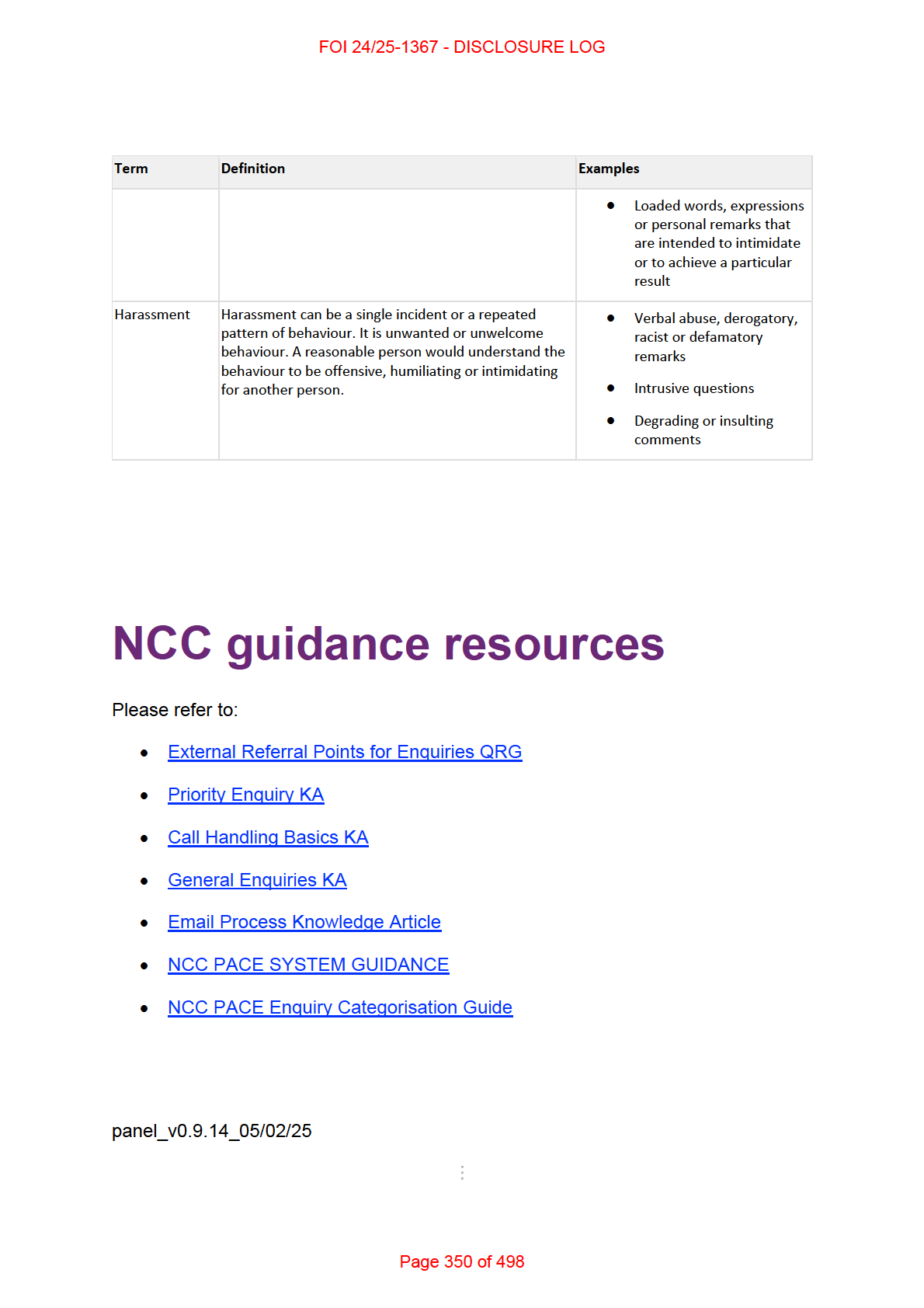
FOI 24/25-1367 - DISCLOSURE LOG
Search KNOWA 2.0:
Search
On this page:
• Your wellbeing is important.
• How to manage:
• Supporting information
• NCC guidance resources
• Search KNOWA 2.0:
• On this page:
• Saved pages:
• Recently viewed:
Page 351 of 498
FOI 24/25-1367 - DISCLOSURE LOG
Saved pages:
Recently viewed:
Page 352 of 498
FOI 24/25-1367 - DISCLOSURE LOG
Page 353 of 498
FOI 24/25-1367 - DISCLOSURE LOG
DOCUMENT 23
Threat to Site, Staff, Partners,
or Others Team Leader KA
May 02, 2025 02:02
General
• Further information
• Enquiry note template
Procedure
• Threat to site, staff, partners or others process
• Handling threats to sites
• Welfare checks and our duty of care
Page 354 of 498
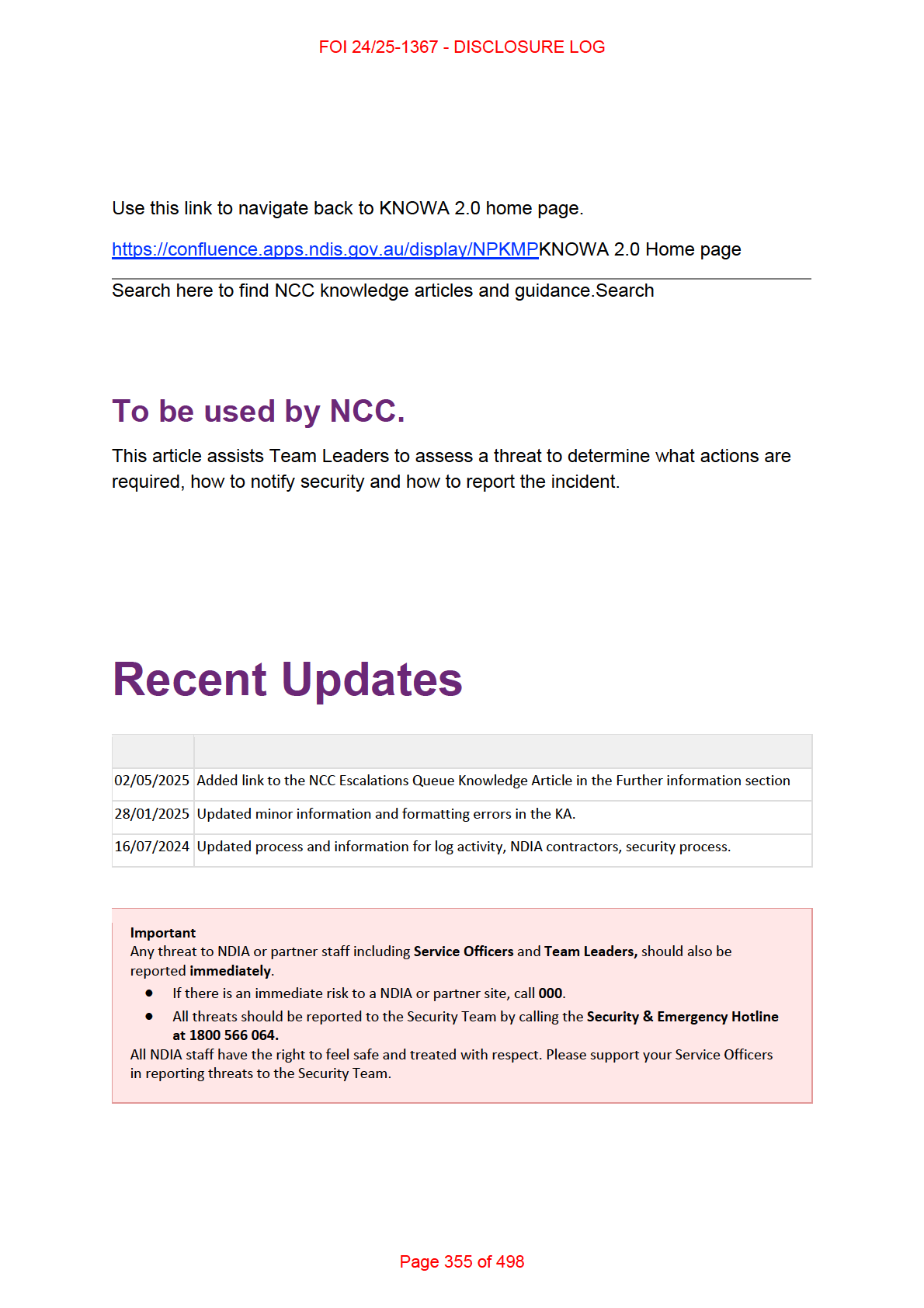
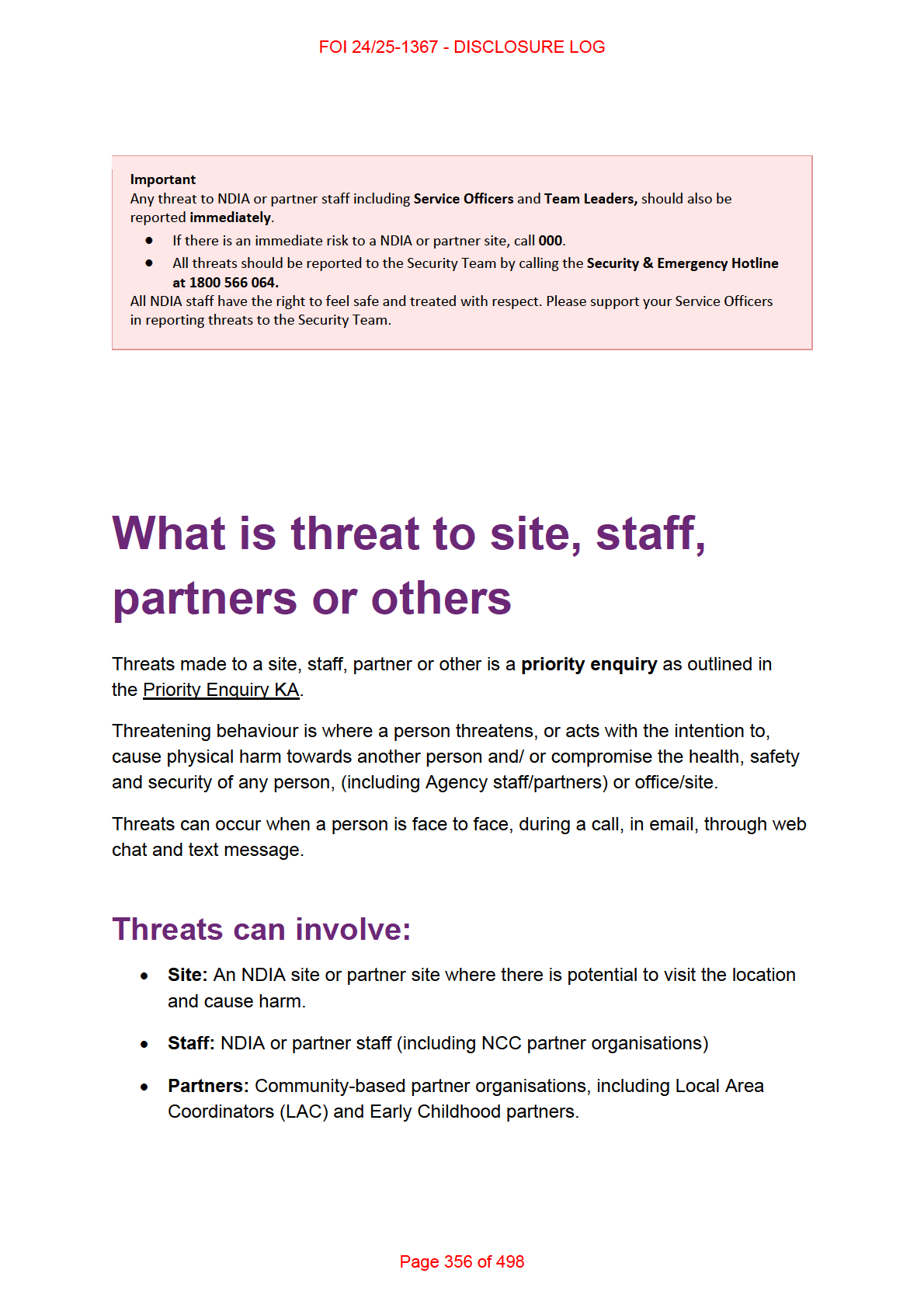
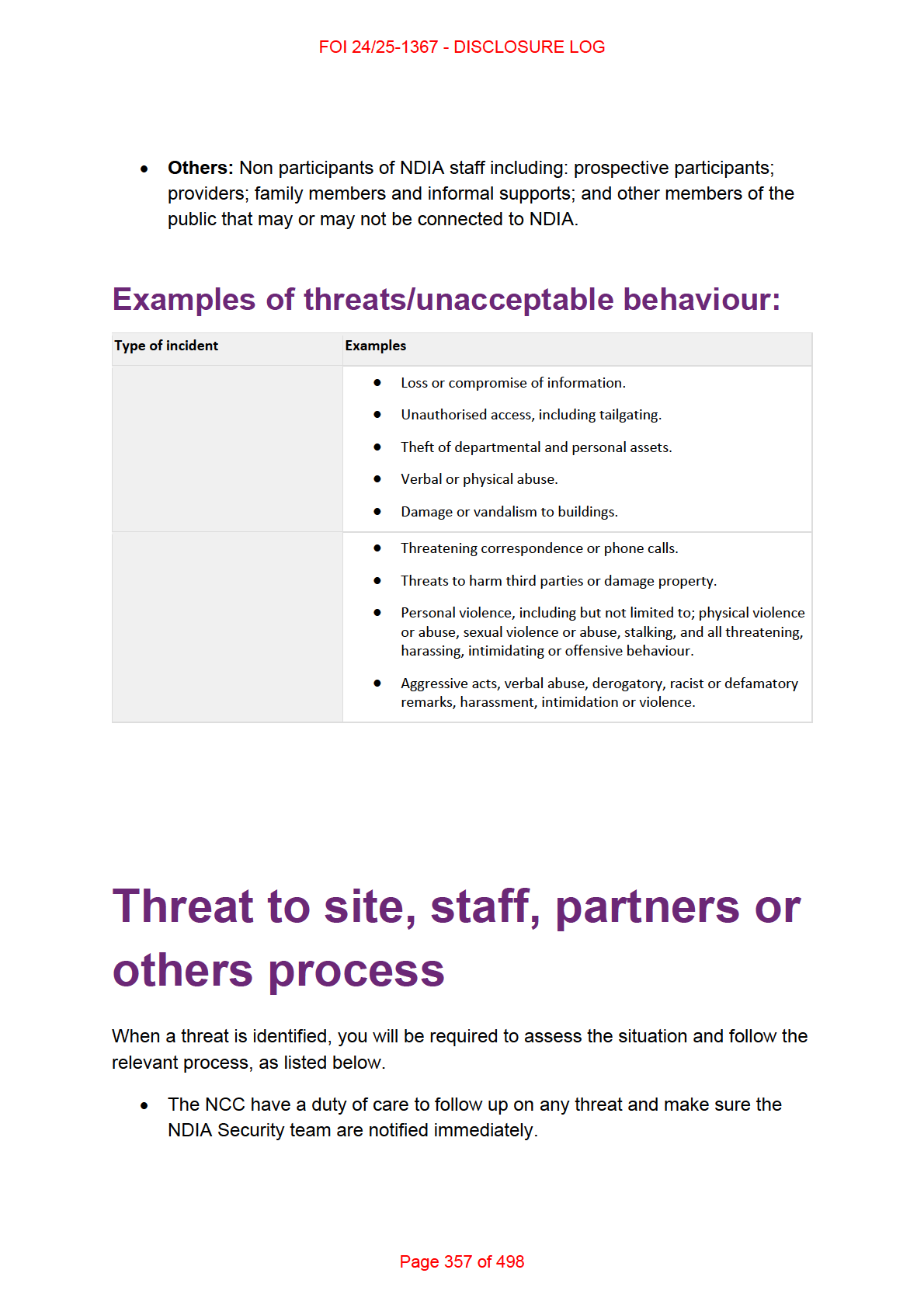
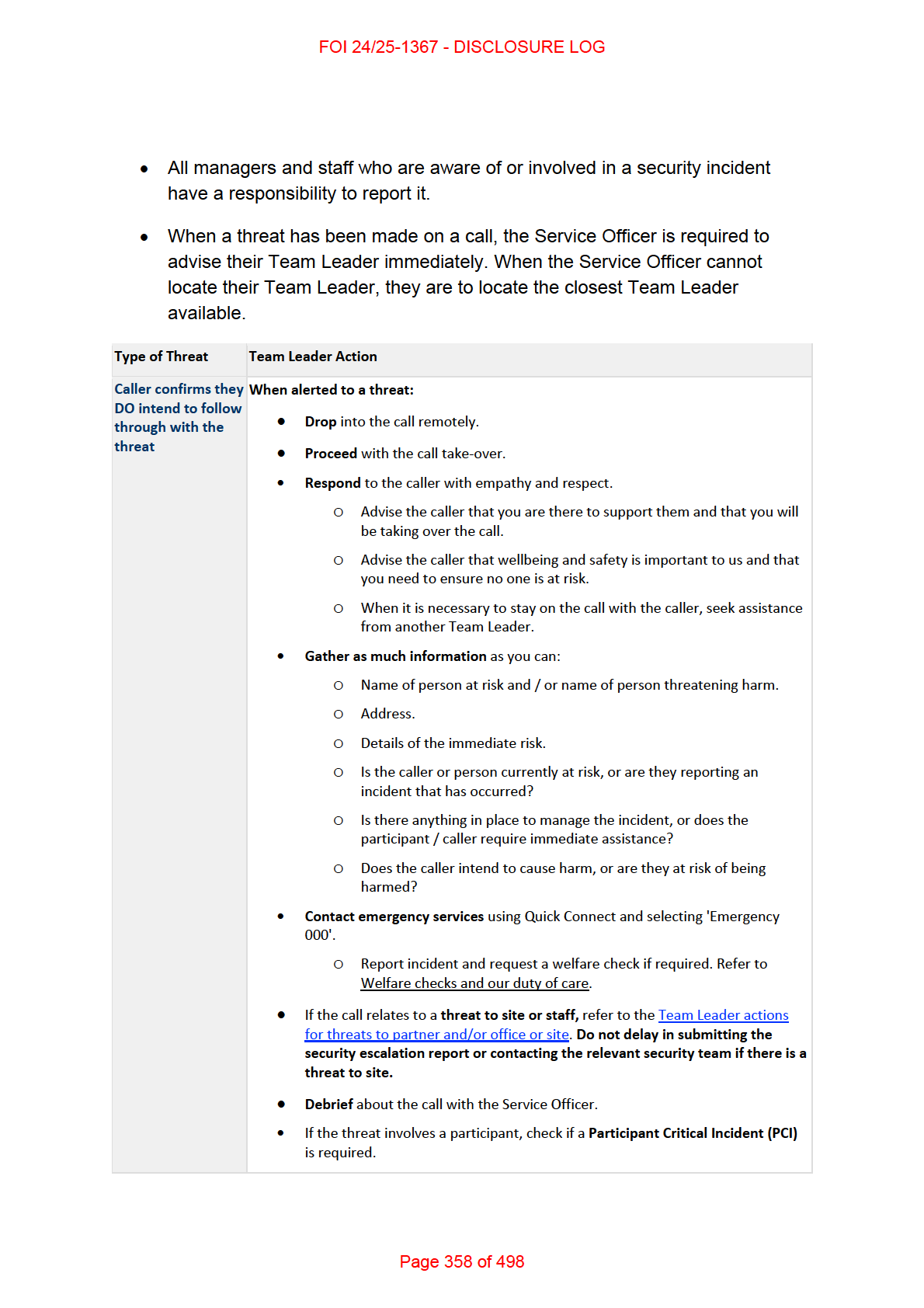
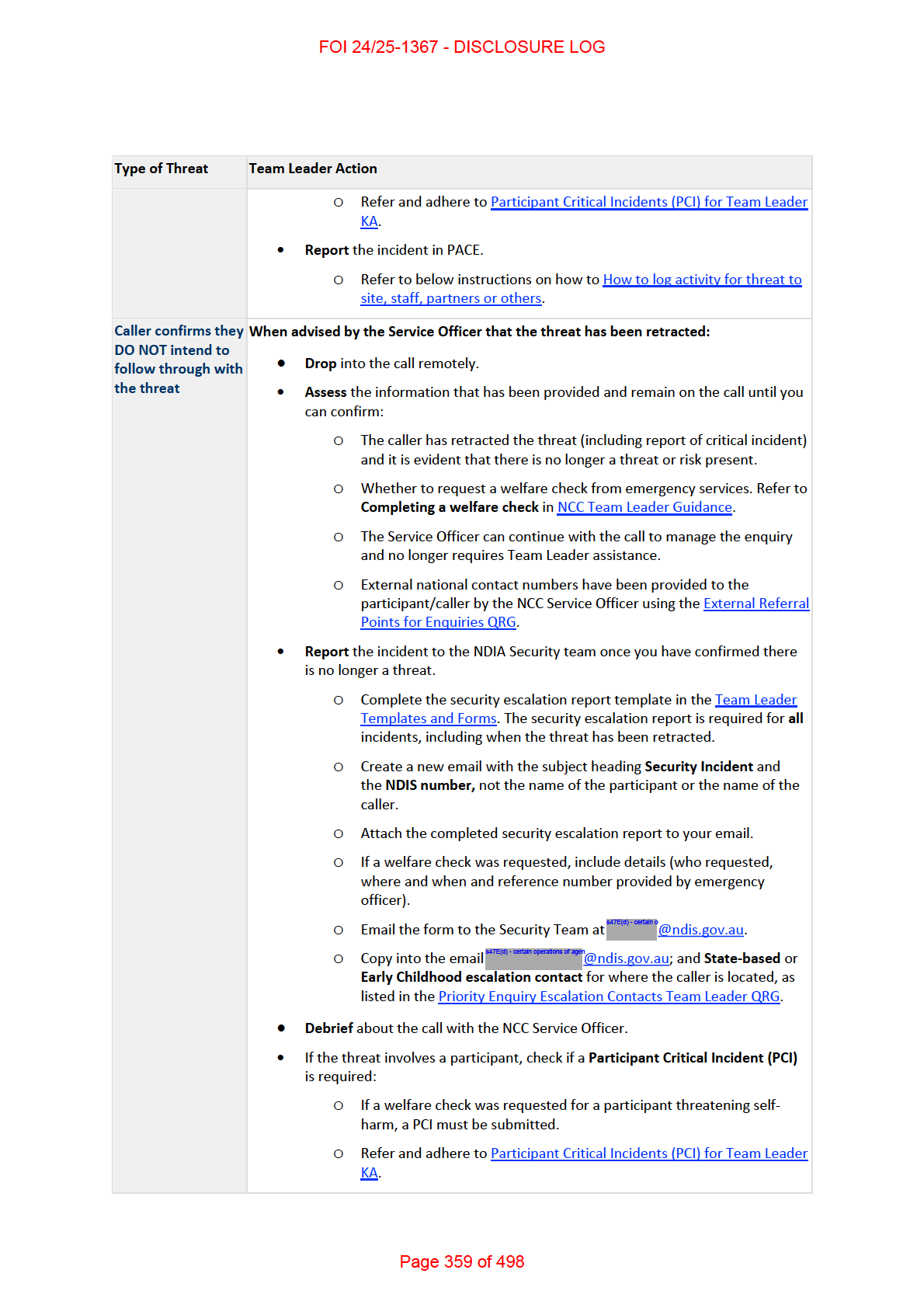
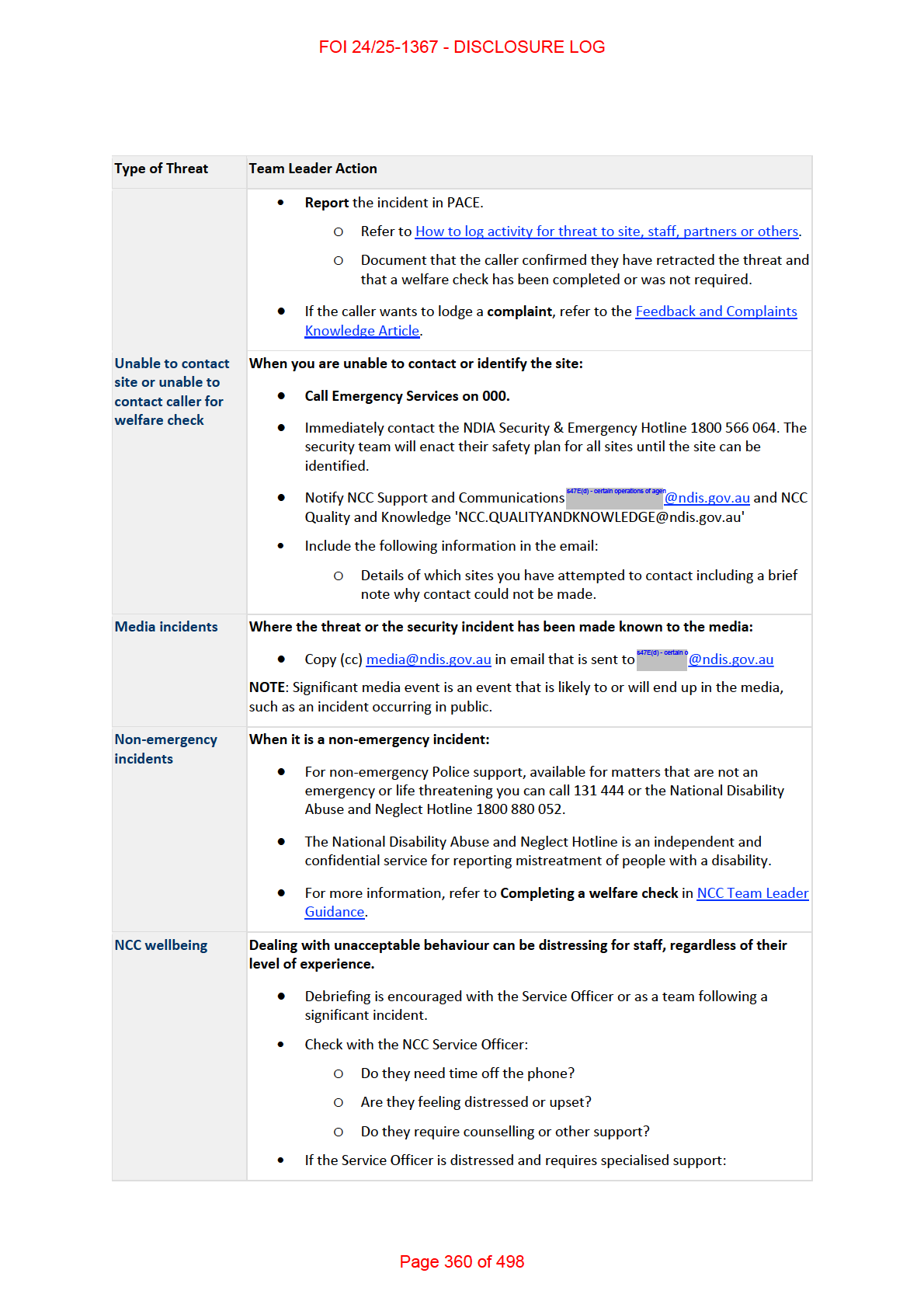
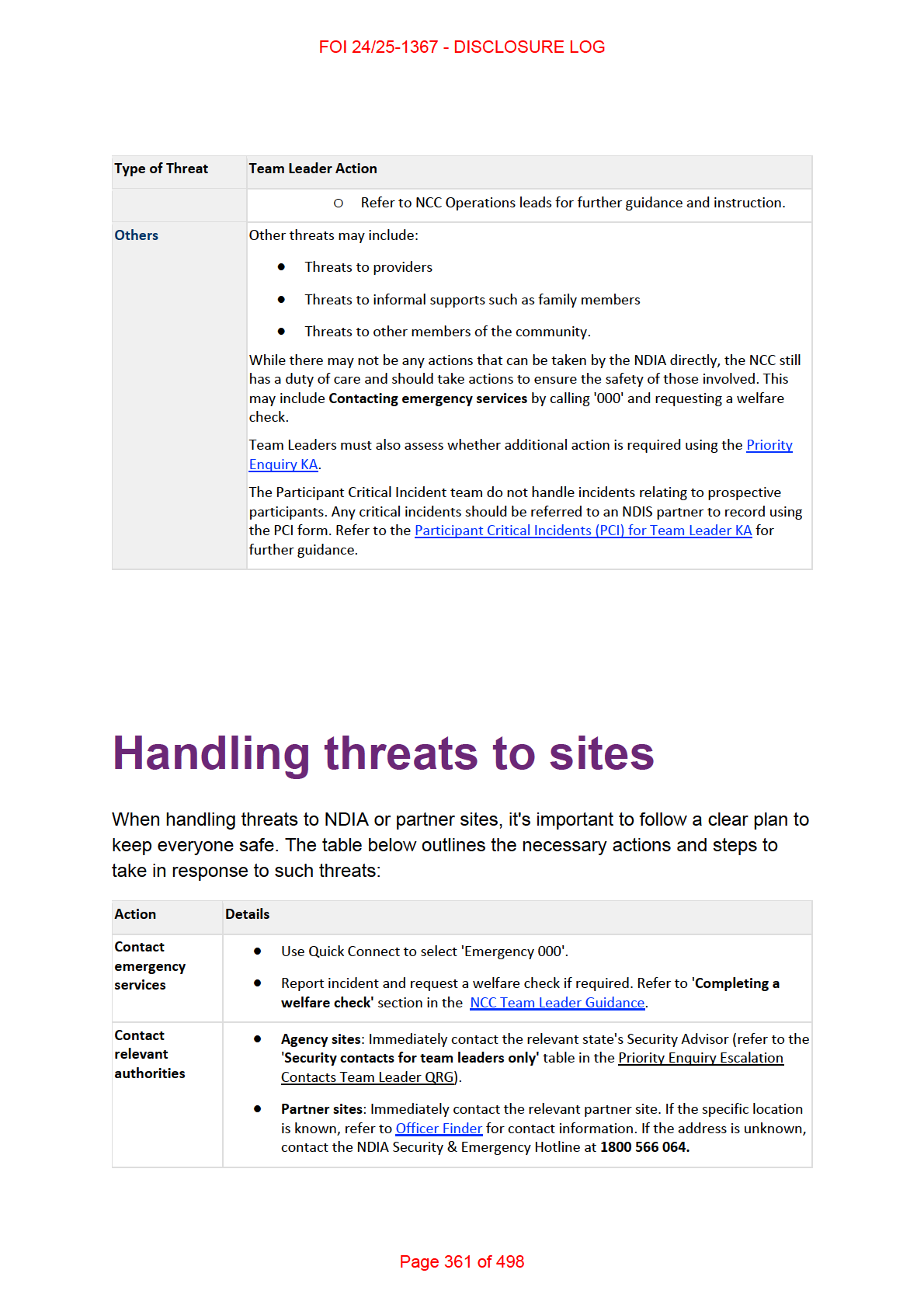
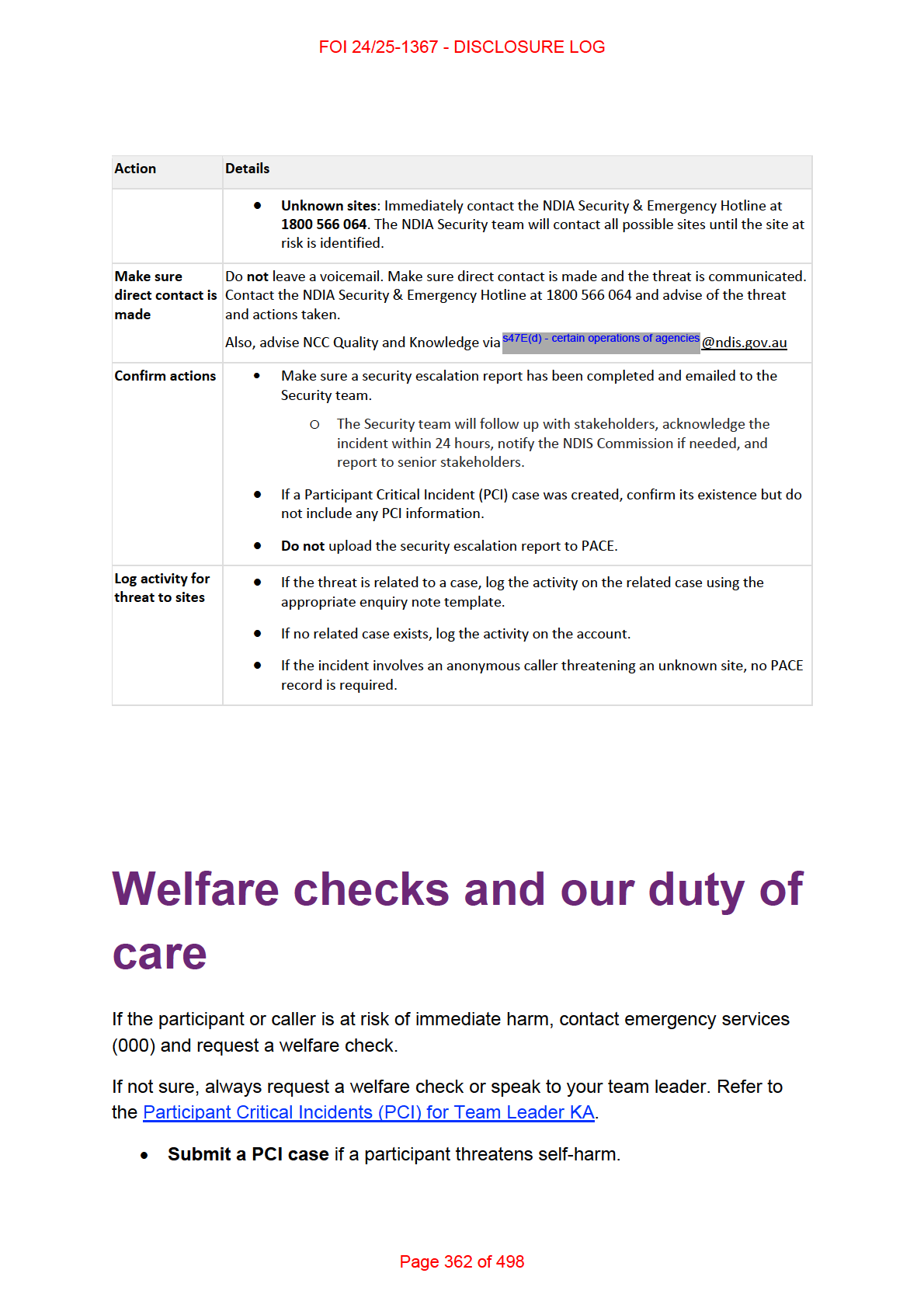
FOI 24/25-1367 - DISCLOSURE LOG
• If a threat is retracted but a welfare check was requested, a PCI is stil
required. The caller doesn't need to be an NDIS participant for a welfare
check.
• A PCI may involve any stakeholder, including NDIS providers, NDIA staff,
informal supports, family, or others.
• Record welfare checks for participants in a PCI case. Refer to
the
Completing a welfare check process on the NCC Team Leader
Guidance page.
Further information
Please refer to:
• NCC Team Leader Guidance
• Priority Enquiry KA
• Threat to Site, Staff, Partners, or Others Priority Enquiry KA
• Participant Critical Incidents (PCI) for Team Leader KA
• External Referral Points for Enquiries QRG
• Team Leader Templates and Forms
• Feedback and Complaints Knowledge Article
• Enquiry Cases and Log Activity in PACE KA
• NCC Escalations Queue Knowledge Article
Page 363 of 498
FOI 24/25-1367 - DISCLOSURE LOG
Enquiry note template
Please select the enquiry note template listed below that is appropriate for enquiry.
Team Leader Escalation
Date of escalation / call back: DD/MM/YYYY
Escalation requested by / call back to: Include name and relationship to
participant (if not participant).
Details of the query:
Requested phone number:
Action taken:
Name:
Log on ID:
Team Leader
National Contact Centre
Threat to NDIA Staff Partner of Other/s
Description: Security incident reported
Date of enquiry: DD/MM/YYYY
Person making enquiry: Include name and relationship to participant (if not
participant)
Details of the enquiry: Details are not to be recorded in PACE / For further
information about the incident reported please contact s47E(d) - certain operat@ nd
is.gov.au
Call take over by NCC Team Leader: Yes / No
Participant/Provider Phone Number: (include phone number of participant /
person that reported incident)
Welfare Check Done: Yes/No/Time of call
If yes reference number: Reference number provided by emergency services
Important: Any information about the incident is to be included in Escalation Form
only.
Escalation form emailed to Security team and Escalation Contact: Yes / No
Page 364 of 498
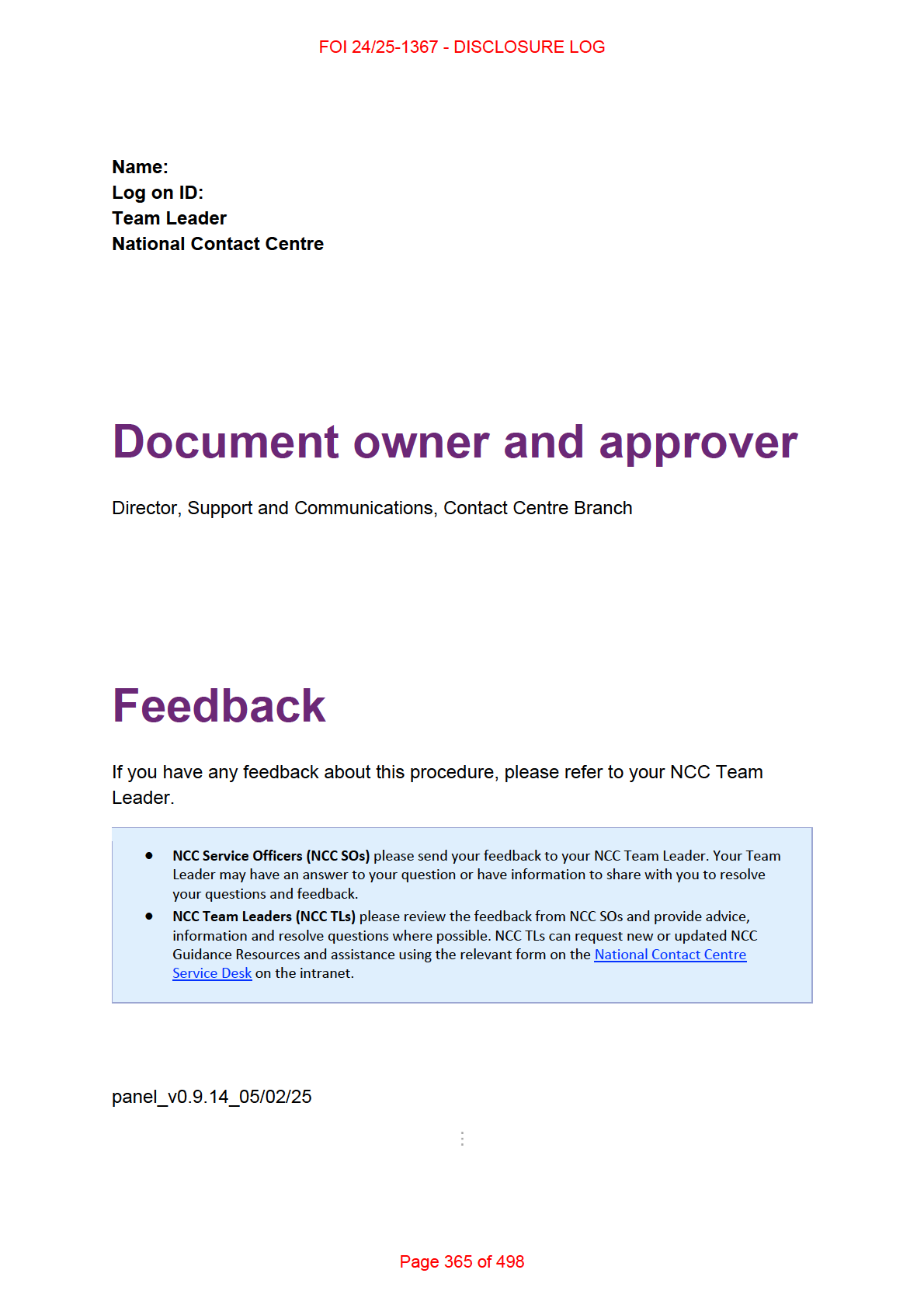
FOI 24/25-1367 - DISCLOSURE LOG
Search KNOWA 2.0:
Search
On this page:
• General
• Procedure
• Recent Updates
• What is threat to site, staff, partners or others
• Threat to site, staff, partners or others process
• Handling threats to sites
• Welfare checks and our duty of care
• Further information
• Enquiry note template
• Search KNOWA 2.0:
• On this page:
• Saved pages:
Page 366 of 498
FOI 24/25-1367 - DISCLOSURE LOG
• Recently viewed:
Saved pages:
Recently viewed:
Page 367 of 498
FOI 24/25-1367 - DISCLOSURE LOG
Page 368 of 498
FOI 24/25-1367 - DISCLOSURE LOG
DOCUMENT 24
Guide – Safeguarding the
participant’s interests – Context and
background
SGP KP Publishing
Exported on 2025-04-28 03:57:13
Page 369 of 498
FOI 24/25-1367 - DISCLOSURE LOG
Table of Contents
1 Recent updates . . . . . . . . . . . . . . . . . . . . . . . . . . . . . . . . . . . . . . . . . . . . . . . . . . . . . . . . . . 4
2 Before you start . . . . . . . . . . . . . . . . . . . . . . . . . . . . . . . . . . . . . . . . . . . . . . . . . . . . . . . . . . 5
3 Context in the Broader Framework . . . . . . . . . . . . . . . . . . . . . . . . . . . . . . . . . . . . . . . . . . 6
4 NDIA Context and Background. . . . . . . . . . . . . . . . . . . . . . . . . . . . . . . . . . . . . . . . . . . . . . 7
5 Critical incidents in the home or community . . . . . . . . . . . . . . . . . . . . . . . . . . . . . . . . . . 9
6 Next steps . . . . . . . . . . . . . . . . . . . . . . . . . . . . . . . . . . . . . . . . . . . . . . . . . . . . . . . . . . . . . . 11
Page 370 of 498
FOI 24/25-1367 - DISCLOSURE LOG
This article provides guidance for a
local area coordinator, early childhood partner and all
NDIA staff
(planner delegate, payments officer, internal review delegate, complaints
officer, participant support officer, access delegate, technical advisors, National Contact
Centre, liaison officers (HLO/JLO), complex support needs (CSN) planner, national
reassessment delegate) to understand safeguarding the participant’s interests in the context
of:
•
the broader framework
•
the NDIA
•
critical incidents in the home or community.
Note: For information about safeguarding in the planning process, go to article Guide –
Safeguarding the participant’s interests
.
Page 371 of 498
FOI 24/25-1367 - DISCLOSURE LOG
1 Recent updates
September 2023 This guidance comes from the Practice Guide – Safeguarding the participant’s interests
(sections 4, 5 and 6). We've made minor updates to change any NDIS Business System
language to PACE language. We'll make improvements to this guidance in the future.
Page 372 of 498
FOI 24/25-1367 - DISCLOSURE LOG
2 Before you start
You have read:
• Participant safeguarding policy (external)
Page 373 of 498
FOI 24/25-1367 - DISCLOSURE LOG
3 Context in the Broader Framework
Quality and Safeguarding Framework The NDIS Quality and Safeguarding Framework (external) was developed by the Department of
Social Services to support providers and the community. This framework provides a national
approach to empower the participant to exercise choice and control, with appropriate
safeguards in place. The framework also establishes expectations for providers to deliver high
quality services. The framework supports the NDIS Quality and Safeguards Commission
(external).
The NDIS Quality and Safeguards Commission (external) is responsible for receiving and
investigating allegations of reportable incidents. Reportable incidents are serious incidents or
allegations which result in harm to an NDIS participant and happen in connection with NDIS
supports and services. Refer to
Critical incidents in the home or community for more
information about the participant critical incident process.
If the participant is a younger person in residential aged care, you may also need to report to
the Department of Health and Aged Care – Aged care (external). This is communicated to the
participant by the NDIA.
National Disability Services Zero Tolerance Framework The National Disability Services Zero Tolerance Framework (external) helps providers
understand actions they can take to prevent and respond to abuse, neglect and violence of
people with a disability. This includes resources for provider staff to understand their
responsibilities in preventing and responding to abuse and to reinforce the human rights of
people using disability services.
The National Disability Abuse and Neglect Hotline The National Disability Abuse and Neglect Hotline (external) (the Hotline) is an independent and
confidential service for reporting abuse and neglect of people with disability. The Hotline works
to promote fair and just treatment of people with disability to achieve social justice, equality and
the same rights, responsibilities, opportunities, access and participation as other people in
Australian society.
For critical incidents in the home or community setting, escalation and reporting via the Hotline
is recommended. The Hotline can provide referral and connections to the most appropriate
agency to investigate and address the report.
The Hotline is closely aligned with the Complaints Resolution and Referral Service (CRRS).
Complaints Resolution and Referral Service Complaints to the CRRS (external) can be made by clients of services funded by the
Department of Social Services (DSS) under the Disability Services Act (1986). These services
include:
•
Disability Employment Services (DES)
•
Australian Disability Enterprises (ADEs)
•
Advocacy Services (funded by DSS).
Page 374 of 498
FOI 24/25-1367 - DISCLOSURE LOG
4 NDIA Context and Background
NDIA Incident Management Frameworks The NDIA Issues and Incident Management Framework creates a documented, streamlined
approach and is aligned to the NDIA risk management cycle.
The Issues and Incident Management Framework details the requirements for managing issues
in a consistent, methodical, risk-based approach. For more information, go to the Risk Advisory
Branch intranet page.
The Participant Critical Incident Framework helps NDIA staff and partners to determine the
necessary and appropriate actions required to respond to a participant critical incident.
A report of a participant critical incident is any information provided to the NDIA that alleges:
•
the death of an NDIS participant
•
serious injury of an NDIS participant
•
abuse or neglect of an NDIS participant
•
unlawful sexual or physical contact with, or assault of, an NDIS participant
•
sexual misconduct commit ed against, or in the presence of, an NDIS participant,
including grooming of the NDIS participant for sexual activity
•
the unauthorised use of a restrictive practice in relation to an NDIS participant
•
an NDIS participant threatening or attempting self-harm.
A participant critical incident allegation may involve any stakeholder including NDIS registered
providers, NDIA staff, informal supports, family or other person/s.
Participant critical incidents relating to unreasonable behaviour of the participant, or other third
party, should be managed by NDIA staff and partners consistent with the NDIA Managing
Unreasonable Behaviour policy and guidelines. This includes information, advice, reporting and
escalation protocols where the health, safety or security of staff, partners or others is at risk.
Reportable incidents The NDIS Quality and Safeguards Commission (NDIS Commission) is responsible for receiving
and investigating allegations of reportable incidents. Reportable incidents are serious incidents
or allegations which result in harm to an NDIS participant while they are receiving NDIS
supports or services.
Registered NDIS providers in all states and territories, except Western Australia, must notify
participant critical incidents that relate to services and provisions provided by a registered
provider. Notification must be made to the NDIS Quality and Safeguards Commission, under
s73Z of the NDIS Act 2013 and Part 3 of the NDIS (Incident Management & Reportable
Incidents) Rules 2018. For more information about notifiable participant critical incidents, go to
NDIS Quality and Safeguards Commission (external).
Critical Services Issues Response Each state and territory, together with the NDIA and DSS, have signed a Critical Services
Issues Response (CSIR) agreement to manage the escalation of critical issues that impact on
an individual, primarily an NDIS participant.
The CSIR is a process for coordinating the escalation of complicated and intractable matters
that impact an NDIS participant that can’t be resolved at the local level. Matters include issues
related to mainstream services, including but not limited to the following:
•
health and mental services
•
early childhood education
•
child protection and family support
•
school education
Page 375 of 498
FOI 24/25-1367 - DISCLOSURE LOG
•
vocational education and training
•
social housing
•
public transport
•
justice, including corrective services.
Page 376 of 498
FOI 24/25-1367 - DISCLOSURE LOG
5 Critical incidents in the home or community
People with disability are among some of the most vulnerable people in society and have the
right to freedom, respect, equality and dignity. They have the right to live to their full potential, to
have control over their own life and to live free from abuse or neglect.
Violence can be physical, sexual, intimidating or forceful. People with a disability may
experience violence from a carer or family member. This can happen at home or in a
community setting. Abuse is when actions violate another person’s human rights and can be
physical, mental, psychological, sexual or financial.
Neglect is the failure by a service provider or person caring for a person living with a disability to
provide adequate care.
Escalation and reporting to the National Disability Abuse and Neglect Hotline (external) is
recommended for critical incidents in the home or community setting. Referral and connections
may be provided to the most appropriate agency to investigate or address the report. The
principles in the Participant Critical Incident Framework should be followed to make contact with
the Hotline and
escalate to a line manager before any report is made. After escalation and
full consideration, it may also be necessary to make a police report.
Note: The Hotline is not a crisis service. Life-threatening situations should be reported
immediately to emergency services by calling 000. There may be situations where allegations are made about critical incidents involving NDIA or
partner staff. Al Australian Public Service (APS) employees must comply with the APS Code of
Conduct and APS Values and Employment Principles. Go to the Australian Public Service
Commission (external) for more information.
There is a duty to report inappropriate behaviour and suspected misconduct. Perceived
inappropriate behaviours or allegations received about a staff member should be discussed with
or reported to a senior manager. The matter can also be discussed with People and Culture.
Partner staff are expected to share the NDIA values, however are not direct APS employees.
Partners are independent organisations with their own employment guidelines, policies and
processes. As a partner, there is a contractual obligation to report serious complaints regarding
staff, breaches or incidents. Under the NDIA Issues and Incident Management Framework, this
information is reported and investigated by the NDIA.
NDIA Participant Critical Incidents Framework The Participant Critical Incident Framework details your roles and responsibilities when you
suspect or receive information about an alleged critical incident including abuse, neglect or
exploitation. Anyone can report a critical incident to the NDIA, including partner staff.
The framework helps you determine what to do when you suspect or obtain information,
indicating a critical incident or concern for a person with disability who may be subject to abuse,
neglect or exploitation.
This framework complements the broader NDIA Issues and Incident Management Framework,
which uses a risk-based approach to provide overarching guidance to managing issues and
incidents in a consistent and methodical manner.
When responding to reports of critical incidents, the NDIA and partners may disclose
information to relevant authorities such as police or child protection services if:
•
the consent of the individual is obtained (s60(2)(d)(i i) of the NDIS Act 2013)
•
staff have reasonable grounds to believe that the disclosure is necessary to prevent or
lessen a serious threat to the individual’s life, health or safety (s60(2)(e) of the NDIS Act
2013).
For more information, go to articles:
•
Identify participant risk factors and vulnerabilities
•
Understand system generated risk flags
Page 377 of 498
FOI 24/25-1367 - DISCLOSURE LOG
Exceptional y Complex Support Needs Program The Exceptionally Complex Support Needs Program (ECSNP) is designed to contribute to
growing market and community capacity to support participants with exceptionally complex
support needs.
The ECSNP enables the NDIA to respond to participant crisis situations that can’t be supported
by regular NDIA functions, including the CSIR and Complex Support Needs Pathway.
The ECSNP has 3 functions:
Sector and community development and delivery activities This includes workshops, training sessions and individual engagement with mainstream and
community services (such as health services and justice services). The aim of these activities is
to support the growth and capability of people working with participants with complex support
needs. This work wil also build capabilities, knowledge and skil s of NDIS providers who work
directly with participants with complex support needs.
Subject matter expertise activities This includes providing guidance and advice to services for specific issues related to providing
support for people with exceptionally complex support needs. The program providers wil also
provide skil ed support coordinators to support a participant if required.
Crisis referral activities This is for approved referrers (key emergency service responders) and wil only accept referrals
for participants over 18 years.
Approved referrers to ECSNP include:
•
Key emergency services organisations – state police services, state ambulance
services, hospitals (public and private)
•
Acute state mental health services
•
Australian Federal Police
•
State justice officers.
Page 378 of 498
FOI 24/25-1367 - DISCLOSURE LOG
6 Next steps
Related knowledge articles:
•
Guide – Safeguarding the participant’s interests for information specific to
planning processes
Related internal guidance:
•
Participant Critical Incident Framework
Related external guidance:
•
Our Guideline – Your privacy and information (external)
•
NDIS Safeguards (external)
•
What principles do we follow to create your plan? (external)
•
When do we make priority eligibility decisions? in Our Guideline – Applying to the
NDIS (external)
•
Our Guideline – Your plan (external)
•
Our Guideline – Justice system (external)
Page 379 of 498
FOI 24/25-1367 - DISCLOSURE LOG
DOCUMENT 25
Guide - Conversation style guide
appendix A
SGP KP Publishing
Exported on 2025-04-28 03:51:30
Page 380 of 498
FOI 24/25-1367 - DISCLOSURE LOG
Table of Contents
1 Recent updates . . . . . . . . . . . . . . . . . . . . . . . . . . . . . . . . . . . . . . . . . . . . . . . . . . . . . . . . . . 4
2 Before you start . . . . . . . . . . . . . . . . . . . . . . . . . . . . . . . . . . . . . . . . . . . . . . . . . . . . . . . . . . 5
3 During the conversation . . . . . . . . . . . . . . . . . . . . . . . . . . . . . . . . . . . . . . . . . . . . . . . . . . . 6
Page 381 of 498
FOI 24/25-1367 - DISCLOSURE LOG
This article provides guidance for an
access delegate, bereavement officer, business
support officer, complaints officer, compensation delegate, early childhood partner,
enrolment officer, external review officer, home and living delegate, internal review
delegate, liaison officers, local area coordinator, national reassessment delegate,
National Contact Centre, participant critical incidents officer, participant support officer,
payment officer, planner delegate and
planner (non-partnered area) to:
•
understand techniques to use during the conversation.
Page 382 of 498
FOI 24/25-1367 - DISCLOSURE LOG
1 Recent updates
October 2023 Recent guidance.
Page 383 of 498
FOI 24/25-1367 - DISCLOSURE LOG
2 Before you start
You have read and understood:
•
article Guide – Conversation style guide.
Page 384 of 498
FOI 24/25-1367 - DISCLOSURE LOG
3 During the conversation
Set up a col aborative conversation It’s important to recognise the way you structure and conduct a conversation contributes to a
person feeling
listened to, respected and empowered.
That is why you wil work collaboratively with the person to establish some structure for the
conversation.
You wil spend a few minutes at the start of the conversation discussing the reason you and the
person are speaking. This wil help you both reach a mutual understanding about the purpose of
the conversation and make the best use of your time together. This does not need to be written
down or completed formally.
You can set up a collaborative conversation by:
•
introducing yourself by name to the person
•
explaining your role with the NDIA and how you may be able to help
•
explaining the purpose of the conversation, including:
o why you are having the conversation
o what you need from the person you are speaking to
o how long you think the conversation wil take
o giving an opportunity for the person to identify anything they would like to
discuss
o reaching an understanding of the outcome you are both seeking.
Prompts to support a collaborative conversation
•
Today I need to find out a bit more about you so I can make the best decision about
your request/plan, is there anything you would like to talk about in this conversation?
•
We may not have time to discuss that today. I can show you where to find more
information at the end of this conversation if that would help?
•
If we are getting off track, how would you like me to remind you of the structure we set
for our conversation?
Before you continue the conversation ensure the person you are speaking with:
•
understands the structure you have set together
•
has the support they need to participate in the conversation
•
is happy to proceed with the conversation.
You wil do this for all conversations, whether by phone, face-to-face or through another channel
such as web-based.
To learn more about phone and web-based conversations, refer to article Guide – Conversation
style guide appendix B – Navigating different types of conversations.
Prompts to check the person’s understanding and comfort
•
It sounds like the purpose of our conversation today is … does that should right to you?
•
Based on what we have discussed, are you happy to continue our conversation?
•
Is there anything else you need to feel supported during this conversation?
Page 385 of 498
FOI 24/25-1367 - DISCLOSURE LOG
Always explore safeguarding A general principle which guides our actions under the NDIS Act, is the support of people with
disability to exercise choice. This includes respecting the rights of people to take reasonable
risks when making choices about how they want to live their life.
Your conversation with the person provides an opportunity for open discussion to identify any
actual and potential risks.
You can use the conversation to encourage the person to develop their own strategies and
safeguards to reduce their potential exposure to harm. This wil help you decide if you also need
to put additional safeguards in place.
For more information, refer to article Guide – Safeguarding the participant’s interests.
For participants: The Participant Critical Incidents Framework helps you know what to do if
you suspect or obtain information that a participant may be:
• subject to physical, emotional or financial abuse, neglect or exploitation
• at risk of suicide or self-harm
• at risk of harming others.
Refer to the Participant Critical Incidents page on the intranet for more information.
For other people: You wil immediately alert your line manager if you suspect or obtain
information that a person may be:
• subject to physical, emotional or financial abuse, neglect or exploitation
• at risk of suicide or self-harm
• at risk of harming others.
If a person is at immediate risk of harm you should:
• call 000 to contact the appropriate emergency service
• alert your line manager as soon as possible.
Prompts to explore the persons safeguards
• Can you tell me about a typical day for you?
• Who helps you if things go wrong or you need to talk to someone?
• What sort of things do you enjoy doing?
• Who do you like spending time with?
• What do you think about when choosing a provider?
• Who would you speak to if you think a provider or support person isn’t treating you
fairly?
• Refer to the Responding to Suicide and Self-Harm Fact Sheet for more information.
Safeguarding conversations can be emotionally tough. There are techniques in article Guide –
Conversation style guide appendix B – Navigating different types of conversations to help you
talk about safeguarding with people who contact us.
Set the tone
Page 386 of 498
FOI 24/25-1367 - DISCLOSURE LOG
You have the same voice all the time, but your tone changes. The tone you use at the start of
the conversation wil influence whether the person feels that you are listening to them. It wil get
the conversation off to a good start and show that you are interested in their circumstances and
concerns. Adjust the rhythm and volume of your voice depending on the person’s ability to hear
you clearly and their level of understanding. You wil also change your tone depending on the
emotional state of the person you are talking to. For example, you would use a different tone of
voice to talk to a person who is nervous or upset than you would with someone who is more
relaxed.
Build rapport The mirroring technique builds a connection and rapport with the person. Where appropriate,
use some of the same words (keywords) or phrases as the person you speak to. Mirroring can
give the person the feeling they are talking with someone familiar and so the conversation is
easier and more comfortable. Don’t try to copy the person as this wil not be your usual style
and may come across as false or unapproachable. Remember a person’s outward gestures
may not always mean what you think they do, so use your judgement when you think mirroring
is useful.
Tips for rapport building
•
Mirror a person’s tone of voice, rate of speech and word choice
•
Use friendly, neutral and respectful communication to show and guide the participant to
mirror your communication
•
Listen and use the participant’s keywords in conversation and in your questions
•
Note down keywords.
Actively listen Active and effective listening is a very important communication technique that requires you to
provide verbal and non-verbal feedback to people. It shows them you are listening and
understanding. You need to fully concentrate on the person and understand and respond to
their needs, not just hear what they are saying. At times a conversation may include a third
party, interpreter or National Relay Officer so your strong active listening skil s wil be valuable
here.
Active listening requires you to listen with all your senses. Convey your interest and your focus
on the person by:
•
using both verbal and non-verbal messages such as maintaining eye contact if this is
possible for the person, nodding your head and smiling
•
allowing the person to finish everything they are saying before you respond
•
encouraging the person to continue
•
use paraphrasing to make sure you understand what the person has said.
When you provide this feedback and level of interest, the person wil usually start to feel more at
ease and therefore communicate more easily, openly and honestly.
Prompts to check your understanding
•
So from what you are saying John can only access public transport with your
assistance?
•
Just to check I am hearing you correctly, it sounds like you support John to manage his
finances?
•
Just so I am sure I have understood you correctly, I am hearing you would like to self-
manage your plan. Is that correct?
Page 387 of 498
FOI 24/25-1367 - DISCLOSURE LOG
It may take some time for the person to tell you about their circumstances and needs. Take time
to build trust. During the conversation, if you remain silent the person may feel like they are not
being understood or that you are not listening to them.
Don’t make assumptions – listen to what is being said and consider all information available to
you.
We can gently encourage the person to use active listening, too. The person may have spent a
lot of time preparing for the conversation with you. They may want to give you lots of information
about their life, their progress and what they think about their interactions with us. You may
need to encourage the person to slow down and listen to your questions or your explanations.
You could lower your voice and speak more slowly and quietly to encourage them to listen
intently to hear you. You can also gently and respectfully remind them of the structure you set at
the start of the conversation to help bring their focus back.
An authentic, two-way conversation relies on both of you listening, understanding and being
open and honest.
Prompts to check for mutual understanding
•
Before we move onto the next question, I am going to repeat what you have told me to
make sure I have heard you properly.
•
Let’s pause here and go over what we have spoken about.
•
Can I check that I have explained that properly? Can you tell me what you think the
next steps are?
Checking you understand what the person has said demonstrates active listening. It isn’t just
about showing you are actively listening or checking facts; you can also use it to help the
person think through what they are saying or reporting they are doing. This is also a useful way
of owning a misunderstanding, and not making the person feel frustrated because they can’t get
their point across.
More prompts to check your understanding
•
I think I’ve confused things, did you say…?
•
I think I’ve got this wrong, did you just say…?
Ask effective questions Using the right questions at the right time in the conversation wil allow you to have a genuine
conversation with the person. It wil build rapport and direct the conversation to cover the things
you need to discuss.
Open questions connect you and the person together as you gather information. Asking open
questions gives the person an opportunity to give you a longer full answer and draw on their
lived experience and feelings. Open questions also give you more time to understand the
person’s current circumstances and needs.
Open question prompts
•
What does a normal day look like for you?
•
What do you enjoy doing?
•
How have you been getting on with your support worker?
•
How do you get to your appointments?
•
What would you like to do more of?
Page 388 of 498
FOI 24/25-1367 - DISCLOSURE LOG
•
What type of assistance do you need to cook meals?
Closed questions can be useful when you need a specific response or a simple “yes” or “no”.
You may choose to use closed questions to bring a discussion topic to a close. Closed
questions also help to find out a specific piece of information so that you can find something in
the person’s record.
Closed question prompts
•
Does your support worker visit your home every day?
•
How often do you catch up with your friend Jane?
•
Do you always need someone to help you to prepare your meals?
•
How often do you go to work at the coffee shop?
•
How long has John lived at Shipton Grove?
Probing questions are another way to find out more details. Probing questions wil help you to
get clarification, ensure you have the whole story and that you understand it thoroughly. They
can draw detailed information from the person if they are unsure or uncertain about the
conversation.
Probing question prompts
•
To help me understand, can you please give me an example of how you support John
to access the community?
•
Can you tell me a bit more about how you use your 4 wheel walker at home?
•
I heard you say that spending more time outdoors is important to you, could you tell me
a bit more about what that would look like?
Leading questions help you manage the conversation to resolution, in a way that allows the
person to make choices and have control over the outcome. Leading questions might help you if
you need to manage the conversation to move on from a particular topic. Leading questions
also help if you need to test how the person feels about a particular idea. You can use
assumptions in your questions to introduce information and suggest alternative approaches or
processes to the person. Leading questions also give you the opportunity to give the person a
choice between options.
Leading question prompts
•
Shall we go ahead and look at the steps for starting to self-manage your plan?
•
Let’s discuss the information we need from your occupational therapist. I can provide
some examples. Would that be helpful?
•
I can walk through the next steps with you now, over the phone. Or, I can help you find
where the information you need is on the NDIS website so you can look over it late?
To learn more about having conversations, refer to articles:
Guide – Conversation style guide
Guide – Conversation style guide appendix B – Navigating different types of conversations
Page 389 of 498
FOI 24/25-1367 - DISCLOSURE LOG
DOCUMENT 26
Understand participant critical
incidents
SGP KP Publishing
Exported on 2025-04-28 03:00:01
Page 390 of 498
FOI 24/25-1367 - DISCLOSURE LOG
Table of Contents
1 Recent updates . . . . . . . . . . . . . . . . . . . . . . . . . . . . . . . . . . . . . . . . . . . . . . . . . . . . . . . . . . 4
2 The importance of responding to critical incidents . . . . . . . . . . . . . . . . . . . . . . . . . . . . . 5
3 Types of participant critical incidents . . . . . . . . . . . . . . . . . . . . . . . . . . . . . . . . . . . . . . . . 6
4 Unexplained death of a participant connected with NDIS supports or services . . . . . . 7
5 Serious injury of a participant . . . . . . . . . . . . . . . . . . . . . . . . . . . . . . . . . . . . . . . . . . . . . . 8
6 Abuse or neglect of a participant . . . . . . . . . . . . . . . . . . . . . . . . . . . . . . . . . . . . . . . . . . . . 9
7 Unlawful sexual or physical contact with, or assault of, a participant . . . . . . . . . . . . . 10
8 Sexual misconduct committed against, or in the presence of, the participant,
including grooming for sexual activity . . . . . . . . . . . . . . . . . . . . . . . . . . . . . . . . . . . . . . . . . . 11
9 Unauthorised restrictive practice . . . . . . . . . . . . . . . . . . . . . . . . . . . . . . . . . . . . . . . . . . . 12
10
Threat or attempt of self-harm or suicide . . . . . . . . . . . . . . . . . . . . . . . . . . . . . . . . . . 13
11
Incidents that fit more than one criteria . . . . . . . . . . . . . . . . . . . . . . . . . . . . . . . . . . . . 14
12
Near misses . . . . . . . . . . . . . . . . . . . . . . . . . . . . . . . . . . . . . . . . . . . . . . . . . . . . . . . . . . 15
13
Response pathways . . . . . . . . . . . . . . . . . . . . . . . . . . . . . . . . . . . . . . . . . . . . . . . . . . . . 16
14
Next steps . . . . . . . . . . . . . . . . . . . . . . . . . . . . . . . . . . . . . . . . . . . . . . . . . . . . . . . . . . . . 18
Page 391 of 498
FOI 24/25-1367 - DISCLOSURE LOG
This article provides guidance for a
local area coordinator, early childhood partner, planner
delegate, internal review delegate, complaints officer, participant support officer,
National Contact Centre, liaison officers (HLO/JLO), and
complex support needs (CSN)
planner to understand:
•
the importance of responding to participant critical incidents
•
types of participant critical incidents
•
incidents that fit more than one criteria
•
near misses
•
response pathways.
Page 392 of 498
FOI 24/25-1367 - DISCLOSURE LOG
1 Recent updates
October 2023 Current guidance.
Page 393 of 498
FOI 24/25-1367 - DISCLOSURE LOG
2 The importance of responding to critical incidents
The National Disability Insurance Agency (NDIA) recognises that people with disability can be
vulnerable to harm. This might include abuse, neglect and exploitation. While working with
participants, their families and carers, you may encounter situations, or become aware of
allegations, of serious harm or abuse.
People with disability have the same right as other Australians to have their worth, privacy and
dignity respected. They have the right to live free from abuse, neglect and exploitation. We also
need to consider the best interests of children and young people, and to protect them from
harm.
Participants may experience, or be impacted by, a range of incidents in different settings.
A participant critical incident (PCI) allegation may involve any stakeholder. This could include
NDIA staff, partners, providers, informal supports, and family or others.
The way we respond to participant critical incidents aligns with the broader Issues and Incident
Management Framework. There is a ‘no wrong door’ approach to providing feedback,
complaints and other matters to the NDIA.
To learn about critical incidents involving non-participants, go to article Understand critical
incidents involving non-participants.
Page 394 of 498
FOI 24/25-1367 - DISCLOSURE LOG
3 Types of participant critical incidents
A PCI report is any information provided to the NDIA, National Contact Centre (NCC) or
Partners that alleges an event occurred involving the following:
• unexplained death of a participant connected with NDIS supports or services
• serious injury of a participant
• abuse or neglect of a participant
• unlawful sexual or physical contact with, or assault of, a participant
• sexual misconduct commit ed against, or in the presence of, the participant, including
grooming for sexual activity
• unauthorised restrictive practice
• threat or attempt of self-harm or suicide.
You might become aware of these through a report, al egation, or observation.
There are other appropriate pathways to progress notifications that don’t meet the PCI criteria.
The PCI team can educate the team lodging the incident about the appropriate notification
pathway.
To learn about incidents that aren’t participant critical incidents, go to article Understand other
incidents. This includes guidance on:
• Security incidents
• Managing unreasonable behaviour
• Issues and incident management framework
• Business continuity management
• Work, health and safety incidents
• Risk
• Legal.
Page 395 of 498
FOI 24/25-1367 - DISCLOSURE LOG
4 Unexplained death of a participant connected with
NDIS supports or services
For example, a death where its circumstances or cause are medically or legally unexplained.
This might occur in the context of medical care, suicide, neglect or suspected criminal activity.
Page 396 of 498
FOI 24/25-1367 - DISCLOSURE LOG
5 Serious injury of a participant
For example:
•
An act which has injured a participant, like a fracture, bruise, wound, burn or
concussion.
•
A participant being physical y assaulted by a carer, support person, family member, or
member of the community which causes serious harm or injury.
•
Serious injury of a participant whilst receiving NDIS supports.
Page 397 of 498
FOI 24/25-1367 - DISCLOSURE LOG
6 Abuse or neglect of a participant
For example:
•
A family member, carer or support person denying food to a participant as ‘punishment’.
•
A participant subjected to use of offensive, abusive, or demeaning language by a
support person.
•
A family member, carer or support person threatening harm to a participant.
•
A participant being financially exploited.
•
Abandonment of a participant.
Page 398 of 498
FOI 24/25-1367 - DISCLOSURE LOG
7 Unlawful sexual or physical contact with, or assault
of, a participant
For example:
• Inappropriate physical contact between a participant and a carer, support person, family
member, or a member of the community.
• Rape or sexual assault of a participant. This includes any sexual contact or behaviour
without the participant’s explicit consent.
• A participant being physical y assaulted by a carer, support person, family member, or
member of the community.
Page 399 of 498
FOI 24/25-1367 - DISCLOSURE LOG
8 Sexual misconduct committed against, or in the
presence of, the participant, including grooming for
sexual activity
For example:
•
Sexual conduct in the presence of a participant.
•
A person has developed a relationship with a participant with the intent of facilitating the
participant’s involvement in sexual conduct. This could be either with themselves or
another adult. This doesn’t necessarily involve any sexual activity, or even discussion of
sexual activity. It may only involve establishing a relationship to facilitate sexual activity
later.
Page 400 of 498
FOI 24/25-1367 - DISCLOSURE LOG
9 Unauthorised restrictive practice
For example:
•
Use of restrictive practices without authorisation where the relevant State or Territory
has an authorisation process. For example, seclusion, chemical, mechanical, physical,
environmental, psycho-social restrictive practices.
•
A family member or support person secluding or restraining the participant.
To learn more about what is considered restrictive practice, go to article Behaviours of concern
and restrictive practices.
Page 401 of 498
FOI 24/25-1367 - DISCLOSURE LOG
10 Threat or attempt of self-harm or suicide
This refers to a specific event and does not include progressively escalating behaviours of
concern.
For example:
•
The participant threatening self-harm or suicide.
•
The participant has self-harmed or attempted suicide.
Page 402 of 498
FOI 24/25-1367 - DISCLOSURE LOG
11 Incidents that fit more than one criteria
An incident might meet the criteria of both a participant critical incident and another type of
incident. You should escalate these by both processes. For example, contacting the Security
Team, Work Health and Safety Team and also creating a participant critical incident case.
Sometimes it’s not easy to decide if an incident is critical or related to another type of matter.
You should speak to a line manager or the PCI team to determine the best option for the
situation.
To help you work this out, you should think about:
•
Did a specific event happen?
•
Does the allegation relate to a participant being harmed, or at risk of harm, from others’
actions?
•
Who is alleged to have harmed the participant? Is it a provider, informal support or
other person?
•
Is the participant threatening, abusing or being aggressive toward others?
•
What is the nature of the allegation?
•
Where and when did the alleged incident occur?
•
Is there a threat of self-harm?
•
Is there an indication a provider or informal support has neglected a participant?
Learn more in article Understand other incidents.
Page 403 of 498
FOI 24/25-1367 - DISCLOSURE LOG
12 Near misses
Sometimes a participant may be in an unplanned high-risk situation, but an incident has not yet
occurred. If you receive a report of potential risks, think about implementing mitigation strategies
to prevent an incident occurring.
You can stil create a PCI case, and note that appropriate actions have been taken to ensure
the participant’s safety and wellbeing. To create a PCI case, go to article Create a participant
critical incident case.
The PCI team would categorise this as a
Near Miss, noting there may stil be risk, but an
incident hasn’t yet occurred.
Page 404 of 498
FOI 24/25-1367 - DISCLOSURE LOG
13 Response pathways
You may be notified of a potential risk, for example an unstable environment, or a threat to
homelessness. Unless a specific event has occurred, you may need to assess if the situation is
a PCI. Or, if you need to refer it to the appropriate business area for action.
The examples below wil help you determine the appropriate response pathway.
Child Protection involvement Unless a specific incident or event has occurred, Child Protection involvement alone is not a
PCI. The participant’s Service Delivery area should investigate the welfare of the child and if the
participant needs changes to their plan. For example:
•
Child Protection is involved with the family.
•
No specific incident has been reported.
•
You suspect on reasonable grounds a child is at risk of significant harm.
•
The Education Department has raised concerns regarding Child Protection
involvement.
•
A family member has raised concerns regarding Child Protection involvement.
If an incident has occurred to prompt a referral to Child Protection, create a PCI case to refer it
to the PCI team. For example:
•
Child Protection are involved because a specific incident happened.
•
You suspect on reasonable grounds a child is at risk of significant harm because an
incident has occurred.
Restrictive practice Restrictive practice means any practice or intervention that restricts a person with disability’s
rights or freedom of movement. Under the NDIS (Restrictive Practices and Behaviour Support)
Rules 2018 (external), certain restrictive practices are subject to regulation. These are not a
PCI. These regulated restrictive practices include seclusion, chemical restraint, mechanical
restraint, physical restraint and environmental restraint. A provider who uses regulated
restrictive practices needs to provide monthly reports to the NDIS Quality and Safeguards
Commission.
For example:
•
The participant is not allowed to access tools that may cause harm. For example,
scissors, sharps, knifes, lighters, or matches.
•
There has been consent and approval for a seatbelt on a wheelchair to prevent falls.
If an incident has occurred, create a participant critical incident case to refer it to the PCI team.
For example:
•
The participant has been locked in a room, unable to be let out.
•
The participant is given additional medication above recommended dose to sedate
them.
•
The participant is physically restrained against their wil .
Death
Page 405 of 498
FOI 24/25-1367 - DISCLOSURE LOG
The NDIS Act 2013 (external) does not require the NDIA to notify another Australian
government department of the participant’s death. However, state and territory legislation may
require the NDIA to report the death to the Coroner if either:
•
it hasn’t already been reported to the Coroner by someone else
•
it’s a ‘reportable death’ in the relevant jurisdiction.
For example:
•
A palliative care participant has passed away.
•
A participant has passed away due to natural causes.
If there is an unexplained death of a participant, create a PCI case to refer it to the PCI team. To
create a PCI case, go to article Create a participant critical incident case.
For example:
•
A participant passes away unexpectedly and the cause is unexplained.
•
Death in connection with the provision of NDIS supports.
Talk to a line manager about available bereavement supports and services.
Managing unreasonable behaviours If the participant displays unreasonable behaviours, you can:
•
go to the Managing Unreasonable Behaviour Guideline or the Managing Unreasonable
Behaviour intranet page
•
go to the Reporting a Security Incident intranet page
•
report a Work Health and Safety incident relating to the health and safety of staff.
For example:
•
Aggressive acts, verbal abuse, derogatory, racist or defamatory remarks, harassment,
intimidation or violence.
•
Rude, confronting and threatening correspondence or behaviour.
•
Threats to harm third parties, damage property or stalking.
Page 406 of 498
FOI 24/25-1367 - DISCLOSURE LOG
14 Next steps
•
To respond to a PCI, go to articles Principles for responding to participant critical
incidents and Respond to participant critical incidents.
•
You must report a participant critical incident internally within 24 hours of the NDIA
receiving the information. To do this, go to article Create a participant critical incident
case.
Page 407 of 498
FOI 24/25-1367 - DISCLOSURE LOG
DOCUMENT 27
Understand other incidents
SGP KP Publishing
Exported on 2025-04-28 04:08:33
Page 408 of 498
FOI 24/25-1367 - DISCLOSURE LOG
Table of Contents
1 Recent updates . . . . . . . . . . . . . . . . . . . . . . . . . . . . . . . . . . . . . . . . . . . . . . . . . . . . . . . . . . 4
2 Before you start . . . . . . . . . . . . . . . . . . . . . . . . . . . . . . . . . . . . . . . . . . . . . . . . . . . . . . . . . . 5
3 Understand other incidents . . . . . . . . . . . . . . . . . . . . . . . . . . . . . . . . . . . . . . . . . . . . . . . . 6
4 Understand internal response pathways . . . . . . . . . . . . . . . . . . . . . . . . . . . . . . . . . . . . . . 7
4.1 Security incidents ............................................................................................................... 7
4.2 Abuse, aggression or escalating behaviour toward NDIA staff, local area coordinators or
early childhood partners ................................................................................................................ 7
4.3 Business continuity and resilience incidents ...................................................................... 7
4.4 Work, health and safety incidents ...................................................................................... 8
4.5 Employee relations incidents .............................................................................................. 8
4.6 Legal incidents .................................................................................................................... 8
4.7 Privacy incidents ................................................................................................................. 9
4.8 Technical Advice and Practice Improvement Branch (TAPIB) incidents ........................... 9
Page 409 of 498
FOI 24/25-1367 - DISCLOSURE LOG
This article provides guidance for all NDIA staff and partners to:
•
understand other incidents
•
understand internal response pathways.
Page 410 of 498
FOI 24/25-1367 - DISCLOSURE LOG
1 Recent updates
9 December 2024
Update to help staff request Privacy Service Desk support to update document linked to PACE
as evidence or closed enquiry cases.
Page 411 of 498
FOI 24/25-1367 - DISCLOSURE LOG
2 Before you start
You've read and understood what a critical incident is in article Understand participant critical
incidents.
Page 412 of 498
FOI 24/25-1367 - DISCLOSURE LOG
3 Understand other incidents
Sometimes the participant critical incident (PCI) team wil receive notification, via a PCI case in
PACE, of another type of incident which doesn't meet the PCI criteria. There are examples
below of incidents that don't meet the PCI criteria.
To learn more, go to the information under the
Understand internal response pathways
section of this article.
The PCI team wil follow the same process as they would for a PCI. This would involve taking
the appropriate actions to:
•
prioritise the safety and wellbeing of the participant
•
make further safeguarding recommendations before closing the PCI case.
The PCI team wil note there stil may be a risk, but it doesn't meet the PCI criteria and would be
best managed by another team. For example, Service Delivery. This wil be recorded as an
Internal Note in the
Log Activity tab within the PCI case.
An alert wil appear in the
Person Account to notify you a PCI case was lodged. You can view
the
Timeline list of all cases linked to the
Person Account. This includes a
New Task or
Log
Activity.
Page 413 of 498
FOI 24/25-1367 - DISCLOSURE LOG
4 Understand internal response pathways
Review the information below which shows examples of incidents that don't meet the PCI
criteria. You'll also find information below on the teams that would manage these.
4.1 Security incidents
This can include:
• loss or compromise of information
• unauthorised access, including tailgating
• loss or theft of National Disability Insurance Agency (NDIA), and personal property
• verbal or physical abuse
• damage or vandalism to buildings
• all Duress Alarm activations, including false activations.
Report all security incidents to the NDIA Protective and Cybersecurity Branch. You can:
• phone the relevant security contact
• email s47E(d) - certain op@n d is.gov.au
• report an incident through Speak Up on the Reporting a Security Incident intranet page.
4.2 Abuse, aggression or escalating behaviour toward NDIA
staff, local area coordinators or early childhood partners
This can include:
• aggressive acts, verbal abuse, derogatory, racist or defamatory remarks, harassment,
intimidation or violence
• rude, confronting and threatening correspondence or behaviour
• threats to harm third parties, damage property or stalking.
For more information, go to the:
• Managing Unreasonable Behaviour intranet page
• Reporting a Security Incident intranet page.
For incidents relating to the health and wellbeing of NDIA staff, local area coordinators and early
childhood partners, go to the Incident and Hazard Reporting intranet page.
4.3 Business continuity and resilience incidents
This can include:
• loss of access to buildings
• utility outages
• information and communication technology (ICT) outages
• loss of staff.
For more information, go to the:
Page 414 of 498
FOI 24/25-1367 - DISCLOSURE LOG
•
NDIA Issues and Incident Management Framework
•
Business Resilience intranet page.
4.4 Work, health and safety incidents
This can include:
•
injury or illness, including slips, trips, falls, spills
•
near misses
•
equipment or property damage
•
comcare notifiable incidents (external).
NDIA staff should report work, health and safety incidents, hazards and near misses through
Speak Up. To learn more, go to Incident and Hazard Reporting.
Local area coordinators and early childhood partners should go to their own organisations'
policies. Talk to your line manager for support and guidance.
4.5 Employee relations incidents
This is for any participant critical incident which relates to employee behaviour and the APS
Code of Conduct (external). Report this type of incident to the employee relations team and the
PCI team. For all employee relations incidents, go to the People and Culture intranet page.
Local area coordinators and early childhood partners should go to their own organisations'
policies. Talk to your line manager for support and guidance.
4.6 Legal incidents
The Administrative Review Tribunal (ART) has notice that legal proceedings are being
considered or have been lodged.
Note: Check if there's any
Activity in the
Person Account. To do this from the
Person
Account:
1. Select the
Activity tab.
2. Select
Alerts History tab.
Note: On Monday 14 October the Administrative Review Tribunal (ART) replaced the
Administrative Appeals Tribunal (AAT). The term AAT wil stil show in PACE alerts after
Monday 14 October.
3. Select
Active Alerts.
4. Select the hyperlink under the
Alert Category to open and review the
Active Alert.
5. To create a new alert Select
New.
6. Select the relevant drop-down option at the
Alert Category.
7. Record the reason for the alert in the
Alert Reason.
8. Select
Next.
Note: If Legal are already aware, you won't need to create another alert.
Page 415 of 498
FOI 24/25-1367 - DISCLOSURE LOG
You can email the legal team or where requests for information are received from a court
contact, email the information law team.
4.7 Privacy incidents
Privacy incidents are any situation where a participant's personal information is at risk of being
shared with the wrong person.
This could be a privacy complaint by a participant or allegation of a breach of privacy involving a
participant. This includes a data breach, unauthorised disclosure or loss of personal information.
If you make a mistake when managing a participant's documents or
Person Account, this is
also a privacy incident. For example, you may realise you've incorrectly linked evidence or a
closed enquiry case to a
Person Account.
To report a privacy incident, use the Privacy Service Desk or email xxxxxxx@xxxx.xxx.xx. To
learn more, go to the Report a Privacy Incident intranet page.
Note: You can now update documents and open enquiry cases in PACE without Privacy
Assistant support. When we say documents, we mean any inbound document that hasn't been
linked to a case as evidence. Read article Update or delete a document for more guidance.
4.8 Technical Advice and Practice Improvement Branch
(TAPIB) incidents
This could be significant participant behaviour of concern or notice of use of restrictive
practices, unauthorised and authorised.
Note: Any unauthorised use of restrictive practices needs to be referred to the PCI team as a
participant critical incident. For more information, go to article Understand participant critical
incidents. They'll also notify the Technical Advice and Practice Improvement Branch (TAPIB).
To learn more, go to the Participant Critical Incidents intranet page.
If a mandatory referral to TAPIB is required, you can make a referral via the advice request in
PACE. You can also email s47E(d) - certain operations of xxxxxxxx@xxxx.xxx.xx or visit the TAPIB Hub.
Page 416 of 498
FOI 24/25-1367 - DISCLOSURE LOG
DOCUMENT 28
Identify risks and vulnerabilities
SGP KP Publishing
Exported on 2025-04-28 02:56:46
Page 417 of 498
FOI 24/25-1367 - DISCLOSURE LOG
Table of Contents
1 Recent updates . . . . . . . . . . . . . . . . . . . . . . . . . . . . . . . . . . . . . . . . . . . . . . . . . . . . . . . . . . 4
2 Before you start . . . . . . . . . . . . . . . . . . . . . . . . . . . . . . . . . . . . . . . . . . . . . . . . . . . . . . . . . . 5
3 Identify risk factors and vulnerabilities . . . . . . . . . . . . . . . . . . . . . . . . . . . . . . . . . . . . . . . 6
4 Participant risk factors . . . . . . . . . . . . . . . . . . . . . . . . . . . . . . . . . . . . . . . . . . . . . . . . . . . . 7
5 Financial risk factors . . . . . . . . . . . . . . . . . . . . . . . . . . . . . . . . . . . . . . . . . . . . . . . . . . . . . . 8
6 Social risk factors . . . . . . . . . . . . . . . . . . . . . . . . . . . . . . . . . . . . . . . . . . . . . . . . . . . . . . . . 9
7 Domestic and family violence risk factors . . . . . . . . . . . . . . . . . . . . . . . . . . . . . . . . . . . 10
8 Family risk factors . . . . . . . . . . . . . . . . . . . . . . . . . . . . . . . . . . . . . . . . . . . . . . . . . . . . . . . 11
9 Plan risk factors . . . . . . . . . . . . . . . . . . . . . . . . . . . . . . . . . . . . . . . . . . . . . . . . . . . . . . . . . 12
10
Health risk factors . . . . . . . . . . . . . . . . . . . . . . . . . . . . . . . . . . . . . . . . . . . . . . . . . . . . . 13
11
Provider risk factors . . . . . . . . . . . . . . . . . . . . . . . . . . . . . . . . . . . . . . . . . . . . . . . . . . . . 14
12
Critical incidents . . . . . . . . . . . . . . . . . . . . . . . . . . . . . . . . . . . . . . . . . . . . . . . . . . . . . . . 15
13
Next steps . . . . . . . . . . . . . . . . . . . . . . . . . . . . . . . . . . . . . . . . . . . . . . . . . . . . . . . . . . . . 16
Page 418 of 498
FOI 24/25-1367 - DISCLOSURE LOG
This article provides guidance for a
planner delegate, local area coordinator, early
childhood partner, internal review delegate, participant support officer or
complaints
officer to identify:
•
participant risk factors
•
financial risk factors
•
social risk factors
•
domestic and family violence risk factors
•
family risk factors
•
plan risk factors
•
health risk factors
•
provider risk factors.
Page 419 of 498
FOI 24/25-1367 - DISCLOSURE LOG
1 Recent updates
October 2023 Current guidance.
Page 420 of 498
FOI 24/25-1367 - DISCLOSURE LOG
2 Before you start
You have read and understood:
• the Guide - Conversation style guide
• Our Guideline – Your plan (external).
If you are completing a check-in case, you have:
• completed the
Change in situation screen using article Identify and record a change in
situation during a check-in.
Page 421 of 498
FOI 24/25-1367 - DISCLOSURE LOG
3 Identify risk factors and vulnerabilities
When talking with the participant, you may identify risk factors or vulnerabilities.
Schedule a check-in if you identify the participant has either:
•
a priority factor
•
multiple secondary factors.
To learn more about check-ins, go to article Understand types of check-ins.
Page 422 of 498
FOI 24/25-1367 - DISCLOSURE LOG
4 Participant risk factors
Priority factors
If the participant:
•
has 3 or more incident reports submitted within a 6-month period
•
has severe, chronic and frequent behaviours of concern, including a risk to self and
others
•
refuses to engage with services, including the NDIA
•
has a caregiver who is a barrier to sighting the participant
•
is homeless
•
is residing in boarding houses or hostels
•
is using illicit substances
•
has significant psychosocial il ness with comorbid disabilities, including concerns
relating to suicidalities and self-harming behaviours.
Note: If you receive notification of a critical incident, you must take emergency action
immediately. Learn more on the Participant Critical Incidents intranet page.
Secondary factors
If the participant:
•
has previously been or is currently involved with the criminal justice system
•
has only one provider in their life, for all services including coordination of supports.
Note: This may be the only option in rural and remote areas. Early childhood
participants may also have only one provider under the key worker model.
•
has no regular GP or mainstream supports
•
is moving regularly or frequently, and has no fixed address
•
lives alone
•
is ageing or lives at home with ageing carers, for example 70 years and over.
Page 423 of 498
FOI 24/25-1367 - DISCLOSURE LOG
5 Financial risk factors
Priority factors If the participant:
•
does not have enough money to meet basic budgetary needs
•
controls their own finances and also has other risk factors
•
has a history of financial abuse or exploitation.
If another person:
•
has forged the participant’s signature
•
has accessed the participant’s bank account without permission
•
has used the participant’s credit or EFTPOS card without permission
•
often uses the participant’s property without permission
•
is selling the participant’s possessions without consent and keeping funds after sale
•
has coerced the participant into signing for a loan or power of attorney.
Secondary factors
•
If the participant is living in poverty. For example, they can’t afford to buy food because
their rent was due the same day.
Page 424 of 498
FOI 24/25-1367 - DISCLOSURE LOG
6 Social risk factors
Social vulnerability can sometime be subtle. It’s important to consider the underlying indicators,
and understand how different factors can work together to increase risk and vulnerability.
Priority factors
If the participant:
•
is susceptible to coercion, deception or emotional blackmail
•
has no, or limited social networks and lacks genuine connection with family, friends and
community. For example, they don’t regularly attend a community activity
•
has limited decision-making and/or communication capacity due to their intellectual
disability or cognitive impairments. But not to the extent they need a guardian or have
difficulty communicating their needs and situation
•
is engaging in sexual favours in return for money or food
•
is unable to be mobile independently and relies on other people to access the
community.
Secondary factors
•
If the participant is persistently denied outings and activities.
Page 425 of 498
FOI 24/25-1367 - DISCLOSURE LOG
7 Domestic and family violence risk factors
Priority factors
If the participant:
•
has a history or current reports of being at risk of abuse. This may include exposure to
family violence
•
is being neglected and/or exploited by family or others
•
has a direct report of abuse or multiple signs of abuse. For example, burns, bruises,
pressure marks and other signs of physical injury
•
displays out of character behaviours
•
displays changes in mood
•
has limited or no informal supports, limited social networks and lacks genuine
connection with family, friends and community. For example, they don’t regularly attend
a community activity.
Page 426 of 498
FOI 24/25-1367 - DISCLOSURE LOG
8 Family risk factors
Priority factors
If in the family there are:
•
parents with disability and no informal social supports. For example, experiencing social
isolation
•
children frequently hungry, dirty or unwashed
•
children left for long periods without supervision.
Secondary factors
If there are:
•
frequent visitors to the home that could pose a risk to the participant
•
multiple children in the family with a disability that is not flagged, or they are not in the
NDIS or not receiving adequate supports
•
multiple people with disabilities in the house and other vulnerability factors
•
signs the house is in disrepair or is extremely unclean. For example, signs of faeces or
vermin infestations
•
parents with intellectual disability and other vulnerability factors.
Page 427 of 498
FOI 24/25-1367 - DISCLOSURE LOG
9 Plan risk factors
Priority factors
•
If Core supports funding has run out before the plan reassessment date, with no or
limited use of Capacity Building funding. For example, the participant is running out of
short term accommodation funding due to increased behaviours, but there is no
behaviour intervention work.
Secondary factors
If the participant has:
•
regular changes made to supports and services
•
no use or under use of plan funding
•
overuse of plan funding
•
regular requests to change their plan.
Page 428 of 498
FOI 24/25-1367 - DISCLOSURE LOG
10 Health risk factors
Priority factors
If the participant:
•
has a lack of, or irregular access to health care
•
is not accessing a GP at least annually for a review
•
is not receiving supports for medical conditions
•
has a history of refusing medical treatment.
Secondary factors
•
If the participant lacks access to nutritious food.
Page 429 of 498
FOI 24/25-1367 - DISCLOSURE LOG
11 Provider risk factors
Priority factors If the participant:
• lacks proper care from a service provider
• often turns away carers or changes providers
• is left for long periods without support when needed
• is denied essential care. For example, not provided support they need at toileting times
or left to toilet in their chair or bed.
Secondary factors
• If there is a conflict of interest. For example there is one provider for all funded
supports, including coordination of supports, and there are no informal supports.
Page 430 of 498
FOI 24/25-1367 - DISCLOSURE LOG
12 Critical incidents
If you’re concerned a critical incident has occurred, or is likely to occur, you must follow the
reporting process. Learn more on the Participant Critical Incidents intranet page, and in article
How to identify and report a critical incident
.
Page 431 of 498
FOI 24/25-1367 - DISCLOSURE LOG
13 Next steps
•
To continue with a check-in case, go to article Record risks and vulnerabilities during a
check-in.
•
To determine the type and severity of any risks you identify, go to article How to
complete the risk matrix
.
•
To understand what safeguards to put in place for the participant, go to Guide –
Safeguarding the participant’s interests
.
•
To understand if a Participant Risk Assessment is needed, go to article Raise a PRA
enquiry for review
.
Page 432 of 498
FOI 24/25-1367 - DISCLOSURE LOG
DOCUMENT 29
Principles for responding to
participant critical incidents
SGP KP Publishing
Exported on 2025-04-28 02:53:17
Page 433 of 498
FOI 24/25-1367 - DISCLOSURE LOG
Table of Contents
1 Recent updates . . . . . . . . . . . . . . . . . . . . . . . . . . . . . . . . . . . . . . . . . . . . . . . . . . . . . . . . . . 4
2 Before you start . . . . . . . . . . . . . . . . . . . . . . . . . . . . . . . . . . . . . . . . . . . . . . . . . . . . . . . . . . 5
3 Principles for responding to participant critical incident reports. . . . . . . . . . . . . . . . . . 6
4 Next steps . . . . . . . . . . . . . . . . . . . . . . . . . . . . . . . . . . . . . . . . . . . . . . . . . . . . . . . . . . . . . . . 9
Page 434 of 498
FOI 24/25-1367 - DISCLOSURE LOG
This article provides guidance for a
local area coordinator, early childhood partner, planner
delegate, internal review delegate, complaints officer, participant support officer,
National Contact Centre, liaison officers (HLO/JLO) and
complex support needs (CSN)
planner to understand the:
•
principles for responding to participant critical incident reports.
Page 435 of 498
FOI 24/25-1367 - DISCLOSURE LOG
1 Recent updates
October 2023 Current guidance.
Page 436 of 498
FOI 24/25-1367 - DISCLOSURE LOG
2 Before you start
You have read and understood:
•
article Understand participant critical incidents.
Page 437 of 498
FOI 24/25-1367 - DISCLOSURE LOG
3 Principles for responding to participant critical
incident reports
Apply these principles when responding to reports or allegations of a participant critical incident
(PCI). These principles help determine the most appropriate response and escalation pathway.
They’re a guide. You should consult your line manager or the PCI team if you need advice or
support.
Principle 1 – Involve the relevant emergency service if there is a risk of immediate harm As part of the initial response to a PCI notification, you should consider if there are reasonable
grounds to believe:
• that someone is in imminent danger
• there is a serious threat to a person’s life, health or safety.
Where you have identified an imminent danger or risk you should contact the appropriate
emergency service on
000. Seek the support of your line manager.
Principle 2 – Understand the responsibilities of the National Disability Insurance Agency
(NDIA) in relation to participant incidents The NDIA investigates PCIs related to a range of people, including an NDIA staff member, a
local area coordinator or an early childhood partner.
It may be necessary to consider adjustment of nominees where the allegations relate to people
who are responsible for decision making or care for the person with disability, such as family
members or informal supports.
As part of the response actions by the NDIA, consider the following:
• reporting and connection to third parties
• existing or potential engagements with state or other government services.
To learn more about the NDIA’s responsibilities when responding to PCIs read article
Understand mandatory and external reporting for participant critical incidents.
Principle 3 – Participants should be involved in matters affecting them Thoroughly investigate PCI reports made by third parties. Where appropriate, involve the
participant or their nominee, unless the NDIA reasonably believes that doing so:
• wil increase the risk of harm to the participant
• could compromise investigations by Child Protection, the Police, or other State
Authorities.
You wil need to seek consent to disclose information to third parties who may be able to
provide support:
• Discuss that the NDIA wil undertake an assessment of the participant’s funded
supports.
• Consider how best to communicate the allegation if a nominee, family member or other
informal support is the alleged perpetrator of an incident. This might include working
alongside a third party with consent to support the participant and make sure they are
safe.
Page 438 of 498
FOI 24/25-1367 - DISCLOSURE LOG
Principle 4 – Support people with concerns to contact relevant authorities directly You can encourage people notifying the NDIA of a PCI allegation to report directly to the
relevant authority. This might include emergency services, state or federal government
authorities or the NDIS Quality and Safeguards Commission.
Registered NDIS providers in all states and territories must report these incidents to the NDIS
Quality and Safeguards Commission.
Make sure the person making the notification is aware of NDIA responsibilities related to PCIs.
This is important when the person wants the incident allegation investigated.
Principle 5 – Be aware of NDIS legislative requirements and respect people’s privacy When responding to PCI notifications, and considering the release of information you must
comply with the:
•
‘protected information’ provisions in the NDIS Act 2013
•
‘personal information’ and ‘sensitive information’ provisions of the Privacy Act 1988.
The Privacy incident escalation protocol provides further information. You should think about
these requirements before you consider any state or territory laws, policies or working
arrangements.
You can find more information in:
•
Our Guideline – Your privacy and information (external)
•
the Agency’s Privacy Policy (external).
You can also contact the Legal support team at s47E(d) - certain operations of xxxxxxxx@xxxx.xxx.xx.
Local area coordinators and early childhood partners have professional and organisational
responsibilities to consider. Before disclosing information in non-emergency situations, seek
support from your line manager or the legal support team. In particular, when a legal firm, court
or other state authority has requested information.
When you contact third parties, make sure the relevant person has provided consent and
authority to share information. Indicate if the sharing of this information is necessary to prevent
or lessen a serious threat to an individual’s life, health or safety (s 60(2) (e) of the NDIS Act
2013).
Principle 6 – Speak with a manager and relevant internal stakeholders for advice
Knowing how to deal with a PCI allegation is challenging, particularly when you have several
pieces of unclear or contradictory information.
You should notify your line manager as early as possible of each PCI allegation. This wil
support shared decision making and help you respond appropriately to the matter.
You can consult with internal stakeholders, such as the PCI Team, for support and advice
regarding PCIs and pathways.
Principle 7 – Consider any changes needed to the participant’s plan or other supports Assess the participant’s plan. Make sure it contains appropriate supports and safeguards to
reduce any further risk to the participant. This assessment is in addition to any work undertaken
as part of the initial response. You can assess whether:
•
to maintain existing supports
•
additional supports like support coordination or specific capacity-building supports are
reasonable and necessary.
Principle 8 – Document details and decision making
Page 439 of 498
FOI 24/25-1367 - DISCLOSURE LOG
You should keep concise, factual file notes about:
•
reports of PCIs
•
decisions made
•
actions taken by the NDIA.
You should create a PCI case for each relevant incident when undertaking the initial response
and internal notification. To create a PCI case, go to article Create a participant critical incident
case.
Principle 9 – Debrief and seek support Managing PCIs can be difficult and unsettling. It is important that NDIA staff are supported and
have access to:
•
informal and peer support networks
•
their agency’s Employee Assistance Program (EAP).
NDIA staff can seek support from Benestar (TELUS Health). Contact 1300 360 364 or visit the
Benestar (TELUS) webpage (external).
Contract staff can contact their labour hire firm for specific details of their EAP arrangements.
Local area coordinators and early childhood partners should contact their line manager for
details of the relevant EAP support.
Page 440 of 498
FOI 24/25-1367 - DISCLOSURE LOG
4 Next steps
1. To respond to a PCI, go to article Respond to participant critical incidents.
2. You must report a PCI internally within 24 hours of the report being received by the
Agency. To do this, go to article Create a participant critical incident case.
Page 441 of 498
FOI 24/25-1367 - DISCLOSURE LOG
DOCUMENT 30
Create update or end-date an alert
SGP KP Publishing
Exported on 2025-04-28 03:54:43
Page 442 of 498
FOI 24/25-1367 - DISCLOSURE LOG
Table of Contents
1 Recent updates . . . . . . . . . . . . . . . . . . . . . . . . . . . . . . . . . . . . . . . . . . . . . . . . . . . . . . . . . . 4
2 Before you start . . . . . . . . . . . . . . . . . . . . . . . . . . . . . . . . . . . . . . . . . . . . . . . . . . . . . . . . . . 5
3 Understand alerts . . . . . . . . . . . . . . . . . . . . . . . . . . . . . . . . . . . . . . . . . . . . . . . . . . . . . . . . . 6
4 Understand automatic alerts . . . . . . . . . . . . . . . . . . . . . . . . . . . . . . . . . . . . . . . . . . . . . . . . 7
5 Create a manual alert . . . . . . . . . . . . . . . . . . . . . . . . . . . . . . . . . . . . . . . . . . . . . . . . . . . . . . 8
5.1 Create a content alert ......................................................................................................... 9
5.1.1
Important: Support if you are impacted by distressing content ...................................................... 9
6 Update or end-date a manual alert . . . . . . . . . . . . . . . . . . . . . . . . . . . . . . . . . . . . . . . . . . 10
7 Find SAP CRM Alerts in PACE. . . . . . . . . . . . . . . . . . . . . . . . . . . . . . . . . . . . . . . . . . . . . 11
Page 443 of 498
FOI 24/25-1367 - DISCLOSURE LOG
This article provides guidance for all NDIA staff and partners to:
•
understand alerts
•
understand automatic alerts
•
create a manual alert
•
update or end-date a manual alert
•
find SAP CRM alert information in PACE.
Page 444 of 498
FOI 24/25-1367 - DISCLOSURE LOG
1 Recent updates
14 October 2024
Guidance updated to reflect legislation to start a new body called the Administrative Review
Tribunal (ART). The ART replaced the Administrative Appeals Tribunal (AAT) on Monday 14
October 2024.
Updates include Administrative Appeals Tribunal (AAT) changed to Administrative Review
Tribunal (ART) throughout
Page 445 of 498
FOI 24/25-1367 - DISCLOSURE LOG
2 Before you start
You have identified important information that staff need to be aware of before contacting or
working with the person.
Page 446 of 498
FOI 24/25-1367 - DISCLOSURE LOG
3 Understand alerts
Alerts inform NDIS staff and partners of important information relating to the
Person Account.
You can view active alerts in the
Alerts section, on the right-hand side of the
Person Account.
It'll appear every time someone accesses a record.
Check the details of any alerts for each action you need to complete.
Some alerts are created automatically in PACE. Others are added manually.
Note: Alerts that have been active under 12 months wil migrate from SAP CRM to PACE.
Page 447 of 498
FOI 24/25-1367 - DISCLOSURE LOG
4 Understand automatic alerts
Some alerts wil be generated automatically when you enter or update information. The type of
automatic alerts that can be generated wil depend on your user permissions.
The table below shows automatic alerts and how these are triggered. You can't add these alerts
manually.
Note: For participants transitioning from SAP CRM, the first two alerts below wil transfer to
PACE automatical y.
•
Contact alert –
Participant is deceased – system updated to show the participant is
deceased. Go to article Create deceased participant leaving case.
•
Contact alert –
Do not contact - Do Not Contact checkbox is selected in the
Communication Preferences section of the Person Account. Go to article Update a
person account.
•
Contact alert –
Young people in residential aged care (YPIRAC) - System shows
housing and accommodation set to
Residential Aged Care and age of participant is
younger than 65. Go to article Update a person account.
•
Contact alert –
Health liaison officer - System shows housing and accommodation
set to
Hospital/Rehab and
Health Liaison Officer Involved? checkbox is selected.
Go to article Update a person account.
•
Contact alert –
Justice liaison officer - System shows housing and accommodation
set to
Corrections Setting. Go to article Update a person account.
•
Developmental concern –
Evidence of developmental concern or developmental
delay - For children younger than 6 - System shows that there may be evidence of
developmental concern or developmental delay as recorded in the
Community
Connections case. Go to article Create and complete a community connections case.
•
Duplicate –
Potential Duplicate - Staff have identified there may be 2 or more person
accounts for the same person. You
must go to the
Duplicate Accounts tab of the
person account and check which one you should use. Go to section
View primary,
confirmed and possible duplicate accounts in article Manage a duplicate person
account.
Note: When the person account has been confirmed as a duplicate by the data team, a banner
wil display with the message '
This is a confirmed duplicate account please refer to the
primary account'. You can't edit the person account once it becomes a confirmed duplicate.
Page 448 of 498
FOI 24/25-1367 - DISCLOSURE LOG
5 Create a manual alert
Some alerts need to be created manually.
There can only be one alert per
Alert Category and
Alert Name on a
Person Account.
You can create multiple alerts with the same
Alert Category, but they
must have a different
Alert Name.
If you find an active alert for the same alert type already exists, think about whether this can be
updated. Use guidance in section
Update or end-date a manual alert.
To create a manual alert:
1. From the
Person Account, go to the
Alerts section in the top right.
2. Check there isn't already an existing alert that you want to create.
3. Select
New.
4. In the
New Alert screen, choose from the
Alert Category drop-down list. The options
for manual alerts are:
o
Contact alert – this alert is when there's an Agency single contact
o
Compensation Alert – this alert is added by the compensation team only
o
Plan Alert – this alert is added when either an Administrative Review Tribunal
(ART) case or review is in progress
o
Visit Alert – this alert is added when there are things you think about when
meeting with the participant
o
Home and living alert – this alert is added by a home and living delegate
when a participant has a
Housing Application case in progress. For more
information go to article Add or remove a home and living alert on a person
account.
o
Content Alert – this alert is added when the record contains content some may
find distressing. For more information go to section
Create a content alert.
5. Select the
Alert Name from drop-down list.
Note: If you choose options that are only available for automatic alerts you'll get an error
message. If this happens, think about whether the alert has been already added to the
Person Account automatically. Refer to the list in the section
Understand automatic
alerts above for more information.
6. Enter the
Alert Reason in the free-text field.
7. At
Additional Information, add a short, concise description to support the reason for
the alert.
Note: Avoid recording sensitive or personal information. Al notes recorded
must be factual.
Recorded notes form part of the participant record and can be shared with them.
8. At
Start Date, add a start date for the alert.
Note: It'll default to today's date.
9. At
End Date, add the end date for the alert, if applicable.
Note: If you don't enter an end date, it'll default to 12 months away. You can extend or
shorten the duration of the end date as needed.
10. Select
Save.
Page 449 of 498
FOI 24/25-1367 - DISCLOSURE LOG
11. On the
Person Account, use the refresh arrow in the
Alerts section to check the alert
is visible.
SAP CRM Note: For participants transitioning from SAP CRM, the only manual alerts that wil
transfer to PACE automatically are
Compensation Recoveries and
Participant to attend
office. Al other alerts wil need to be set manually in PACE.
5.1 Create a content alert
A
Content Alert is used to let you know the record may contain documents, material or images
which may be triggering, including:
•
self harm
•
physical abuse or injury
•
sexual abuse or assault
•
deceased First Nations peoples
•
threatening or intimidating content.
•
graphic medical procedures and diagnosis
Note: Talk to your Team Leader / Line Manager before creating a content alert.
To create a
Content Alert:
1. At
New Alert, from the
Alert Category select the
Content Alert option.
2. At
Alert name select
Content Warning.
3. Leave the
Alert reason blank. The message wil automatically generate.
4. At
Additional information enter the location of the content you have considered to be
distressing. Include the case name or document name and the related case or
document number.
Note: Do not enter any details of the content. Only include the location of the content.
5.1.1 Important: Support if you are impacted by distressing content
If you are impacted by content you see or read on PACE, you can talk to your team leader for
support.
If you are NDIA staff or labour hire you can:
•
get support from an NDIA Peer Support Contact Officer (PSCO). Go to My Wel being
•
get support from the Employee Assistance Program (EAP). Go to Employee Assistance
Programs (EAP)
•
lodge a Speak-Up report with the Work Health and Safety team, if required. Go to
Speak Up – Report an Incident.
If you are partner staff, you can access the relevant supports through your organisation,
including EAP supports.
Page 450 of 498
FOI 24/25-1367 - DISCLOSURE LOG
6 Update or end-date a manual alert
Make sure the alerts on a
Person Account are always up to date and accurate by:
• keeping active alerts to a minimum
• regularly reviewing alerts to make sure they're current and relevant
• editing alerts instead of creating a new alert.
If an alert is no longer relevant or current, follow the steps below to update or end-date a
manual alert.
Note: You won't be able to end-date automatic alerts manually. Go to section
Understand
automatic alerts above for details about what information triggers the system to generate an
automatic alert.
To remove an automatic alert, the trigger wil need to be removed in the relevant place in the
system.
To end-date a manual alert:
1. From the
Person Account, go to the
Alerts section in the top right.
2. Select the drop-down arrow next to the alert that you need to edit.
3. Select
Edit.
4. Make the edits required.
5. Change the
End Date when the alert is no longer required.
6. Select
Save.
7. On the
Person Account, use the refresh arrow in the
Alerts section to check the
updated alert is visible.
Note: The alert wil no longer be visible if the
End Date was updated to today or a previous
date.
Page 451 of 498
FOI 24/25-1367 - DISCLOSURE LOG
7 Find SAP CRM Alerts in PACE
For a participant transitioning from SAP CRM, you should check if alert information is already
present in PACE before creating a new alert. The following is a list showing where existing SAP
Alerts can be found in PACE, via the person's account:
•
Active court order – [PACE other] Court order captured in Managed Authorised
Representative case
•
Active ICT issue(s) – Not required
•
Advise “One Main Contact” – [PACE alert] Staff risk assessment: Pick list
•
Aggressive behaviour – [PACE alert] Staff risk assessment: Pick list
•
Always two staff home visits – [PACE alert] Always two staff home visits (Person
Account)
•
Always two staff office visits – [PACE alert] Staff risk assessment: Pick list
•
Assistive technology (AT/HM/VM) – Not required
•
Communication preference/issues – [PACE other] Recorded in Communication
Preferences
•
Compensation alert – [PACE alert] Compensation recoveries (Person Account)
•
Compensation recoveries – [PACE alert] Compensation recoveries (Person Account)
•
Contact alert – [PACE alert] Staff risk assessment: Pick list
•
Contacts – [PACE other] Recorded in Person Account roles and relationships
•
Crisis area – Not applicable
•
Deceased – [PACE alert] Participant is deceased (Person Account)
•
Disability alert – [Not applicable] Primary disability (Person Account)
•
Domestic violence order – [PACE alert] Use Do Not Contact – reason domestic
violence order, reason field is compulsory
•
Do not contact – [PACE alert] Do Not Contact (Person Account)
•
Do not proceed - AAT application in progress – [PACE alert] Administrative appeals
tribunal (AAT) plan (Person Account)
Note: On Monday 14 October the Administrative Review Tribunal (ART) replaced the
Administrative Appeals Tribunal (AAT). The term AAT wil stil show in PACE alerts after
Monday 14 October.
•
Duplicate record – [PACE alert] Duplicate account (Person Account) -OR- Potential
duplicate account (Person Account)
•
Eligibility reassessment – [SAP CRM] Recorded in SAP CRM
•
Funded supports – [PACE other] Plan log – show plan history
•
Funded supports – [PACE other] Approved and declined supports in Decision Log
•
Home visits only – [PACE alert] Home visits only (Person Account)
•
Interpreter required – [PACE other] Recorded in Communication Preferences
•
Invalid contact details – Not required
•
Media alert – [PACE other] Complaints case
•
NDIA home delivery code – Not required – this was COVID response
Page 452 of 498
FOI 24/25-1367 - DISCLOSURE LOG
•
No home visits – [PACE alert] Staff risk assessment: Pick list
•
Outstanding payment issues – [PACE other] Captured under Transactions tab in My
Budget
•
Parental order – [PACE other] Manage Authorised Representative
•
Participant guarantee alerts – [PACE other] Built into PACE pathways
•
Participant to attend office – [PACE alert] Participant to attend office (Person
Account)
•
Participant’s primary disability changed – [PACE other] Primary disability (Person
Account)
•
Pending complaint – [PACE other] Complaints are managed in Complaints case
•
Pending compliance action – [PACE other] Recorded as a compliance flag in the
Person Account
•
Pending revocation of registration – Not applicable
•
Plan alert – [PACE other] Plan log – show plan history
•
Plan continuation strategy – [PACE other] Plan log – show plan history
•
Priority access request – [PACE other] Prioritisation tab in Access Request case
•
Priority planning – [PACE other] Case prioritisation is on the case in priority field in
Planning case
•
Provider deregistered – [PACE other] Blank NQSC ID field in Provider Account
•
Quote creation required – Not applicable – No quotes in PACE
•
Relationship manager allocated – [SAP CRM] Refer to SAP CRM
•
S100 in progress – [SAP CRM] Refer to SAP CRM. Wil be deployed in December in
PACE
•
S48 in progress – [PACE other] Open case list – Plan Change case
•
School leaver alert – [PACE other] School leaver question in Personal and
Environmental Risk Assessment. SLES is added in Planning case
•
Service booking creation required – Not required
•
Siblings on the scheme – [SAP CRM] Refer to SAP CRM
•
SLES item added to funded support – [PACE other] Approved and declined supports
in Decision Log
•
Specialist disability accommodation (SDA) – [PACE other] Approved and declined
supports in Decision Log
•
Supported independent living (SIL) – [PACE other] Approved and declined supports
in Decision Log
•
TAT advice pending – [PACE other] Recorded in Technical Advice case
•
Threat of provider exit – [SAP CRM] Refer to SAP CRM
•
Transport remediation for funded supports – [PACE other] Transport budget
displayed in My Budget
•
Unsubscribed from NDIS communications – [PACE other] Recorded in
Communication Preferences
•
Vision impaired – [PACE other] Recorded in Disabilities in Person Account
•
Visit alert – [PACE alert] Staff risk assessment: Pick list.
Page 453 of 498
DOCUMENT 31
FOI 24/25-1367 - DISCLOSURE LOG
Understand critical incidents
involving non-participants
SGP KP Publishing
Exported on 2025-05-20 02:27:31
Page 454 of 498
FOI 24/25-1367 - DISCLOSURE LOG
Table of Contents
1 Recent updates . . . . . . . . . . . . . . . . . . . . . . . . . . . . . . . . . . . . . . . . . . . . . . . . . . . . . . . . . . 4
2 Before you start . . . . . . . . . . . . . . . . . . . . . . . . . . . . . . . . . . . . . . . . . . . . . . . . . . . . . . . . . . 5
3 Understand what to do when there is a critical incident involving a non-participant . 6
4 Understand non-participant critical incident reporting pathways . . . . . . . . . . . . . . . . . 7
4.1 Child safety ......................................................................................................................... 7
4.2 Unlawful conduct or serious harm ...................................................................................... 7
4.3 Incident between a family member and a person with disability ........................................ 7
4.4 Incident between a person with disability and a non-NDIS registered provider ................. 7
4.5 Serious harm in an aged care setting ................................................................................. 7
Page 455 of 498
FOI 24/25-1367 - DISCLOSURE LOG
This article provides guidance for a local area coordinator, early childhood partner, planner
delegate, planner (non-partnered area), review officer, complaints officer, participant support
officer, National Contact Centre, or liaison officer (HLO/JLO) to:
•
understand what to do when there is a critical incident involving a non-participant
•
understand non-participant critical incident reporting pathways.
Page 456 of 498
FOI 24/25-1367 - DISCLOSURE LOG
1 Recent updates
25 November 2024 Links to the Participant Critical Incident Form updated.
Page 457 of 498
FOI 24/25-1367 - DISCLOSURE LOG
2 Before you start
You have read and understood what a critical incident is in article Understand participant critical
incidents.
Page 458 of 498
FOI 24/25-1367 - DISCLOSURE LOG
3 Understand what to do when there is a critical
incident involving a non-participant
The National Disability Insurance Agency (NDIA) may receive a critical incident report about a
non-NDIS participant. In this instance, you should follow your internal processes and let the
notifier know the correct channel to report this, if known. This could include asking the notifier to
call the police or relevant state or territory child protection authority. For more information on
other mainstream services, see the information under the
Understand non-participant critical
incident reporting pathways section of this article.
In instances where the notifier doesn’t want to report the incident themselves, you can seek
consent from the notifier to report the incident to the relevant authority on their behalf.
If you don’t receive consent, you can stil report the incident to the relevant state authority. This
is if you believe there are reasonable grounds that the disclosure of the information is necessary
to prevent or lessen a serious threat to an individual’s life, health or safety.
If you are unsure how to respond to this critical incident, you can email the PCI team at
s47E(d) - certain operations of agencies @ndis.gov.au for further advice.
If it relates to a critical incident involving a child or person with disability who has not met
access, complete the:
•
Participant Critical Incident Notification Form (DOCX 77.4KB)
•
Participant Critical Incident Notification Form (Accessible Version DOCX 71.3KB)
These can be found on the Participant Critical Incidents intranet page. Email the completed
form to s47E(d) - certain operations of xxxxxxxx@xxxx.xxx.xx.
If a notifier or any other person is at risk of immediate harm or danger call 000 for immediate
assistance. To learn more about an emergency response, go to article Respond to participant
critical incidents.
Page 459 of 498
FOI 24/25-1367 - DISCLOSURE LOG
4 Understand non-participant critical incident
reporting pathways
The following information details the reporting pathways for critical incidents involving non-
participants.
4.1 Child safety
For an incident which relates to child safety issues contact the state or territory child protection
authority. Learn more on the mandatory reporting of child abuse and neglect, go to the
Australian Institute of Family Studies (external).
4.2 Unlawful conduct or serious harm
For an incident which occurs relating to unlawful conduct or serious harm, call the police. For
emergencies call 000 and for non-emergencies call 131 444.
4.3 Incident between a family member and a person with
disability
For an incident which occurs between a family member and a person with disability, call the
police. For emergencies call 000 and for non-emergencies call 131 444.
4.4 Incident between a person with disability and a non-NDIS
registered provider
For an incident which relates to a person with disability and a non-NDIS registered provider
contact the relevant state or territory authority or police.
4.5 Serious harm in an aged care setting
For incidents of serious harm to a person with disability in an aged care setting contact the
Aged Care Quality and Safety Commission (external) or police.
Page 460 of 498
FOI 24/25-1367 - DISCLOSURE LOG
DOCUMENT 32
Progress a participant critical
incident request for action
SGP KP Publishing
Exported on 2025-05-20 02:35:52
Page 461 of 498
FOI 24/25-1367 - DISCLOSURE LOG
Table of Contents
1 Recent updates . . . . . . . . . . . . . . . . . . . . . . . . . . . . . . . . . . . . . . . . . . . . . . . . . . . . . . . . . . 4
2 Before you start . . . . . . . . . . . . . . . . . . . . . . . . . . . . . . . . . . . . . . . . . . . . . . . . . . . . . . . . . . 5
3 Action a participant critical incident request for action . . . . . . . . . . . . . . . . . . . . . . . . . 6
3.1 Contact the participant, plan nominee or third parties ........................................................ 6
3.2 Complete a participant health and wellbeing check ........................................................... 6
3.3 Assess and update the participant’s plan ........................................................................... 7
4 Next steps . . . . . . . . . . . . . . . . . . . . . . . . . . . . . . . . . . . . . . . . . . . . . . . . . . . . . . . . . . . . . . . 8
Page 462 of 498
FOI 24/25-1367 - DISCLOSURE LOG
This article provides guidance for a local area coordinator, early childhood partner, planner
delegate, review officer, complaints officer, participant support officer, National Contact Centre,
liaison officers (HLO/JLO), and planner (non-partnered area) to action a participant critical
incident request for action.
Page 463 of 498
FOI 24/25-1367 - DISCLOSURE LOG
1 Recent updates
22 April 2024 Minor hyperlink update from plan change article from Create a plan change request to Prepare
to submit a plan change request.
Page 464 of 498
FOI 24/25-1367 - DISCLOSURE LOG
2 Before you start
You have:
• received a request for action related to a participant critical incident case
• read and understood article Understand participant critical incidents.
Page 465 of 498
FOI 24/25-1367 - DISCLOSURE LOG
3 Action a participant critical incident request for
action
The participant critical incident (PCI) team wil determine if the PCI case requires any follow-up
actions. They wil create a request for action (RFA) case and assign it to the relevant business
area.
If you are the new case owner from the relevant business area, and are assigned an RFA case:
1. Accept the case in the NDIA Business System (System).
Note: This case will move to
In Progress once assigned to you.
2. Investigate the issues identified by the PCI officer.
3. Complete the required actions.
Note: It is important you complete all the required actions, as detailed below, before you
complete step 4. As you complete the required actions you may need to add a
document to the PCI case. To do this go to article Attach a document to a participant
critical incident case.
4. Route the PCI RFA case back to the PCI officer.
Note: The RFA case should automatical y return to the appropriate PCI officer. In some
situations, it may be assigned to the
Participant Critical Incident Queue. If this
occurs, the PCI admin support officer wil then assign the RFA case to the original PCI
case owner. This is part of their triage and queue monitoring processes.
3.1 Contact the participant, plan nominee or third parties
The PCI team may request you gather background information from the System and contact
other involved stakeholders. This might be to gather more information, or to advise of the PCI
report.
Once you have confirmed authority to do so, call the most appropriate stakeholder. Consider
any authorised representatives, guardianship or other sensitivities relating to the incident. If
appropriate, advise you have received a report of an incident and briefly summarise.
Make sure you have consent and authority to share information if you are contacting third
parties. Or indicate if it’s an authorised disclosure of information necessary to prevent or lessen
a serious threat to an individual’s life, health or safety. Learn more in Our Guideline – Your
privacy and information (external).
It may not be appropriate to disclose an allegation of a PCI in certain situations. For example, if
an informal support or guardian is the alleged perpetrator. Or if it may implicate an ongoing
state authority investigation. In these situations, complete a general participant health and
wellbeing check. Learn more about this in the section below.
3.2 Complete a participant health and wellbeing check
The PCI team may request you complete a participant health and wellbeing check by phone or
in person.
You should discuss third party reports about the participant with them or their authorised
representative. Contact the participant or plan nominee to discuss the allegations raised. You
can also discuss any concerns they may have with their plan.
Learn more in article Principles for responding to participant critical incidents.
A plan nominee, family member or other informal support may be the alleged perpetrator of an
incident. In this situation, consider the best way to communicate the allegations. This might
include working with a third party, with consent, to complete a general participant health and
Page 466 of 498
FOI 24/25-1367 - DISCLOSURE LOG
wellbeing check. For example, with a support coordinator, social worker or carer. This is to
support the participant and make sure they are safe.
Don’t disclose details of the allegations. Learn more about privacy and consent in article
Understand mandatory and external reporting for participant critical incidents.
As part of the RFA case, you should record:
•
who performed the participant health and wellbeing check
•
who the participant health and wellbeing check was with
•
the date, time and method, for example by phone or in person
•
a summary of what was discussed
•
a summary of any concerns or further allegations raised.
3.3 Assess and update the participant’s plan
PCIs can sometimes highlight a participant may need changes to their supports or their plan.
The PCI team may request a plan change as part of the RFA. Or you may identify this based on
the information in the Person Account and the PCI case.
To make sure the participant is supported, and appropriate safeguards are in place, think about
if the participant needs:
•
to be restreamed based on risk indicators and workflow
•
support coordination
•
changes to their authorised representative
•
changes to their fund management
•
changes to their current supports
•
a review of their funding use to make sure they are accessing supports as intended
•
help to use their funded supports flexibly
•
limited supports, or capacity building supports, to address their immediate needs while
a longer term solution is developed.
If the participant needs their plan changed, initiate a plan change request. Go to article Prepare
to submit a plan change request.
Page 467 of 498
FOI 24/25-1367 - DISCLOSURE LOG
4 Next steps
•
The PCI team wil review the RFA response. They wil then either resolve and close the
PCI case or create a new RFA case if further actions are needed.
•
To debrief after being exposed to the PCI, go to article Debrief after a participant critical
incident.
Page 468 of 498
FOI 24/25-1367 - DISCLOSURE LOG
DOCUMENT 33
Respond to participant critical
incidents
SGP KP Publishing
Exported on 2025-05-20 02:37:51
Page 469 of 498
FOI 24/25-1367 - DISCLOSURE LOG
Table of Contents
1 Recent updates . . . . . . . . . . . . . . . . . . . . . . . . . . . . . . . . . . . . . . . . . . . . . . . . . . . . . . . . . . 4
2 Before you start . . . . . . . . . . . . . . . . . . . . . . . . . . . . . . . . . . . . . . . . . . . . . . . . . . . . . . . . . . 5
3 Ensure immediate safety . . . . . . . . . . . . . . . . . . . . . . . . . . . . . . . . . . . . . . . . . . . . . . . . . . . 6
4 Gather information . . . . . . . . . . . . . . . . . . . . . . . . . . . . . . . . . . . . . . . . . . . . . . . . . . . . . . . . 7
5 Respond to a disclosure of a participant critical incident . . . . . . . . . . . . . . . . . . . . . . . . 8
6 Respond to a child or young person who discloses abuse or neglect . . . . . . . . . . . . . 9
7 What to do . . . . . . . . . . . . . . . . . . . . . . . . . . . . . . . . . . . . . . . . . . . . . . . . . . . . . . . . . . . . . . 10
8 What not to do . . . . . . . . . . . . . . . . . . . . . . . . . . . . . . . . . . . . . . . . . . . . . . . . . . . . . . . . . . 11
9 Respond to a past or non-emergency incident. . . . . . . . . . . . . . . . . . . . . . . . . . . . . . . . 12
10
Non-emergency incidents the person would like investigated . . . . . . . . . . . . . . . . . 13
11
Reports from registered NDIS providers . . . . . . . . . . . . . . . . . . . . . . . . . . . . . . . . . . . 14
12
Incidents involving al egations of NDIA or Partner staff . . . . . . . . . . . . . . . . . . . . . . 15
13
Next steps . . . . . . . . . . . . . . . . . . . . . . . . . . . . . . . . . . . . . . . . . . . . . . . . . . . . . . . . . . . . 16
Page 470 of 498
FOI 24/25-1367 - DISCLOSURE LOG
This article provides guidance for a l
ocal area coordinator, early childhood partner, planner
delegate, internal review delegate, complaints officer, participant support officer,
National Contact Centre, liaison officers (HLO/JLO) and c
omplex support needs (CSN)
planner to:
•
ensure immediate safety
•
gather information
•
respond to a disclosure of a participant critical incident
•
respond to a child or young person who discloses abuse or neglect
•
respond to a past or non-emergency incident.
Page 471 of 498
FOI 24/25-1367 - DISCLOSURE LOG
1 Recent updates
October 2023 Current guidance.
Page 472 of 498
FOI 24/25-1367 - DISCLOSURE LOG
2 Before you start
You have:
•
been made aware of a participant critical incident
•
read and understood article Understand participant critical incidents
•
read and understood article Principles for responding to participant critical incidents.
Page 473 of 498
FOI 24/25-1367 - DISCLOSURE LOG
3 Ensure immediate safety
When you become aware of a participant critical incident (PCI) report, you may need to
undertake an emergency response. This is to ensure immediate safety.
1. Assess the situation to determine if there is any immediate risk of harm.
2. Make sure you and the people around you are safe from harm.
3. If the PCI is currently taking place, or there’s an immediate threat or risk of harm, call
the appropriate emergency services on
000. You can also encourage the notifier to
contact any authorities themselves. You may wish to consult a line manager before this.
This is not a prerequisite.
4. Notify a line manager.
Page 474 of 498
FOI 24/25-1367 - DISCLOSURE LOG
4 Gather information
You wil need to gather and document available information about a PCI notification. You must
record accurate and factual details about the information provided or observed. It’s important to
actively listen and be empathetic to the person’s concerns. Try to understand the outcome they
want to achieve.
•
Listen without judgement or making assumptions.
•
Write down the details in their exact words.
•
Ask open questions and avoid leading questions. For example, ‘can you describe how
you felt?’ is an open question, while ‘you must have felt scared, right?’ is a leading
question.
•
Give them time to fully express their concerns without accidentally counselling them.
•
Remind them of the responsibilities of the NDIA.
•
Encourage them to report the incident directly to relevant state authorities, where
appropriate.
Page 475 of 498
FOI 24/25-1367 - DISCLOSURE LOG
5 Respond to a disclosure of a participant critical
incident
Sometimes you won’t see a PCI, but a participant (or their authorised representative) wil tell
you about it.
•
Reassure and support the participant or the notifier, by staying calm and explaining
what wil happen next.
•
Assure the person that we treat incidents seriously. Discuss their options with them and
ask them how they would like to be supported throughout the process.
•
Explain the role of the NDIA in relation to incidents. Tell the notifier that you wil report
the incident.
•
Explain that any internal use, or external disclosure, of the information wil align with the
NDIS Act 2013 and Privacy Act 1988. Refer them to the Agency’s Privacy Policy
(external) and Our Guideline – Your privacy and information (external) for more
information.
•
Explain that they can choose to remain anonymous. They can report the incident to the
NDIS Quality and Safeguards Commission (external) or other authorities directly. Learn
more about external reporting contacts in article Understand mandatory and external
reporting for participant critical incidents.
Page 476 of 498
FOI 24/25-1367 - DISCLOSURE LOG
6 Respond to a child or young person who discloses
abuse or neglect
A child or young person may tell you they’ve been abused or neglected. This is a clear message
they want the abuse to stop. It’s important to take the allegations seriously.
Remain calm and professional. Reassure and support the child or young person without trying
to counsel them. Avoid specific questioning, for example asking for details about a medical
exam. Seeking information from children about abuse and neglect is the role of the Police and
State Child Protection Authority. Instead, invite the child to talk about:
•
how they are going
•
if anything is bothering them
•
how they are feeling.
Always seek consent to have a conversation from a child or young person’s parent, caregiver or
guardian if they are present. If they don’t consent to having the conversation, make a report to
the relevant state child protection authority.
Learn more about external reporting in article Understand mandatory and external reporting for
participant critical incidents.
Page 477 of 498
FOI 24/25-1367 - DISCLOSURE LOG
7 What to do
•
Listen carefully to what the child is saying.
•
Control your verbal and facial expressions.
•
Tell them you believe them.
•
Reassure them that they have done the right thing by telling you.
•
Acknowledge it is hard to talk sometimes.
•
Reassure them that they are not to blame.
•
Tell them what you wil do next. Let them know you want to protect them and wil need
to tell someone else who can help.
•
If you can’t answer a question, tell them you don’t know but wil talk with the right
people to get them help.
•
Make written notes about what the child or young person told you. This is so you can
document this in the PCI case. Speak to a line manager and contact your state Child
Protection Authority.
Page 478 of 498
FOI 24/25-1367 - DISCLOSURE LOG
8 What not to do
•
Don’t express anger about the alleged abuser. They may be an adult the child loves.
•
Don’t confront the alleged abuser.
•
Don’t make promises you cannot keep, like promising you won’t tell anyone.
•
Don’t pressure the child for information or quiz them for details beyond what they freely
want to say.
•
Don’t store any information about the PCI in PACE outside of the PCI case.
Receiving a report of child abuse or neglect can be dif icult and unsettling. You should always
debrief and seek support, including talking to a line manager. Go to article Debrief after a
participant critical incident.
Page 479 of 498
FOI 24/25-1367 - DISCLOSURE LOG
9 Respond to a past or non-emergency incident
Discuss reported incidents connected to, or potentially connected to, criminal offences with a
line manager or the PCI team. This includes past and serious but non-emergency incidents.
Think about if you need to refer the incident to the non-emergency police support line on
131
444. You should do this if you believe, on reasonable grounds, that it’s necessary to prevent or
lessen a serious threat to an individual’s life, health or safety.
Page 480 of 498
FOI 24/25-1367 - DISCLOSURE LOG
10 Non-emergency incidents the person would like
investigated
If the notifier would like the matter investigated, encourage them to contact the relevant
authority directly. Explain that it’s best for the relevant authority to hear the information directly
from them, rather than through the NDIA.
Give the notifier contact details for the relevant authority. Go to article Understand mandatory
and external reporting for participant critical incidents.
If they don’t want to raise the matter with the relevant authority directly, explain that the NDIA
wil generally only do this on their behalf if the NDIA either:
•
has contacted the participant and they want the NDIA to investigate and report the
matter on their behalf
•
reasonably believes there’s a serious threat to the life, health or safety of a person, and
the report wil lessen the threat.
Advise the notifier that you’l consult further with the participant, if required, and a manager
about whether it’s appropriate for the NDIA to make a report in this situation.
Page 481 of 498
FOI 24/25-1367 - DISCLOSURE LOG
11 Reports from registered NDIS providers
Registered NDIS providers are legally required to report PCIs that relate to services provided by
a registered provider, to the NDIS Quality and Safeguards Commission (external).
You should request providers report directly to the NDIS Quality and Safeguards Commission
(the NDIS Commission). They can do this by contacting the NDIS Quality and Safeguards
Commission (external).
Learn more about reporting to the NDIS Commission in article Understand mandatory and
external reporting for participant critical incidents.
Page 482 of 498
FOI 24/25-1367 - DISCLOSURE LOG
12 Incidents involving al egations of NDIA or Partner
staff
There may be allegations made about PCIs involving NDIA staff or Partners.
Al Australian Public Service (APS) employees must comply with the APS Values, Code of
Conduct and Employment Principles (external). Staff have a duty to report inappropriate
behaviour and suspected misconduct.
If you receive allegations against NDIA or Partner staff, do not record their name in PACE.
You must report any PCI relating to employee behaviour and the APS Code of conduct to the
People and Culture team. This is as well as reporting through a PCI case.
If you are notified of a PCI that may involve:
•
an NDIA staff member, immediately report this to the People and Culture Team through
the People and Culture Service Desk.
•
a Partner staff member, immediately report this to the National Partner Performance
Team at s47E(d) - certain operations of xxxxxxxx@xxxx.xxx.xx. They wil triage the report to the
relevant state partner performance team for action with the relevant Partner executives.
You also need to report this to the PCI team by creating a PCI case. To do this, go to article
Create a participant critical incident case. Clearly document all information and be careful not to
compromise any investigation by the NDIA, Police or external agencies.
Page 483 of 498
FOI 24/25-1367 - DISCLOSURE LOG
13 Next steps
1. To understand mandatory and external reporting requirements for the PCI, go to article
Understand mandatory and external reporting for participant critical incidents.
2. If you need to debrief, go to article Debrief after a participant critical incident.
3. You must report the PCI internally within 24 hours of the Agency receiving the report.
To do this, go to article Create a participant critical incident case.
Page 484 of 498
FOI 24/25-1367 - DISCLOSURE LOG
DOCUMENT 34
Understand mandatory and external
reporting for participant critical
incidents
SGP KP Publishing
Exported on 2025-05-20 02:40:06
Page 485 of 498
FOI 24/25-1367 - DISCLOSURE LOG
Table of Contents
1 Recent updates . . . . . . . . . . . . . . . . . . . . . . . . . . . . . . . . . . . . . . . . . . . . . . . . . . . . . . . . . . 4
2 Before you start . . . . . . . . . . . . . . . . . . . . . . . . . . . . . . . . . . . . . . . . . . . . . . . . . . . . . . . . . . 5
3 Mandatory reporting . . . . . . . . . . . . . . . . . . . . . . . . . . . . . . . . . . . . . . . . . . . . . . . . . . . . . . 6
3.1 Participant critical incidents relating to children and young people .................................... 6
3.1.1
Australian Capital Territory ............................................................................................................ 6
3.1.2
New South Wales ......................................................................................................................... 6
3.1.3
Northern Territory .......................................................................................................................... 7
3.1.4
Queensland ................................................................................................................................... 7
3.1.5
South Australia .............................................................................................................................. 7
3.1.6
Tasmania ...................................................................................................................................... 7
3.1.7
Victoria .......................................................................................................................................... 7
3.1.8
Western Australia .......................................................................................................................... 8
3.2 NDIS Quality and Safeguards Commission ....................................................................... 8
4 External reporting . . . . . . . . . . . . . . . . . . . . . . . . . . . . . . . . . . . . . . . . . . . . . . . . . . . . . . . . 9
4.1 Health services ................................................................................................................... 9
4.1.1
New South Wales: Health Care Complaints Commission ............................................................. 9
4.1.2
Northern Territory: Health and Community Services Complaint Commission ............................... 9
4.1.3
Queensland: Office of the Health Ombudsman ............................................................................. 9
4.1.4
South Australia: Health and Community Services Complaints Commissioner ............................ 10
4.1.5
Tasmania: Health Complaints Commissioner ............................................................................. 10
4.1.6
Victoria: Health Complaints Commissioner ................................................................................. 10
4.1.7
Western Australia: Health and Disability Services Complaints Office ......................................... 10
4.2 Aged Care Quality and Safety Commission ..................................................................... 10
4.3 NSW Ageing and Disability Commission .......................................................................... 11
5 Privacy and consent . . . . . . . . . . . . . . . . . . . . . . . . . . . . . . . . . . . . . . . . . . . . . . . . . . . . . 12
6 Escalation and referrals . . . . . . . . . . . . . . . . . . . . . . . . . . . . . . . . . . . . . . . . . . . . . . . . . . 13
7 Next steps . . . . . . . . . . . . . . . . . . . . . . . . . . . . . . . . . . . . . . . . . . . . . . . . . . . . . . . . . . . . . . 14
Page 486 of 498
FOI 24/25-1367 - DISCLOSURE LOG
This article provides guidance for a
local area coordinator,
early childhood partner,
planner
delegate,
internal review delegate,
complaints officer,
participant support officer,
National Contact Centre,
liaison officer (HLO/JLO), and
complex support needs (CSN)
planner to understand:
•
mandatory reporting
•
external reporting
•
privacy and consent
•
escalation and referrals.
Page 487 of 498
FOI 24/25-1367 - DISCLOSURE LOG
1 Recent updates
October 2023 Current guidance.
Page 488 of 498
FOI 24/25-1367 - DISCLOSURE LOG
2 Before you start
You have:
•
responded to the participant critical incident using article Respond to participant critical
incidents.
Page 489 of 498
FOI 24/25-1367 - DISCLOSURE LOG
3 Mandatory reporting
Mandatory reporting is a legislative requirement for a select group of people, including some
Partners staff. Mandatory reporters are often people who directly deliver services. The NDIA is
a funding body and not a provider of services, so NDIA staff aren’t considered mandatory
reporters. However there are some exceptions, which are detailed in this article.
When you are notified of a participant critical incident (PCI), always consider any mandatory
external reporting requirements. Al National Disability Insurance Agency (NDIA) staff, National
Contact Centre (NCC) staff, local area coordinators and early childhood partners have a
responsibility to report a PCI to relevant state authorities if they believe on reasonable grounds
it’s necessary to prevent or lessen a serious threat to an individual’s life, health or safety
(section 60(2)(e) of the NDIS Act 2013).
3.1 Participant critical incidents relating to children and young
people
You must report any concerns relating to children and young people to child protection agencies
if you believe on reasonable grounds that disclosure or use of the information is necessary to
prevent or lessen a serious threat to a child or young person’s life, health or safety.
There are mandatory reporting requirements in all states and territories for certain incidents
involving children and young people. If you aren’t sure if you should report an incident, discuss
with a line manager and contact the state child protection agency for support.
Use the contact details below to contact the relevant authority in your state or territory. For
general information and links, you can also go to Australian Institute of Health and Welfare
(external).
3.1.1 Australian Capital Territory
If you believe on reasonable grounds that a child is at risk of significant harm, contact Child and
Youth Protection Services (external):
• General public line (available 24 hours): 1300 556 729.
• Mandated reporters line (available 24 hours): 1300 556 728.
• Online: Provision of Information to Child and Youth Protection Services (external).
• Email: xxx@xxx.xxx.xx.
3.1.2 New South Wales
If you suspect on reasonable grounds that a child is at risk of significant harm, contact Family
and Community Services (external):
• Child Protection Helpline (available 24 hours): 13 21 11.
• Mandatory reporters can view the Mandatory Reporter Guide (external). This wil help
you determine whether a child or young person is suspected to be at Risk of Significant
Harm (ROSH).
Page 490 of 498
FOI 24/25-1367 - DISCLOSURE LOG
3.1.3 Northern Territory
If you believe on reasonable grounds that a child is at risk of significant harm, contact:
•
Child protection reporting line (external) (available 24 hours): 1800 700 250.
•
Crime Stoppers: 1800 333 000.
•
Online Reporting Form (external).
3.1.4 Queensland
If you have reasonable suspicion that a child is at risk of significant harm, contact Child Safety
(external):
•
Child Safety Services' Enquiries Unit (business hours): 1800 811 810. They wil transfer
you to the regional intake service (external).
•
Child Safety After Hours Service Centre: 1800 177 135.
•
Online Reporting form (external).
3.1.5 South Australia
If you suspect on reasonable grounds that a child is at risk of significant harm, contact the
Department of Child Protection (external):
•
Child Abuse Report Line (CARL) (available 24 hours): 131 478.
3.1.6 Tasmania
If you believe, or suspect, on reasonable grounds, or know that a child is at risk of significant
harm, contact the Department for Education, Children and Young People (external):
•
Advice and Referral Line (available 24 hours): 1800 000 123.
•
Online Contact Form (external).
3.1.7 Victoria
If you believe on reasonable grounds that a child is at risk of significant harm, contact Child
protection (external). Use the relevant intake service for the area where the child normally lives:
•
After Hours Child Protection Emergency Service: 13 12 78.
•
North Division Intake: 1300 664 977.
•
South Division Intake: 1300 655 795.
•
East Division Intake: 1300 360 391.
Page 491 of 498
FOI 24/25-1367 - DISCLOSURE LOG
•
West Division Intake (Metropolitan Only): 1300 664 977.
•
West Division Intake (Rural and Regional Only): 1800 075 599.
Learn more about mandatory reporting (external).
3.1.8 Western Australia
If you believe on reasonable grounds that a child is at risk of significant harm, contact Child
protection (external):
•
Central Intake Team: 1800 273 889.
•
Email: xxxxxx@xxxx.xx.xxx.xx.
•
Online mandatory report (external).
3.2 NDIS Quality and Safeguards Commission
Registered NDIS providers are legislatively required to report incidents that relate to services
and supports provided to the NDIS Quality and Safeguards Commission (external) (the NDIS
Commission).
The NDIS Commission can only accept notifications of reportable incidents from registered
NDIS providers. PCIs involving unregistered providers can be referred to the NDIS Commission
to deal with as complaints about the provider.
You should not directly refer any PCIs to the NDIS Commission. The PCI team
will refer all
notifiable incidents to the NDIS Commission. This wil allow the NDIS Commission to seek a
notification from the registered provider. To raise a participant critical incident with the PCI
team, go to article Create a participant critical incident case.
You should continue to support the participant to contact the NDIS Commission directly
(external) about provider behaviour regarding PCIs.
Learn more about registered provider requirements on the NDIS Quality and Safeguards
Commission webpage (external).
Page 492 of 498
FOI 24/25-1367 - DISCLOSURE LOG
4 External reporting
4.1 Health services
A PCI may relate to services provided by a hospital, health facility or service (public or private).
If so, support the participant or notifier to make a formal complaint directly to the hospital, health
facility or service.
Encourage the participant or notifier to make the complaint themselves. If they don’t want to,
you can report the incident to the appropriate authority with the participant’s consent.
If the participant or notifier has lodged a complaint with a public or private health service and it
hasn’t been resolved to their satisfaction, they should escalate it to their relevant state
ombudsman or authority. See the following contact details for each state and territory.
4.1.1 New South Wales: Health Care Complaints Commission
• Phone: 02 9219 7444
• Toll free phone: 1800 043 159
• Online: Lodge a complaint online (external)
• Email: xxxx@xxxx.xxx.xxx.xx
• Webpage: https://ecomplaints.hccc.nsw.gov.au/ (external)
4.1.2 Northern Territory: Health and Community Services Complaint
Commission
• Phone: 1800 004 474 or (08) 8999 1969
• Fax: (08) 8999 6067
• Email: xxxxx@xx.xxx.xx
• Online: Complaint Online (external)
• Webpage: https://www.hcscc.nt.gov.au/ (external)
4.1.3 Queensland: Office of the Health Ombudsman
• Phone: 133 646
• Email: xxxxxxxxxx@xxx.xxx.xxx.xx
• Online: Health Service Complaint Form (external)
• Webpage: https://www.oho.qld.gov.au/ (external)
Page 493 of 498
FOI 24/25-1367 - DISCLOSURE LOG
4.1.4 South Australia: Health and Community Services Complaints
Commissioner
•
Phone: (08) 7117 9313 or 1800 232 007 (Business Hours)
•
Email: xxxx@xxxx.xx.xxx.xx
•
Webpage: https://www.hcscc.sa.gov.au (external)
4.1.5 Tasmania: Health Complaints Commissioner
•
Phone: 1800 001 170 (business hours)
•
Online: Online Complaint Form (external)
•
Email: xxxxxxxxxx@xxxxxxxxxx.xxx.xxx.xx
•
Webpage: https://www.healthcomplaints.tas.gov.au (external)
4.1.6 Victoria: Health Complaints Commissioner
•
Phone: 1300 582 113 (Business Hours)
•
Online: Online Form (external)
•
In Person: Level 26, 570 Bourke Street, Melbourne.
•
Webpage: https://hcc.vic.gov.au/ (external)
4.1.7 Western Australia: Health and Disability Services Complaints
Office
•
Complaints and enquiries line: (08) 6551 7600 or 1800 813 583
•
Phone: (08) 6551 7620 (Administration)
•
Email: xxxx@xxxxxx.xx.xxx.xx
•
Webpage: hadsco.wa.gov.au (external)
4.2 Aged Care Quality and Safety Commission
A PCI may relate to supports and services from an approved aged care provider, including
residential and home care packages. If so, encourage the notifier to lodge a complaint directly
with the Aged Care Quality and Safety Commission (external).
Page 494 of 498
FOI 24/25-1367 - DISCLOSURE LOG
You can also make a report with the participant’s consent. You can do this by contacting the
Aged Care Quality and Safety Commission (external). You can also lodge an Online Complaints
Form (external).
Approved residential aged care service providers are required to report a suspicion or allegation
of a reportable assault or a missing resident to the Aged Care Quality and Safety Commission
directly. If you are notified of a reportable assault or a missing participant receiving services by
an approved residential aged care service, make sure they have reported this to the Aged Care
Quality and Safety Commission.
4.3 NSW Ageing and Disability Commission
A PCI may occur in New South Wales (NSW) and relate to a participant’s family, informal
support, or community members known to a participant. If so, encourage the notifier to lodge a
complaint directly with the NSW Ageing and Disability Commission (external). You can also
make a report with the participant’s consent.
You can do this by contacting the NSW Ageing and Disability Commission (external).
You will
report these incidents directly to the NSW Ageing and Disability Commission before
you submit a PCI case.
The NSW Ageing and Disability Commission does not investigate the conduct of paid service
providers for older people or adults with disability. Instead, they focus on the conduct of the
person’s family and other informal supports, or members known to them from the community.
The Commissioner wil step in where no other complaint or investigative body can in NSW.
They wil investigate cases of abuse, neglect and exploitation of older people and adults with
disability. The Commissioner has the power to request further information from a person or
body. They can also apply for and execute search warrants to collect evidence as part of an
investigation.
Page 495 of 498
FOI 24/25-1367 - DISCLOSURE LOG
5 Privacy and consent
When you consider releasing information in response to PCIs, you must comply with:
•
provisions in the NDIS Act 2013 on ‘protected information’
•
provisions in the Privacy Act 1988 on ‘personal information’ and ‘sensitive information’.
Learn more in Our Guideline – Your privacy and information (external), the Privacy webpage
(external), and the Information Law and Privacy intranet page. You can also contact the Legal
support team at s47E(d) - certain operations of xxxxxxxx@xxxx.xxx.xx.
Discuss the situation with a line manager first.
Make sure you have consent and authority before you share information with third parties. Or
indicate if it’s a protected disclosure of information necessary to prevent or lessen a serious
threat to an individual’s life, health or safety.
Questions you should think about include:
•
Was the original request raised by the participant or their legal or direct representative?
•
Is written consent signed by the participant, a guardianship order, court order or
completed nominee process, and recorded in PACE?
•
If a third party or representative raised the request or report, is their written consent in
PACE? Has verbal consent been provided and documented in PACE?
•
Is sharing information necessary to prevent or lessen a serious threat to an individual’s
life, health or safety?
Learn more about checking consent in article Check evidence to consent to share information.
You must consider these requirements before any State or Territory laws, policies or working
arrangements.
You may receive a request to provide information or attend legal proceedings from a legal firm,
court or other state authority. If so, you must consult with a line manager and contact the Legal
support team. Learn more on the General Advice and Legislation intranet page.
Local area coordinators and early childhood partners have professional and organisational
responsibilities. They must comply with the relevant state, territory or Commonwealth incident
management protocols or instruction. They must also comply with their relevant Contract or
Grant Agreement with the NDIA. When a Partner is notified of a PCI, they must notify the NDIA.
Page 496 of 498
FOI 24/25-1367 - DISCLOSURE LOG
6 Escalation and referrals
As well as reporting PCIs, you may need to escalate and refer the incident to other
stakeholders. This wil depend on the situation. You and your line manager should consider any
requirements to report, refer or notify, based on the staff member or organisation’s
requirements.
Note: Local area coordinators and early childhood partners may have different requirements to
the Agency.
Consider if the participant is currently involved with mainstream services. Notify these existing
stakeholders where appropriate. Make sure you have the participant’s consent, and that the
participant’s right to privacy is not breached.
Each state and territory government wil have different services relevant to the participant and
incident. Where the participant is not currently involved with mainstream services, consider if
any referrals or disclosure are appropriate based on relevant legal and reporting requirements.
Referral and support at the local level is the preferred way to engage mainstream services.
Each state and territory, with the NDIA and Department of Social Services (DSS), has signed a
Critical Services Issues Response (CSIR) agreement. This is to manage the escalation of
critical issues that impact an individual (primarily an NDIS participant).
These include issues which relate to NDIS and mainstream services, including:
•
health services
•
mental health services
•
early childhood education
•
child protection and family support
•
school education
•
vocational education and training
•
social housing
•
public transport
•
justice and corrective services.
Page 497 of 498
FOI 24/25-1367 - DISCLOSURE LOG
7 Next steps
You must report the PCI internally within 24 hours of the Agency receiving the report. To do this,
go to article Create a participant critical incident case.
Page 498 of 498













































